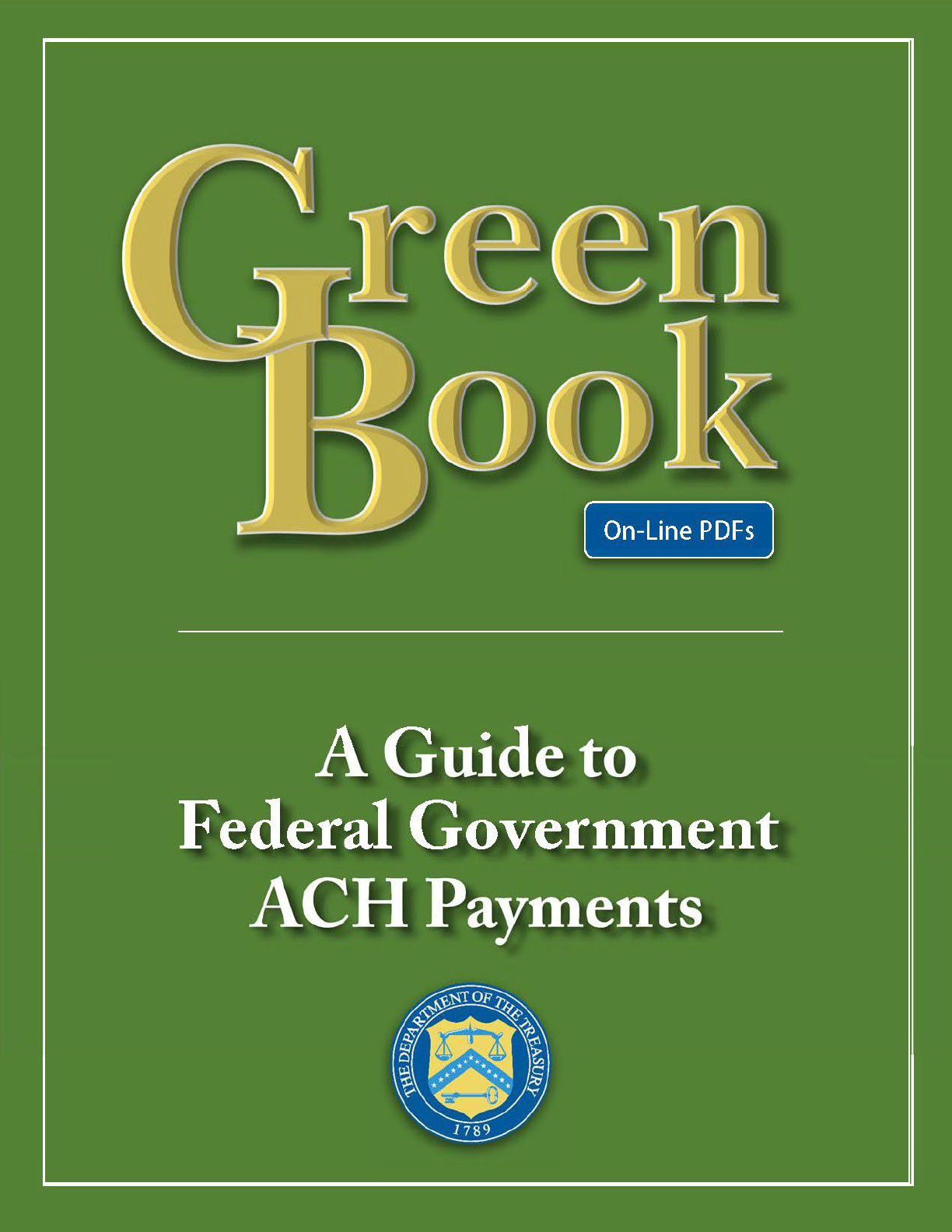
A Guide to
Federal Government
ACH Payments
On-Line

A Guide to Federal Government ACH Payments

Table of content
Green Book
II
A Guide to Federal Government ACH Payments
Introduction
Welcome to the Green Book — a comprehensive guide for financial institutions that receive
ACH payments from the federal government.
Today, most federal payments are made via the Automated Clearing House (ACH). With
very few exceptions, federal government ACH transactions continue to be subject to the
same rules as private industry ACH payments. As a result, the Green Book continues to get
smaller in size and is designed to deal primarily with exceptions or issues unique to federal
government operations.
Federal agency contact information is included, and since so much information is available
via the Internet, website addresses are included where appropriate. The Green Book
continues to be available on the Internet and chapters can be printed as Portable Display
Format (PDF) documents. We no longer print and mail hard copies. So, we encourage you
to visit the website for updates and news relevant to federal government ACH transactions.
Title 31 CFR part 210 provides the basis for most of the information contained in the Green
Book. However, there are other regulations that impact federal government ACH payments.
The following table summarizes the relevant regulations:
Regulation
Governs
31 CFR part 210
Federal Government Participation in the Automated Clearing House
31 CFR part 208
Management of Federal Agency Disbursements
31 CFR part 370
Electronic Transactions and Funds Transfers Relating to United
States Securities
We still occasionally get asked, “Why green?” It is simple. The first publication issued in
1975 dealing with the Direct Deposit of federal government payments, when the
ACH network was in its infancy, had a green cover. More than 45 years later, the world of
federal government payments has changed, but the Green Book is still green! We hope you
incorporate the Green Book into your daily operations and visit us frequently.
Department of the Treasury
Bureau of the Fiscal Service
January 2021

Table of Contents
Green Book
III
A Guide to Federal Government ACH Payments
Table of Contents
Chapters
Revised on
1. Enrollment
January 2023
2. ACH Payment Processing
January 2023
3. Non-Receipt Claims
January 2023
4. Returns
January 2023
5. Reclamations
January 2023
6. Notification of Change
January 2023
7. Contacts
January 2023
8. Glossary
January 2023
9. Forms
January 2023
Online Book Location:
https://www.fiscal.treasury.gov/fsreports/ref/greenBook/greenbook_home.htm
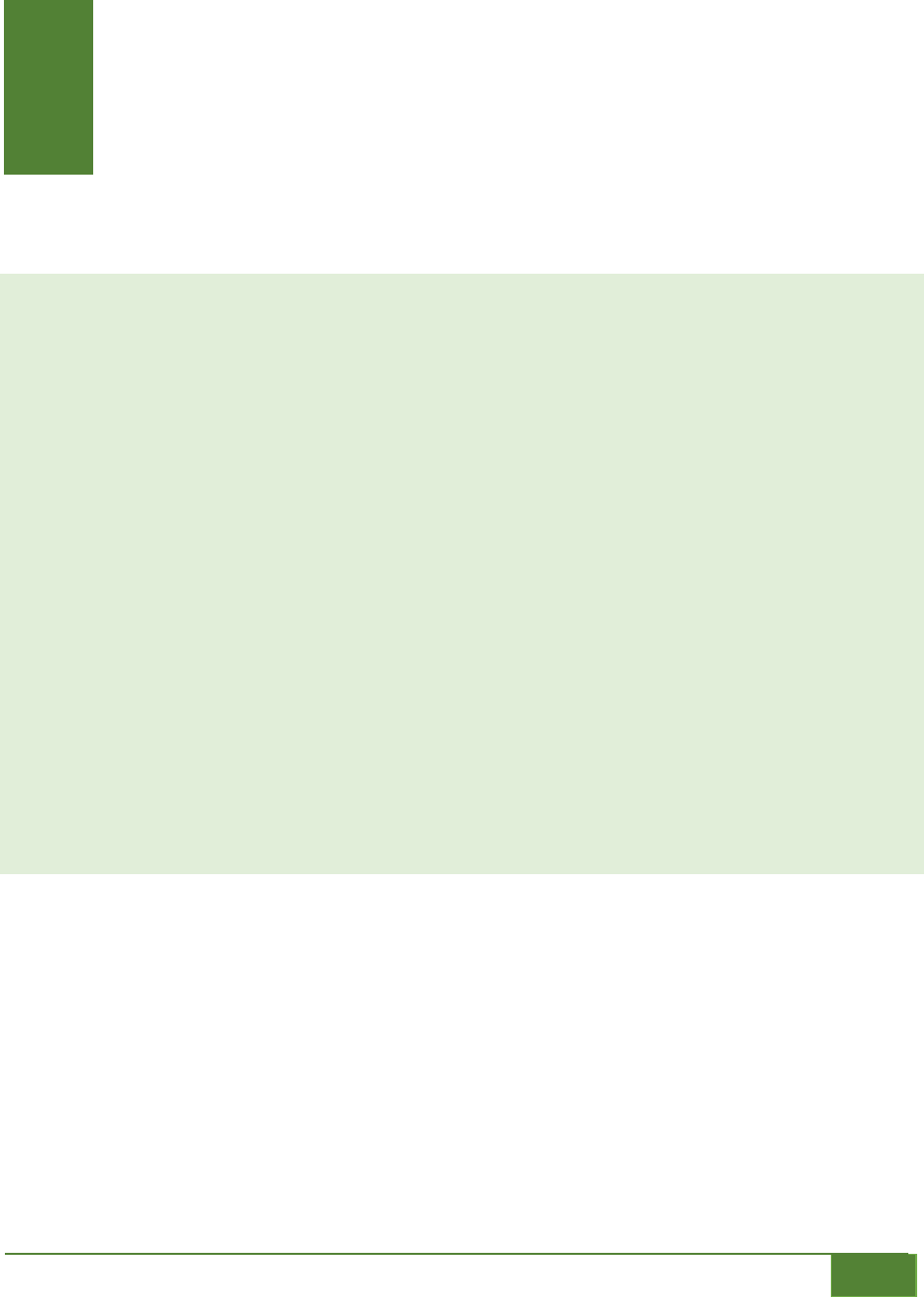
1-1
A Guide to Federal Government ACH Payments
Enrollment for
Federal Payments
Overview
In this chapter…
A: Automated Enrollment (ENR) ............................................................................................................... 1-4
Go Direct Online Enrollment Option for Financial Institutions ................................................................ 1-4
Social Security Administration (SSA) Payment Cycling .............................................................................. 1-4
B: Simplified Enrollment ............................................................................................................................. 1-5
Telephone Enrollment .............................................................................................................................................. 1-5
Paper Form Enrollment ........................................................................................................................................... 1-5
Enrollment Methods for Specific Payments ..................................................................................................... 1-5
1
Financial institutions can play a key role in assisting recipients of federal payments to enroll in
Direct Deposit with their paying agency. This chapter is a guide to the various enrollment methods
available for both consumer and corporate recipients.
There are several enrollment options:
1.
Enroll customers in lobby, batch and submit ENR enrollments through ACH from the financial
institution.
2.
Financial institution can enroll on the Go Direct® website to enter enrollments for customers.
3.
Financial institution can call the U.S. Treasury Electronic Payment Solution Center (EPSC) at
1-800-333-1795 for immediate enrollment of customers.
4.
Enrollment using Bureau of the Fiscal Service (Fiscal Service) Direct Deposit Sign-Up Form FS
Form 1200 for Social Security benefits or disability payments, Supplemental Security Income
payments, Railroad Retirement Board annuities, and Office of Personnel Management (OPM)
Civil Service annuities and Direct Deposit Sign Up Form FS Form 1199A for other federal
payments, or the ACH Vendor/Miscellaneous Payment Enrollment Form SF 3881 for corporate
vendor payments.
Errors in the Direct Deposit enrollment process are the primary cause of misdirected payments.
Financial institutions will be held liable for providing incorrect enrollment information and should,
therefore, carefully review all Direct Deposit enrollment procedures.

1-2
A Guide to Federal Government ACH Payments
1. Enrollment
Green Book
Allotments, Federal Salary, and Federal Employment Related Payments ........................................... 1-7
When Should Direct Deposit Begin Once It Has Been Initiated? ............................................................. 1-8
IRS Tax Refunds .......................................................................................................................................................... 1-8
Railroad Retirement Board ..................................................................................................................................... 1-9
Social Security Administration .............................................................................................................................. 1-9
Office of Personnel Management ......................................................................................................................... 1-9
TreasuryDirect (Bureau of the Fiscal Service) ..............................................................................................1-10
Simplified Enrollment for Series H/HH Savings Bond Interest Payments (Bureau of the Fiscal
Service) .........................................................................................................................................................................1-10
Department of Veterans Affairs Direct Deposit ............................................................................................1-10
C: Paper Enrollment Methods ................................................................................................................. 1-11
Fiscal Service Direct Deposit Sign-Up Form (FS Form 1200) .................................................................1-11
Direct Deposit Sign-Up Form (FS Form 1200) ..............................................................................................1-11
How to Complete the FS Form 1200 .................................................................................................................1-11
Federal Benefit Recipient Information ............................................................................................................1-12
Bank or Credit Union Information
.....................................................................................................................1-1
2
Type of Payment .......................................................................................................................................................1-12
SSA – Single Payee Example .................................................................................................................................1-14
SSA– Representative Payee Example................................................................................................................1-15
D: Direct Deposit Sign-Up Form (FS Form 1199A) .......................................................................... 1-16
How to Complete the FS Form 1199A ..............................................................................................................1-16
Section 1- To be completed by the payee ........................................................................................................1-16
Name of the Person(s) Entitled to Payment (Box B) ..................................................................................... 1-16
Claim or Payroll ID Number (Box C) .................................................................................................................... 1-16
Claim/Payroll ID Table ............................................................................................................................................... 1-17
Depositor Account Number (Box E) ...................................................................................................................... 1-17
Type of Payment (Box F) ............................................................................................................................................ 1-18
Payee/Joint Payee Certification (Box F) ............................................................................................................. 1-18
Joint Account Holders’ Certification (Optional) ............................................................................................... 1-18
When Using Witnesses ................................................................................................................................................ 1-18
Po
wer-of-Attorney ........................................................................................................................................................ 1-18
Section 2 - To Be Completed by the Payee or the Financial Institution ..............................................1-18
Section 3 - To Be Completed by the Financial Institution ........................................................................1-19
What Actions Should Take Place Before Filing the FS Form 1199A? ...................................................1-19
Important Information for New Direct Deposit Recipients .....................................................................1-19
How Are Forms Distributed? ...............................................................................................................................1-20
What to do if Direct Deposit does not begin ..................................................................................................1-20
FS Form 1199A Example .......................................................................................................................................1-21
E: Federal Financial EDI (FEDI) Payments/Vendor Payments .................................................... 1-22
Overview ......................................................................................................................................................................1-22
Delivery of Remittance (Addenda) Information ..........................................................................................1-22

1-3
A Guide to Federal Government ACH Payments
1. Enrollment
Green Book
Enrollment .................................................................................................................................................................. 1-22
Enrollment Checklist ............................................................................................................................................... 1-23
How to Complete the SF 3881 ............................................................................................................................. 1-23
Agency Information...................................................................................................................................................... 1-23
Payee/Company Information .................................................................................................................................. 1-23
Financial Institution Information .......................................................................................................................... 1-23
Form Distribution ......................................................................................................................................................... 1-24
Pointers for Completing the SF 3881 Form ................................................................................................... 1-24
F: Enrollment Guidance ............................................................................................................................. 1-24
ENR (Automated Enrollment) Entry Detail Record .................................................................................... 1-27
ENR Addenda Record .............................................................................................................................................. 1-27
Representative Payee ............................................................................................................................................. 1-28
Return Reason Codes .............................................................................................................................................. 1-28
ENR Tips and Information Checklist ................................................................................................................. 1-29
General Questions/Information: ............................................................................................................................. 1-29
Benefit Recipient Information ................................................................................................................................. 1-29
Information Needed for Direct Deposit Enrollment ...................................................................................... 1-30
Helpful Numbers and Websites ............................................................................................................................... 1-30
Federal Agency Addresses and Phone Numbers.......................................................................................... 1-31
G: Termination of Enrollment ................................................................................................................. 1-36
Termination by the Recipient .............................................................................................................................. 1-36
Courtesy Notice ......................................................................................................................................................... 1-36
Termination by the Financial Institution ........................................................................................................ 1-37
Recipient Notice to the Federal Agency ........................................................................................................... 1-37

1. Enrollment
Green Book
1-4
A Guide to Federal Government ACH Payments
A: Automated Enrollment (ENR)
ENR is a convenient method for financial institutions to use the ACH network to transmit Direct
Deposit enrollment information to federal agencies for benefit payments. An ENR entry is a non-
monetary entry sent through the ACH by any Receiving Depository Financial Institution (RDFI) to a
federal government benefit agency participating in the ENR program.
ENR is the enrollment method preferred by participating federal benefit agencies. The ENR reduces
errors in the enrollment process and may expedite delivery of Direct Deposit payments as
compared to paper enrollment methods.
An ENR should be used when the recipient is requesting to initiate direct deposit for their federal
benefits. This may include, but is not limited to a first-time sign-up for Direct Deposit, a change to
an existing Direct Deposit enrollment (e.g. new bank account number) with the current financial
institution, or a change from one financial institution to another new financial institution.
Enrollments received and accepted by the paying agency at least 10 business days prior to the
benefit recipient’s next scheduled payment date will generally allow the recipient’s next month’s
payment by Direct Deposit.
To change financial institution data for an existing Direct Deposit enrollment within a financial
institution where an authorization exists, a Standard Entry Code (COR) entry, commonly known as
a Notification of Change (NOC), may be used. (Refer to Chapter 6 for more information on NOCs.)
Go Direct Online Enrollment Option for Financial Institutions
In addition to the Automated ENR option, financial Institutions can also choose to take advantage of
enrollment via the Go Direct w
ebsite. The Go Direct campaign was a national marketing and public
education campaign sponsored by the U.S. Department of the Treasury, Bureau of the Fiscal Service
and the Federal Reserve System that increased the use of Direct Deposit for federal benefit check
recipients. Although the Go Direct campaign has officially concluded, financial institutions can
continue to utilize the enrollment website. Please review the Go Direct Reference Guide for
Financial Institutions and Corporations for more details.
Enrollments submitted through the Go Direct enrollment site will be validated and submitted to the
respective paying agencies by the Electronic Payment Solutions Center (EPSC). The U.S. Treasury
EPSC is operated in a secure Federal Reserve site. Financial Institution customers whose
enrollments cannot be verified or processed will be contacted by the U.S. Treasury Electronic
Payment Solutions Center via letter delivered by USPS.
All reject or return item processing for these items is handled by the Operations and Research
Division of the EPSC. Financial institutions electing to submit enrollments electronically through Go
Direct are relieved of the obligation of processing ENR return items.
Social Security Administration (SSA) Payment Cycling
The payment date for newly enrolled Social Security beneficiaries is either the second, third, or
fourth Wednesday of the month. These additional payment days alleviate the workload peaks for
SSA, Fiscal Service, and financial and business communities.

1. Enrollment
Green Book
A Guide to Federal Government ACH Payments
1-5
However, in instances where the beneficiary receives both Social Security benefit or disability
payments and Supplemental Security Income (SSI) payments, the payments are issued on the
standard 1st and 3rd schedule.
B: Simplified Enrollment
There are a variety of ways for federal payment recipients to enroll for Direct Deposit without
visiting a financial institution.
Telephone Enrollment
Federal benefit recipients can be enrolled by calling the U.S. Treasury Electronic Payment Solution
Center at 1-800-333-1795, by visiting the Go Direct w
ebsite, or by completing Fiscal Service Direct
Deposit Sign-Up Form FS Form 1200. The U.S. Treasury Electronic Payment Solution Center hours
of operation are 8:00 a.m. - 8:00 p.m. Eastern Time (ET), Monday through Friday, excluding federal
holidays.
Financial institution representatives can also assist their recipients who wish to enroll by phone.
H
owever, when doing so, the benefit recipient - or their representative - must be present when the
phone call is made. U.S. Treasury Electronic Payment Solutions Center personnel will ask to speak
to the recipient or their representative and obtain approval for the 3rd party banking
representative to provide their enrollment information. Financial institutions that elect to capture
enrollment information on paper or through other means and process after hours or in a back-
office environment may not use U.S. Treasury Electronic Payment Solutions Center telephone
enrollment on behalf of their customer.
Paper Form Enrollment
Recipients who elect to complete Fiscal Service paper Form FS 1200 should complete it on their
own or with the assistance of a financial Institution representative for the Routing Transit Numbers
(RTN) and account number and mail to:
U.S. Treasury Electronic Payment Solution Center
P.O. Box 650527
Dallas, Texas 75265-0527
The table below shows the Simplified Enrollment procedures for specific payment types.
Enrollment Methods for Specific Payments
Payment Type Recipient
Allotments
Federal Salary
Federal Employment-
Related Payments (i.e.,
Travel Reimbursement,
Uniform Allowance, etc.)
Completes an approved form at their federal agency personnel
office (e.g., FS Form 2231, FastStart Direct Deposit). Some federal
employees are able to make changes to Direct Deposit information
via telephone using Employee Express.
Recipients should contact their servicing personnel office for more
information.
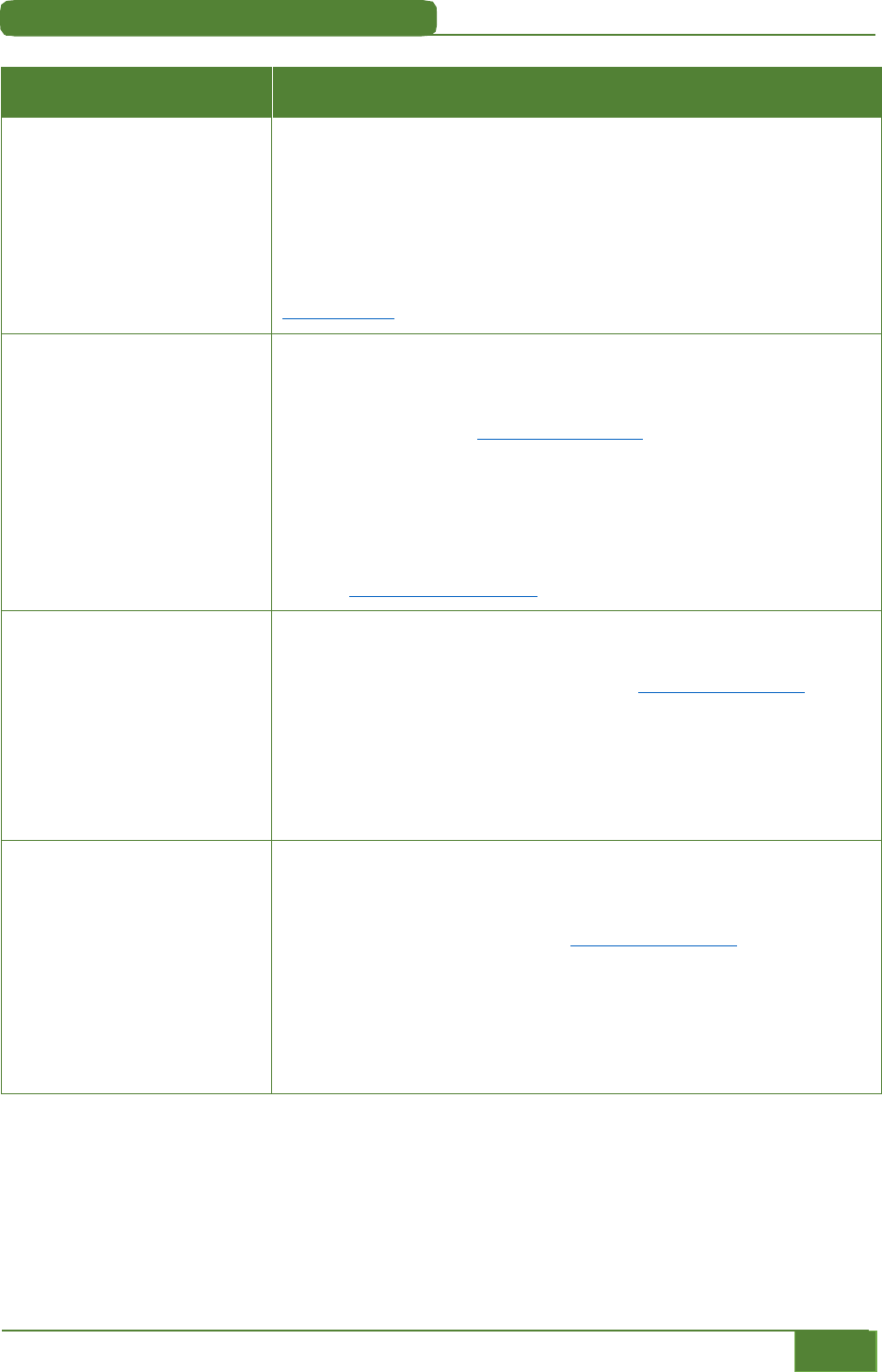
1. Enrollment
Green Book
1-6
A Guide to Federal Government ACH Payments
Payment Type Recipient
IRS Tax Refunds Completes the financial institution information section of the IRS
Form 1040 during tax preparation.
For paper filing completes a U.S. Individual Income Tax
Declaration (IRS Form 8453). For electronic filing via IRS e-file
completes an 8453-OL.
Recipients should contact the IRS at 1-800-829-1040 or visit
www.irs.gov
f
or more details.
Office of Personnel
Management (OPM)
Form
Note: OPM does not allow
ENR enrollments for
representative payees.
Financial institutions can enroll their customers or recipients can
enroll individually by calling the U.S. Treasury Electronic Payment
Solution Center at 1-800- 333-1795 (English) / 1-800-333-1792
(Spanish), by visiting www.GoDirect.gov, or
by completing FS
Form 1200. The U.S. Treasury Electronic Payment Solution Center
hours of operation are 8:00 am - 8:00 pm ET, Monday through
Friday, excluding federal holidays.
Additionally, Financial Institutions a
nd/or recipients can call OPM
at 1-888-767-6738 or 202-606-0500 in the Washington, DC area
or visit www.opm.gov/retire f
or details.
Railroad Retirement Board
(RRB)
Financial institutions can enroll their customers and/or recipients
can enroll individually by calling 1-800- 333-1795 (English)/ 1-
800-333-1792 (Spanish), or by visiting www.GoDirect.gov,
completing FS Form 1200. The U.S. Treasury Electronic Payment
Solution Center hours of operation are 8:00 a.m. - 8:00 p.m. ET,
Monday through Friday, excluding federal holidays.
Additionally, f
inancial institutions and/or recipients can contact
RRB’s toll-free telephone number at 1-877-772-5772.
Social Security (SSA) and
Supplemental Security
Income (SSI)
Financial institutions can enroll their customers and/or recipients
can enroll individually by calling the U.S. Treasury Electronic
Payment Solution Center at 1-800- 333-1795 (English)/ 1-800-
333-1792 (Spanish), by visiting www.GoDirect.gov, or
by
completing FS Form 1200. The U.S. Treasury Electronic Payment
Solution Center hours of operation are 8:00 a.m. - 8:00 p.m. ET,
Monday through Friday, excluding federal holidays.
Additionally, f
inancial institutions and/or recipients can enroll by
contacting the SSA at 1-800-SSA-1213 (1-800-772-1213).

1. Enrollment
Green Book
A Guide to Federal Government ACH Payments
1-7
Payment Type Recipient
Bureau of the Fiscal Service
TreasuryDirect
Recipient is automatically enrolled in the TreasuryDirect account
for purchasing Treasury bills, notes, and bonds. Investors use
Form PD F 5182, New Account Request, to establish a
TreasuryDirect account and to provide Direct Deposit information.
Investors use Form PD F 5178, Transaction Request, to change
Direct Deposit information.
Recipients should contact a designated TreasuryDirect Servicing
Office or visit www.treasurydirect.gov
f
or forms and other
information.
Vendor/Misc. The ACH Vendor/Miscellaneous Payment Enrollment Form (SF
3881) is an optional three-part form that federal agencies may use
to enroll their vendors in the Financial Electronic Data
Interchange (FEDI) program.
Recipients should contact the federal agency they are providing
goods or services to for more information.
Veterans Compensation and
Pension
Note: VA does not allow ENR
enrollments for
representative payees.
Financial institutions can enroll their customers and/or recipients
can enroll individually by calling 1-800- 333-1795 (English)/ 1-
800-333-1792 (Spanish), or by visiting www.GoDirect.gov, or b
y
c
ompleting FS Form 1200. The U.S. Treasury Electronic Payment
Solution Center hours of operation are 8:00 a.m. - 8:00 p.m. E
T,
Mond
ay through Friday, excluding federal holidays.
Recipients can also contact the VA National Direct Deposit EFT
line at 1-800-827-1000 or visit www.benefits.va.gov/benefits
f
or
further details.
Veterans Education
Note: VA does not allow ENR
enrollments for
representative payees.
Enrolls at the same time recipient applies for benefits at the VA or
at any time after recipient begins receiving benefits. Recipients
already receiving benefits should contact the VA Education Direct
Deposit EFT line at 1-888-442-4551.
Veterans Life Insurance
Note: VA does not allow ENR
enrollments for
representative payees.
Enrolls at the same time recipient applies for benefits at the VA or
at any time after recipient begins receiving benefits.
Recipients should contact the VA Insurance office at 1-800-669-
8477 or visit www.insurance.va.gov f
or further details.
Allotments, Federal Salary, and Federal Employment Related Payments
Current federal employees can complete an approved form at their agency personnel office, or
servicing pay office. This form may be a FS Form 1199A (Direct Deposit Sign Up), a FS Form 2231
(FastStart Direct Deposit Sign Up), or a similar form used by the employee’s agency. The Direct
Deposit payments may be for federal salaries, allotments, or for employment related payments for
travel reimbursement or uniform allowance.

1. Enrollment
Green Book
1-8
A Guide to Federal Government ACH Payments
When Should Direct Deposit Begin Once It Has Been Initiated?
Use the table below to determine when Direct Deposit should begin once the enrollment form is
forwarded to the federal agency.
IF the payment type is... THEN Direct Deposit should begin within...
Federal salary
Military civilian pay
Military active duty Allotments
2-3 pay periods
Military retirement/annuity
60-90 days
D
etails of Each Payment Type
IRS Tax Refunds
The Internal Revenue Service (IRS) offers the Direct Deposit of IRS Form 1040 tax refunds for both
paper and electronically filed returns.
For IRS Form 1040 paper returns, taxpayers receiving refunds and electing Direct Deposit simply
complete the financial institution information section of the form and mail the form to the IRS.
For electronically filed returns using an authorized IRS e-file provider, the taxpayer will complete a
U.S. Individual Income Tax Declaration for Electronic Filing (IRS Form 8453) for refunds by Direct
Deposit. This form authorizes the tax preparer to transmit the return and allows the choice of
having the refund deposited into a checking or savings account.
Taxpayers preparing returns on a personal computer using commercial tax preparation software or
the IRS Free Online Filing and transmitting the information via the internet to the IRS complete
Form 8453-OL, U.S. Individual Income Tax Declaration for On-Line Filing. This form allows the
taxpayer to choose Direct Deposit for the refund. The financial institution will not receive copies of
these forms.
The financial institution should be aware of the following:
1.
Enrollment in Direct Deposit for an income tax refund is not a permanent election by the
taxpayer. Taxpayers must elect Direct Deposit each filing year.
2.
Payments must be returned when they cannot be properly posted by the financial institution.
NOCs cannot be used to correct any information. In the instance where a Direct Deposit IRS tax
refund is unpostable and returned, taxpayers will receive a check in place of a Direct Deposit
payment.
3.
The financial institution’s responsibility is to post the Direct Deposit payment to the account
indicated on the ACH record. If the funds are posted to a valid account that turns out to be
incorrect, the financial institution is not liable to the government for the return of the funds. If the
taxpayer or the taxpayer’s agent gave the incorrect account information, neither Fiscal Service
nor the IRS will assist the taxpayer with recovering the funds. The taxpayer is free to pursue civil
action. If, however, the IRS made the error, it will make the taxpayer whole.
For further information, contact the IRS at 1-800-829-1040; contact the local IRS District Office, or
visit www.irs.gov.

1. Enrollment
Green Book
A Guide to Federal Government ACH Payments
1-9
For IRS tax refund status, the recipient should go to www.irs.gov and select “Get Your Refund
Status.”
Railroad Retirement Board
Financial institutions can enroll their customers and/or recipients can enroll individually by:
1.
Calling the U.S. Treasury Electronic Payment Solution Center at 1-800-333-1795 (English)/1-
800-333-1792 (Spanish), or by visiting the Go Direct w
ebsite, or by completing FS Form 1200.
The call center hours of operation are 8:00 a.m. - 8:00 p.m. ET, Monday through Friday,
excluding federal holidays, or
2.
Calling the Railroad Retirement Board at 1-877-772-5772, or
3.
Sending a written request to enroll in Direct Deposit to the local Railroad Retirement Board
field office. The letter should include the recipient’s name and the following:
A: Account Number,
B: Account type (checking or savings), and
C: RTN of the financial institution.
Social Security Administration
Financial institutions can enroll their customers and/or recipients can enroll individually by calling
the U.S. Treasury Electronic Payment Solution Center at 1-800- 333-1795 (English)/ 1-800-333-
1792 (Spanish), or by visiting the Go Direct w
ebsite, or by completing FS Form 1200. The U.S.
Treasury Electronic Payment Solution Center hours of operation are 8:00 a.m. - 8:00 p.m. ET,
Monday through Friday, excluding federal holidays.
The financial institution may make the call on behalf of the recipient and may provide the
e
nrollment information; however, SSA will request to speak to the recipient to verify their identity.
Recipients who already are receiving Social Security and SSI benefits by check may also enroll in
Direct Deposit by calling 1-800-SSA-1213 (1-800-772-1213).
SSA’s toll-free telephone service is available from 7:00 a.m. to 7:00 p.m. ET, Monday through Friday.
Due to the high volume of calls, the best times to telephone are in the early morning and during the
latter parts of the week and month.
Office of Personnel Management
Financial institutions can enroll their customers or recipients can enroll individually by calling the
U.S. Treasury Electronic Payment Solution Center at 1-800- 333-1795 (English)/ 1-800-333-1792
(Spanish), by visiting the Go Direct w
ebsite, or by completing FS Form 1200. The U.S. Treasury
Electronic Payment Solution Center hours of operation are 8:00 a.m. - 8:00 p.m. ET, Monday
through Friday, excluding federal holidays.
Additiona
lly, new retirees, annuitants, and survivor annuitants may enroll in Direct Deposit by
calling the toll-free customer service number at 1-888-767-6378. Those in the Washington, DC
area are encouraged to call 202-606-0500. Recipients may also visit www.opm.gov/retire f
or
instructions on how to change their payment address on-line.
Note: T
he Office of Personnel Management does not allow ENR enrollments for representative payees.

1. Enrollment
Green Book
1-10
A Guide to Federal Government ACH Payments
TreasuryDirect (Bureau of the Fiscal Service)
TreasuryDirect is a book-entry securities system in which investors’ accounts of book-entry
Treasury marketable securities are maintained. TreasuryDirect is designed for investors who
purchase Treasury securities and intend to hold them until maturity. Investors can establish a
TreasuryDirect account and hold all their bills, notes, and bonds in one TreasuryDirect account
showing the same ownership for all their securities, or they can establish multiple accounts
reflecting different ownership. Investors will receive a TreasuryDirect Statement of Account when
they open a new account, when changes are made to the account, upon request, or if they have not
received one during the calendar year.
TreasuryDirect principal and interest payments are made electronically by Direct Deposit to a
checking or savings account at a financial institution designated by the investor. When establishing
a TreasuryDirect account, investors will complete Form PDF 5182, New Account Request, and will
include Direct Deposit information. Investors are not required to fill out an FS Form 1199A.
Investors can also establish an account when they complete Form PDF 5381, Treasury Bill, Note &
Bond Tender to purchase a security. Investors use Form PDF 5178, Transaction Request, to change
Direct Deposit information for the TreasuryDirect account. Financial institutions may be asked by
customers to furnish the account number, routing transit number, account type, and/or the
financial institution’s name. The investor should contact a designated TreasuryDirect Servicing
Office or visit the TreasuryDirect
w
ebsite for forms and other information.
Simplified Enrollment for Series H/HH Savings Bond Interest Payments
(Bureau of the Fiscal Service)
Series H/HH savings bonds are current income securities that pay interest semiannually. Interest
on bonds issued since October 1989 to the present must be paid by Direct Deposit. Unless a
recipient claims that it will cause a hardship, interest on bonds issued prior to October 1989 must
also be paid by Direct Deposit.
To enroll in Direct Deposit or to change their enrollment, recipients may:
1.
Download PDF 5396 from the TreasuryDirect website, complete and mail the form as instructed,
or
Send a letter to the T
reasury Retail Securities Services, P.O. Box 9150, Minneapolis, MN 55480-9150. The
letter should include the following:
A.
Recipient’s name,
B.
Social Security number,
C.
Account number,
D.
Account type (checking or savings), and
E.
RTN number of the financial institution.
Department of Veterans Affairs Direct Deposit
Veterans Compensation and Pension, and Vocational Rehabilitation and Employment recipients
already receiving benefits may enroll in Direct Deposit by calling 1-800-827-1000. Compensation

1. Enrollment
Green Book
A Guide to Federal Government ACH Payments
1-11
and Pension Beneficiaries may also enroll in Direct Deposit through VA’s eBenefits self-service
portal (www.ebenefits.va.gov/ebenefits).
VA Education recipients already receiving benefits may enroll in Direct Deposit by calling 1-888-
442-4551.
New VA benefits recipients should provide Direct Deposit information at the time of application.
Recipients of VA benefits may also enroll by submitting VA Form 24-0296 (Direct Deposit
Enrollment) and mailing it to the Station of Jurisdiction over the claim. To locate the Station of
Jurisdiction over the claim, visit http://www.benefits.va.gov/benefits/offices.asp.
Veterans Life Insurance recipients may enroll in Direct Deposit by calling 1-800-669-8477. A
Direct Deposit enrollment form and further details are also available by visiting
www.insurance.va.gov or
by writing to:
VAROIC – DD
P.O. Box 7208
Philadelphia, PA 19101-7208
New recipients should provide Direct Deposit information at the time of application.
Note: The Department of Veterans Affairs does not allow ENR enrollments for representative payees.
C: Paper Enrollment Methods
Fiscal Service Direct Deposit Sign-Up Form (FS Form 1200)
The table below identifies those agencies and payment types where the FS Form 1200 is the proper
form to use, in situations when a paper enrollment is needed:
Agency I Payment Type
Recipient
Social Security Administration
and
• Social Security
• Supplemental Security Income
Recipients should complete Fiscal Service FS Form
1200. Send completed form to:
U.S. Treasury Electronic Payment Solution Center
P.O. Box 650527
Dallas, TX 75265-0527
Office of Personnel Management
and
• Annuity
• Retirement Annuity or Survivor Annuity
Railroad Retirement Board
and
• Railroad Retirement Annuity Benefit
• Railroad Retirement
Unemployment/Sickness
Direct Deposit Sign-Up Form (FS Form 1200)
The Direct Deposit Sign-Up Form (FS Form 1200) is available in Chapter 9, Forms.
How to Complete the FS Form 1200
Payee must complete boxes A, B, C, D, E, and F.
Clearly print all information. Provide name(s) and address exactly as they appear on the federal
benefit recipient’s benefit check.

1. Enrollment
Green Book
1-12
A Guide to Federal Government ACH Payments
Federal Benefit Recipient Information
Name of person entitled to government benefits (beneficiary).
If there is more than one person named on the check, such as a parent and a minor child, this will be
the name of the minor child.
Representative Payee? Check appropriate box Yes or No.
If yes, enter Name of Representative Payee.
A representative payee is a person or institution that is legally entitled to receive payments on behalf
of a beneficiary who has been deemed incapable of handing their own financial affairs. When a
representative payee is present, both names will appear on the benefit check. Minor children receiving
federal benefits should always have a representative payee. An example of a representative check
payee is Mary Smith for Jane R. Doe.
Provide name(s) and address exactly as they appear on the most recent benefit check.
Social Security Number (SSN) of persons entitled to government benefits (beneficiary). If the
benefits are for a minor child, this will be the child’s SSN. This is never the representative payee’s
SSN.
Daytime Telephone Number of the person to contact if there are questions regarding the
enrollment information provided on the form.
Bank or Credit Union Information
Depositor’s account title must include the name of the person authorized to receive the payment,
(e.g. representative payee if applicable), and an account type (either Checking or Savings).
The 9-digit routing number is a 9-digit number used to denote which financial institution will
receive the deposit.
Account Numbers may be up to 17 characters long. It may contain both numeric 0-9 and alphabetic
characters A to Z.
Type of Payment
(check only one box)
The a
ppropriate box should be checked. Refer to the examples that follow to determine how to
identify the appropriate payment type
Note: You must use a separate form for each payment type or individual that is being enrolled.
For payment types not listed on the FS Form 1200 please refer to the next section, Direct Deposit
Sign-up Form (FS Form 1199A) for instruction on submitting enrollments for other payment types.
Either a claim number or check number is required.
Claim number is an identifying number assigned by the paying agency to the benefit recipient. In many
cases, this is the SSN the benefits are drawn upon followed by a series of letters or letters and numbers.
For some agencies this may be a unique number that does not use the SSN. Claim numbers can
typically be found on award letters issued by the paying agency, correspondence sent by the agency, or
year-end tax statements.
Check number is the 12-digit check number of the recipient’s most recent benefit payment.

1. Enrollment
Green Book
A Guide to Federal Government ACH Payments
1-13
The check number is located in the upper right-hand corner of the check. It is formatted as 4-digits a
space and then 8-digits. (example: 2053 87654321)
Dollar amount of most recent benefit payment is required.
When Us
ing Witnesses
When witnesses are used, they should sign to the right of the mark “X” and print the word
“Witness” above their signature.
Power-of-A
ttorney
A person appointed as a power-of-attorney cannot sign the FS Form 1200 for the payee. The FS
Form 1200 can only be signed by the designated recipient or a representative payee. Questions
regarding this item should be directed to the appropriate federal agency.
Agency I Payment Type
Recipient
Federal Housing Administration
Debentures (Fiscal Service)
The Federal Housing Administration (FHA) issues these
debentures in settlement of defaulted mortgages. For more
information, recipients should contact Housing and Urban
Development at (202) 708- 3423, or write to:
HUD
451 7th Street, SW
Washington, DC 20410
Attn: multi-family or single-family claims
Series H/HH Savings Bond
Interest Payments (Fiscal
Service)
Completes PD F 5396. Recipients should visit the
TreasuryDirect website to download the form or contact:
Bureau of the Fiscal Service
Treasury Retail Securities Services
P.O. Box 9150
Minneapolis, MN 55480-9150
Note: Only send completed FS Form 1199A forms to the federal agency responsible for issuing the
payment. The U.S. Treasury Electronic Payment Solution Center is unable to process the FS Form
1199A form and will be forced to reject them.
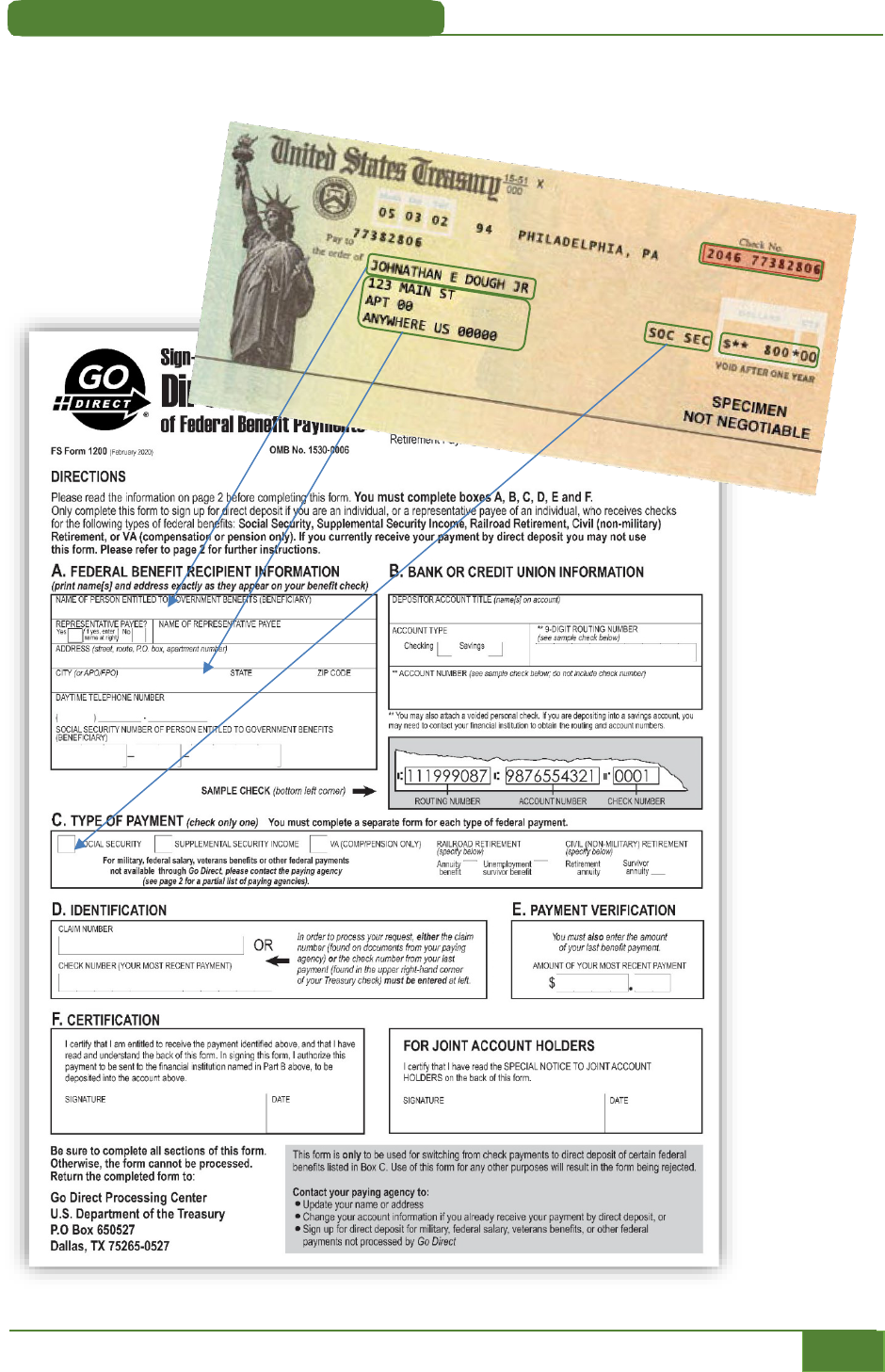
1. Enrollment
Green Book
1-14
A Guide to Federal Government ACH Payments
SSA – Single Payee Example
Example 1:
Social Security
Administration
Single Payee

1. Enrollment
Green Book
A Guide to Federal Government ACH Payments
1-15
SSA– Representative Payee Example
Example 2:
Social Security
Administration
Representative
Payee

1. Enrollment
Green Book
1-16
A Guide to Federal Government ACH Payments
D: Direct Deposit Sign-Up Form (FS Form 1199A)
A Direct Deposit Sign-Up Form (FS Form 1199A) is available in Chapter 9, Forms.
How to Complete the FS Form 1199A
Section 1- To be completed by the payee
The financial institution should verify that all information on this portion of the form is correct.
The financial institution needs to be aware of the following special items:
Name of the Person(s) Entitled to Payment (Box B)
This will be the name of the payee. Refer to the appropriate federal agency examples to determine
what information to enter for recurring benefit payments.
Claim or Payroll ID Number (Box C)
Claim numbers may be found on documents provided by the recipient’s paying agency(s) such as:
award letters, yearly tax statements, or general correspondence.
Claim Number Prefix
A claim number prefix is one or more letters preceding the claim number. These characters indicate
the type of claim for which benefits are being paid. For an explanation of the meaning of a prefix,
contact the federal agency authorizing the payment.
Claim Number
A claim number identifies the recipient’s records at the federal agency that authorizes the payment.
Claim Number Suffix
A claim number suffix is one or more characters (letters or numbers) following a claim number.
These characters indicate the payment type or the payee’s relationship to the individual who the
benefits are being drawn. For a full explanation of a suffix, contact the federal agency authorizing
the payment.
Example:
VA Compensation, Pension and Education. .123-45-6789 00

1. Enrollment
Green Book
A Guide to Federal Government ACH Payments
1-17
Claim/Payroll ID Table
The table below highlights what to enter on the FS Form 1199A for the Claim or Payroll ID Number
(BOX C) for the various payment types.
Payment Type Prefix Claim Number Suffix
Allotments (Savings and
Discretionary)
Leave Blank
SSN or Payroll ID Number
Leave Blank
Black Lung
(Department of Labor)
Leave Blank
SSN
2 characters
following the SSN
Central Intelligence Agency
/Annuity
Leave Blank
SSN
Leave Blank
Federal Employee
Workers’ Compensation
(Department of Labor)
Leave Blank
Case number assigned by
the federal agency
Leave Blank
Federal Salary/Military
Civilian Pay
Leave Blank
SSN or Payroll ID Number
Leave Blank
Longshore and Harbor
Workers’ Compensation
(Department of Labor)
Leave Blank
File number assigned by
the federal agency
Leave Blank
Military Active Duty and
Allotments
Leave Blank
SSN
Leave Blank
Military Retirement and
Annuity
Leave Blank
SSN
Leave Blank
Miner’s Benefit
(Department of Labor)
Leave Blank
SSN
Leave Blank
Savings Bond Agency’s Fee
(Fiscal Service)
Leave Blank
Issuing or paying agency
code assigned to the
financial institution
1- or 2-digit number
following the SSN
Series H/HH Savings Bond
Interest Payments (Fiscal
Service)
Leave Blank
SSN
Leave Blank
Veterans Compensation,
Pension or Education
Leave Blank
8-digit or 9-digit SSN
Always a 2-digit
number
Veterans Life Insurance
1 to 2 letters
4- to 8-digit number
None or a 2-digit
number
Depositor Account Number (Box E)
•
If account numbers are not used, then insert name or other identification in the box.
•
Use only letters A-Z and digits 0-9
•
Up to 17 characters

1. Enrollment
Green Book
1-18
A Guide to Federal Government ACH Payments
Type of Payment (Box F)
The appropriate box should be checked
If payment type is not included in the list, then check “Other” and enter the payment type in the
blank.
For military payments, enter the name of the military branch in the blank next to the payment type
checked.
Payee/Joint Payee Certification (Box F)
IF...
THEN...
there is only one payee, who could be a
representative payee*
only the payee signature is required
joint payees complete the form
both must sign the form
the payee’s signature is made be a mark “X”
it must be witnessed by two persons who sign and
date the form.
* See Glossary, Chapter 8
Joint Account Holders’ Certification (Optional)
Federal agencies do not require signatures in this block; however, some financial institutions do.
If the signature is made by a mark “X”, it must be witnessed by two persons who sign and date the
form.
When Using Witnesses
When witnesses are used, they should sign to the right of the mark “X” and print the word
“Witness” above their signature.
Power-of-Attorney
A person appointed as a power-of-attorney by the court cannot sign the FS Form 1199A for the
payee. The FS Form 1199A can only be signed by the designated recipient or a representative
payee. Questions regarding this item should be directed to the appropriate federal agency.
Section 2 - To Be Completed by the Payee or the Financial Institution
The financial institution should verify that the name and address of the federal agency that
authorized the payment is used.
For a listing of addresses, refer to Chapter 7, Contacts.
Note: Do not send enrollment forms to Fiscal Service. Fiscal Service does not process enrollment forms
except for its own employees.

1. Enrollment
Green Book
A Guide to Federal Government ACH Payments
1-19
Section 3 - To Be Completed by the Financial Institution
ENTER the...
•
financial institution’s name and address
•
financial institution’s routing number
•
depositor’s account title
(this title must include the name of the person authorized to receive the payment)
•
financial institution representative’s name, signature, telephone number, and current date.
What Actions Should Take Place Before Filing the FS Form 1199A?
This checklist can be used to verify that all information entered on the enrollment form is complete
and accurate.
❑
Name of person(s) entitled to payment*
❑
Claim or payroll ID table*
❑
Type of depositor account
❑
Account number
❑
Type of payment
❑
Proper signatures
❑
Federal agency name and address*
❑
Name and address of financial institution
❑
RTN and check digit
❑
Depositor account title*
Make sure it includes the name of the person authorized to receive the payment
Note: Make sure the federal agency that authorizes the payment is entered, not the Fiscal Service.
Note: Items marked with an asterisk (*) are where most errors occur.
Important Information for New Direct Deposit Recipients
1.
The financial institution should inform the recipient that they will continue to receive checks or
deposits at their current payment address of record until the Direct Deposit enrollment is
processed.
2.
The financial institution should inform the recipient on how to verify receipt of a Direct Deposit
payment.
3.
The financial institution should inform the recipient to notify the federal agency of any address
changes after Direct Deposit begins, since important information about the payment will be sent
to the individual’s home address.
4.
The financial institution should inform the recipient that it is important to notify both the federal
agency and the financial institution if the recipient or beneficiary dies or becomes legally
incapacitated. (Legal Incapacity is defined as a legal declaration that an individual is unable to
m
anage his/her affairs properly)

1. Enrollment
Green Book
1-20
A Guide to Federal Government ACH Payments
5.
The financial institution should inform the recipient that if they change financial institutions, the
old account should not be closed until Direct Deposit begins into the new account. Make sure the
recipient understands that changing financial institutions requires filling out a new Direct
Deposit enrollment.
How Are Forms Distributed?
Government Agency Copy
Delivered by the employee to the federal agency that authorizes the payment.
Financial Institution Copy
Held by the financial institution
There is no official retention period for the FS Form 1199A. It is recommended that financial institutions
retain this form at least until receipt of the first payment.
Payee(s) Copy
Held by the recipient.
What to do if Direct Deposit does not begin
Follow these steps if Direct Deposit does not begin within the specified time period.
1
Ask recipient if the enrollment authorization has been revoked.
If yes, no further action is required.
If no, and Direct Deposit is still desired, go to Step 2.
2
Make a copy of the completed enrollment form from the financial institution’s file copy.
Note: Verify that all the information on the form is correct.
3
Send a copy of the form and a letter stating that the recipient still wants to receive Direct
Deposit to the federal agency that authorizes the payment.
4
Remind recipient(s) that checks will continue to be sent to their home address of record until
Direct Deposit begins.
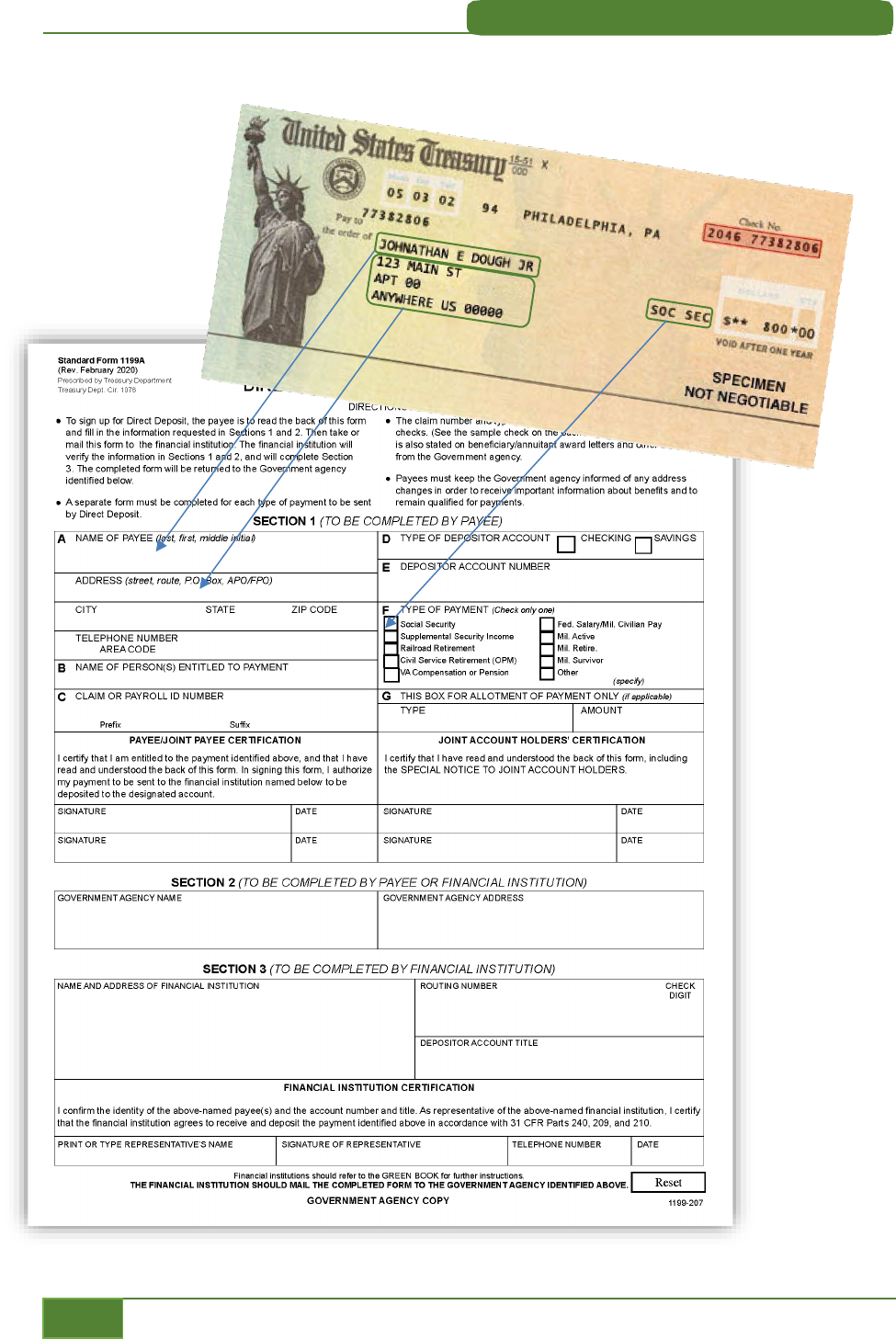
1. Enrollment
Green Book
A Guide to Federal Government ACH Payments
1-21
FS Form 1199A Example
Example 1:
Social Security
Administration
Single Payee

1. Enrollment
Green Book
1-22
A Guide to Federal Government ACH Payments
E: Federal Financial EDI (FEDI) Payments/Vendor Payments
Overview
Federal payments made using Financial Electronic Data Interchange (FEDI), the electronic transfer
of funds and payment-related information. The federal government uses FEDI for payments it
makes to businesses, which provide goods and services to federal agencies, and other payment
recipients.
Provisions of the Debt Collection Improvement Act of 1996 require that the majority of federal
payments be made by Electronic Funds Transfer (EFT). These payments include corporate
payments to companies providing goods or services to the federal government. This requirement
impacts every federal government vendor regardless of the size of the company or the goods or
services provided.
The federal government currently uses the two Nacha corporate payment formats for vendor
payments. These formats are:
•
CCD+ for single invoice payments. Contains one optional 80-character addenda record for
transmitting the invoice information.
•
CTX for single or multiple payments. Allows for 9,999 optional addends records, each carrying
80-characters, for the consolidation of multiple invoices in one payment.
Delivery of Remittance (Addenda) Information
The Nacha Operating Rules & Guidelines address the delivery of remittance information contained
in the addenda record. At the recipient’s request, financial institutions must provide the remittance
information by the opening of business on the second banking day following the settlement date of
the entry. This impacts all financial institutions processing ACH payments. The remittance
information may be provided via a paper report, fax, e-mail, electronic transmission, or any other
means negotiated between the recipient and the financial institution.
To perform this key role, it is imperative that the financial institution work closely with its
corporate customers who may have business relationships with the federal government. The
following issues should be discussed with your corporate customers:
•
How to deliver the remittance information to the customer,
•
When to deliver the remittance information to the customer,
•
What specific information to provide to the customer, and
•
What fees, if any, are associated with this service.
Enrollment
The ACH Vendor/Miscellaneous Payment Enrollment Form (SF 3881) is an optional three-part
form that federal agencies may use to enroll their vendors in the FEDI program. Federal agencies
will stock the form and provide the form to vendors to initiate the enrollment process. Federal
agencies will discuss with the vendor the ACH payment format (CCD+ or CTX) to be used to
transmit the payment. They will also work with the vendor to determine the remittance
information (e.g., the invoice number, discount terms) to be included in the addenda record.

1. Enrollment
Green Book
A Guide to Federal Government ACH Payments
1-23
The ACH Vendor/Miscellaneous Payment Enrollment Form (SF 3881) is available in Chapter 9,
Forms.
Enrollment Checklist
Use this checklist to assist the financial institution in enrolling a vendor in the FEDI program.
❑
Verify that the ACH format selected in the Agency Information section on the SF 3881 can be
accepted and processed by the financial institution Agree on HOW and WHEN remittance
information (e.g., invoice number) provided by the federal agency in the addenda record
will be passed to the vendor once it is received by the financial institution.
Not
e: The agreement is reached by analyzing recipient requirements and comparing those
requirements against the level of support the institution can provide.
❑
Provide an example of how the addenda information will appear; or,
Explain what type(s) of information to look for when the addenda information is received.
Not
e: The vendor must be able to understand the information to properly identify the
payment.
❑
Complete the financial institution Information section of the SF 3881.
How to Complete the SF 3881
Agency Information
The Agency Information section of the form is completed by the federal agency.
Payee/Company Information
The Payee/Company Information of the form is completed by the vendor or the financial
institution.
Financial Institution Information
The Financial Institution Information section of the form can be completed by the financial
institution as follows:
•
the name and address of the financial institution,
•
the name and telephone number of the ACH contact,
•
the RTN used to receive ACH payments,
•
the depositor account title,
•
the depositor account number, lockbox number (if applicable),
•
an “X” in the appropriate type of account box, and
•
the signature, title, and telephone number of the financial institution representative.

1. Enrollment
Green Book
1-24
A Guide to Federal Government ACH Payments
Form Distribution
The vendor will return the original SF 3881 to the federal agency. The financial institution and
the vendor each keep one copy of the form.
Pointers for Completing the SF 3881 Form
Additional Pointers:
•
The federal agency initiates the SF 3881 form to enroll its vendors to receive payment by
electronic funds transfer (EFT),
•
A vendor must complete a separate enrollment form (SF 3881) for each agency with which it
does business,
•
In the Agency Information Section, the term “AGENCY IDENTIFIER” means the acronym by
which the agency is known. For example, the “AGENCY IDENTIFIER” for the Bureau of the Fiscal
Service is Fiscal Service,
•
In the Payee/Company Information Section, it should be noted that the “TAXPAYER ID NO.” may
be used by the government to collect and report on any delinquent amounts arising out of the
offeror’s relationship with the government (31 U.S.C. 7701(c)(3)),
•
The financial institution and the vendor should each keep a copy of the completed form, and
•
The vendor should return the completed SF 3881 to the agency that initiated the form.
F: Enrollment Guidance
This section of the Green Book is a helpful tool for financial institutions who are trying to understand
the differences between the Nacha Operating Rules and the rules specifically for federal government
payments. Use this guidance in conjunction with the ACH Standard Entry Class Code ENR to enroll
recipients of federal benefit payments for Direct Deposit. It can be used to for the following payments:
Social Security; SSI; Veterans compensation and pension, education MGIB, education/selected reserve,
life insurance and vocational rehabilitation and employment benefits; Civil Service retirement and
survivor annuity; Railroad Retirement annuity and unemployment/sickness.
The ACH Standard Entry Class Code ENR is an enrollment process that allows financial institutions
to use the ACH to enroll beneficiaries for the receipt of future Direct Deposit payments.
Enrollments received and accepted by the paying agency at least 10 business days prior to the
customer’s next scheduled payment date will generally allow the recipient’s next month’s payment
by Direct Deposit.
The ENR Standard Entry Class is a no
n-monetary transaction. It must contain at least one
addendum record and may contain as many as 9,999 addenda records. There are two conditions
that must exist for multiple addenda to be included with one ENR.
1.
All Direct Deposit enrollments must be for the same federal agency benefit program. For
example, enrollments for Veterans benefits cannot be combined with Social Security benefits.
2.
Third-party processors that transmit ENR entries on behalf of financial institutions must make a
discrete batch transmission for each financial institution. Addenda records pertaining to one
financial institution should not be included under the same ENR entry as addenda records
pertaining to another financial institution’s Direct Deposit enrollments.

1. Enrollment
Green Book
A Guide to Federal Government ACH Payments
1-25
An ENR should be used when the recipient is requesting to initiate Direct Deposit for their federal
benefits. This may include but is not limited to a first-time sign-up for Direct Deposit, a change to
an existing Direct Deposit enrollment, or a change to a new financial institution. It is not to be used
in place of the Notification of Change (NOC) process to change the routing or account numbers for
existing records. Financial institutions should remind customers of the importance of reporting
address changes to the benefit program agency.
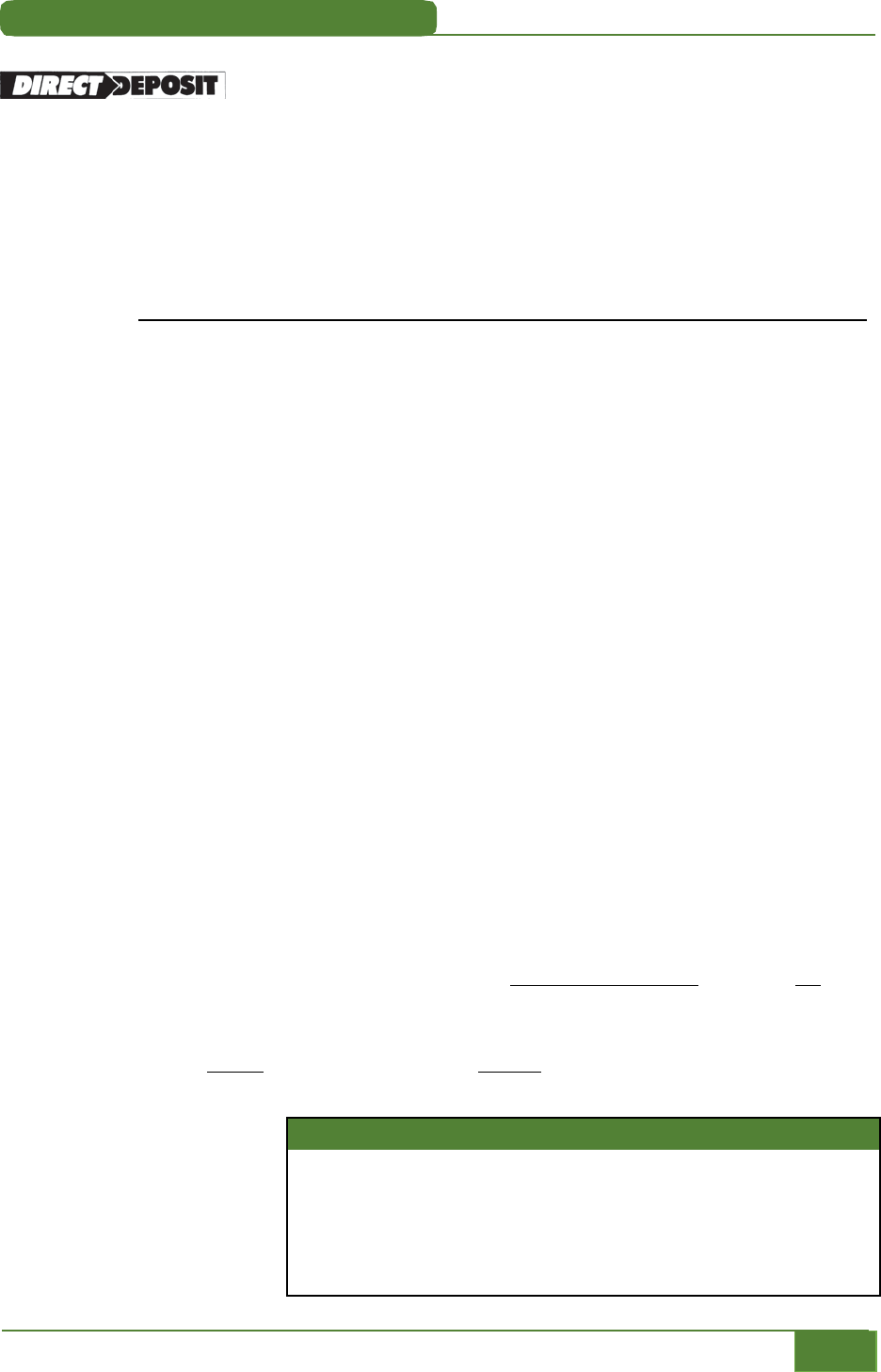
1. Enrollment
Green Book
1-26
A Guide to Federal Government ACH Payments
Approved OMB No. 0960-0564
Required Enrollment Information
The following information is required for the enrollment of a recipient in Direct Deposit using the Standard Entry Class
Code ENR. This information will be transmitted in the entry detail and the addenda record of an ENR transaction. This
page may be duplicated and used for data collection. DO NOT mail this sheet to the agency. All information collected must
refer to the individual who receives the federal benefit payment.
Information obtained from the customer (payment recipient) for inclusion in the entry detail record.
Type of payment:
(Social Security; SSI; Veterans compensation and pension, education MGIB, education/selected
reserve, life insurance and vocational rehabilitation and employment benefits; Civil Service
retirement and survivor annuity; Railroad Retirement annuity and unemployment/sickness)
Information obtained from the customer regarding the payment recipient for inclusion in the Addenda record.
Benefit Recipient’s Social Security Number (SSN) SSN ___ ___ ___ ___ ___ ___ ___ ___ ___
(Do not include hyphens in the addenda record.)
The recipient’s own SSN may or may not be the SSN on which the benefits are drawn. However, the individual recipient’s SSN will always
be included on the addenda record. In cases such as minor children the SSN will always be the Child’s SSN and not that of the adult
account holder named on the financial institution’s records.
Benefit Recipient’s Name
___ ___ ___ ___ ___ ___ ___ ___ ___ ___ ___ ___ ___ ___ ___ ___ ___ ___ ___ ___ ___ ___
Last name (up to 15 positions) First Name (up to 7 positions)
Last name: This is the recipient’s last name excluding any suffixes such as Jr., Sr. II, III, etc. If the last name is hyphenated, the fully
hyphenated name up to 17 characters is submitted.
If the last name is comprised of two or more ‘parts’, generally, the first part is sent as the last name (i.e. Mary Jane S Public Doe). The last
name would be submitted as “PUBLIC” and the Doe would be excluded.
First name: This is the recipient’s first name excluding any prefixes such as Dr., Mrs., Miss, etc.
Middle initials are not submitted in this field. Middle initials are dropped. However, fully spelled out middle names are included as part of
the first name (i.e. Mary J Doe would be submitted as Mary, whereas, Mary Jane Doe would be submitted as Mary Jane.
The ‘parsed’ name will always be
submitted exactly as the parsed section appears on the recipient’s benefit check. Therefore, incorrectly
spelled or spaced items will be submitted as they appear on the check and not as they should be legally spelled. Example: Janie Ann Doe
is trying to enroll; however, her check is printed Jane E A Doe. The enrollment would be submitted as “Jane” and “Doe”.
Representative Payee indication NO (0)(Zero) Yes (1)
(See section on Representative Payee, page 1-33.)
Information obtained at the financial institution.
Depository F
inancial Institution routing number RTN Check Digit
Depositor Account Number __ __ __ __ __ __ __ __ __ __ __ __ __ __ __ __ __ __ __ __ __ __
(Up to 17 positions)
Transaction Type: Checking (Type Code 22) Savings (Type Code 32)
For questions about submitting
ENRs for a specific benefit payment,
please call the corresponding federal
program agency:
Federal Agency Telephone No.
Social Security Administration (for Social Security benefit
or disability and SSI payments)
(215) 597-1134
Office of Personnel Management (Civil Service annuity) (202) 606-0540
Railroad Retirement Board (RRB annuity) (312) 751-4704
Department of Veterans Affairs (VA benefits) (918) 687-2532
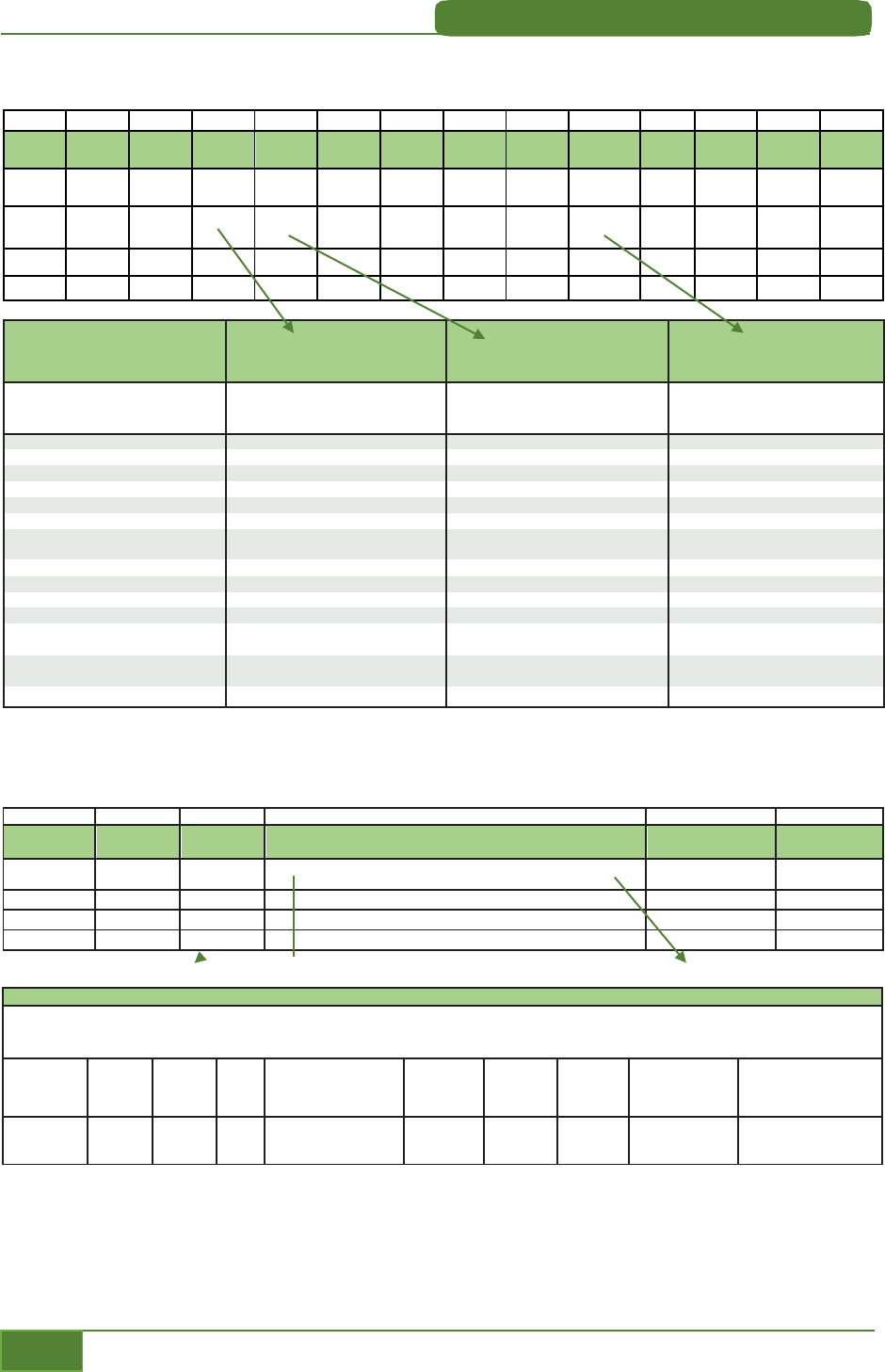
1. Enrollment
Green Book
A Guide to Federal Government ACH Payments
1-27
ENR (Automated Enrollment) Entry Detail Record
Field
1
2
3
4
5
6
7
8
9
10 11 12 13
Data
Element
Name
Record Type
Code
Transaction
Code
Receiving DFI
Identification
Check Digit
DFI Account
Number
Amount
Identification
Number
No. of
Addenda
Records
Receiving
Company
Name/ID
Reserved
Discretionary
Data
Field
Incursion
Requirement
M
M
M
M
R
M
O
M
R
N/A
O
M
M
Contents ‘6’ (numeric)*
(TTTTAAAA)
(numeric)
(blanks)** (all zeros) (blanks) (numeric)
(alphanumeric)
(blanks)** (blanks)** (numeric) (numeric)
Length
1
2
8
1
17
10 15
4
16
2
2
1
15
Position 01-01 02-03 04-11
12-12
13-29 30-39 40-54 55-58 59-74 76-76 77-78 79-79 80-94
*For U.S. Government use either 23 or 33 in Field 2 ** leave blank for Alphanumeric fields 5, 7,10,11
Program Payment
Field 3
Receiving DFI Routing and
Transit Number (RTN)
Field 4 Check
Digit (9
th
digit of
DFI RTN)
Field 9
Receiving Company Name/ID
The following program payments are
eligible for the enrollment service
Use the following DFI Identification
number for the corresponding program
payment
Use the following number for the
corresponding program payment
Use the following codes for the
corresponding program for which the
recipient is enrolling for Direct Deposit
Social Security
65506004
2
SOCIALbSECURITYb
Supplemental Social Security
65506004
2
SUPPbSECURITYbbb
Veterans Compensation and Pension
11173699
1
VAbCOMP/PENSION
Veterans Education MGIB
11173699
1
VAbEDUCATNbMGIB
Veterans Education/Selected Reserve
11173699
1
VAbECUDbMGIB/SR
Veterans Life Insurance
11173699
1
VAbLIFEbINSUR
Veterans Vocational Rehabilitation
and Employment Benefits
11173699
1
VAbVOCbREHABbEMP
Civil Service Retirement/Annuity 11173699
1
CIVILbSERVbCSAbb
Civil Service Survivor/Annuity
11173699
1
CIVILbSERVbCSFbb
Railroad Retirement Annuity
11173699(*)
1 (*)
RAILROADbRETbBDb
Railroad Unemployment/Sickness
11173699(*)
1 (*)
RAILROADbUISIbbb
Dependents Education Assistance
Program
11173699
1
VAbDEPbEDUbASST
Reserve Education Assistance
Program
11173699
1
VAbEDUCTNbREAP
Post 911 GI Bill
11173699
1
VAbEDUbPOSTb9/11
ENR Addenda Record
NOTE: In the codes, the letter “b”
indicates a blank space
Field
1
2
3
4
5
Data Element
Name
Record Type
Code
Addenda Type
Code
Payment Related Information
Addenda Sequence
Number
Entry Detail
Sequence Number
Field Inclusion
Requirement
M M R M M
Contents
‘7’
‘05’
‘22*12200004*3*123987654321*777777777*DOE*JOHN*0\’
(numeric)
(numeric)
Length
1
2
80
4
7
Position 01-01 02-03
04-83
84-87 88-94
Field 3 - Payment Related Information
The
following uses sample information to illustrate the required information to be included in the Addenda record to effect the ENR for Direct Deposit. The standard for
submission
of
ENR records is for all alphabetic characters anywhere in the file to be submitted in UPPER CASE. Failure to do so may result in the submission to be returned by the paying
agency. Refer
to the next page for Return Reasons Codes.
22
=
Checking
Account
32 = Savings
Account
*
12200004
3
123987654321
777777777
DOE
JOHN
0= No Rep. Payee
1= Rep. Payee
\
Contents
Delimiter
‘05’
Check
Digit
Receiver’s Acct. No. at
the
FinancialInstitution
(up to 17 positions)
Receiver’s Own
Social Security
No.
Receiver’s
Surname
(up to 15)
Receiver’s
First Name
(up to 7)
Representative
Payee Indicator
Terminator

1. Enrollment
Green Book
1-28
A Guide to Federal Government ACH Payments
Representative Payee
A representative payee is a person or institution that is legally entitled to receive payments on
behalf of a beneficiary who has been deemed incapable of handling his/her financial affairs. When a
representative payee is present, both names will appear on the benefit check. Minor children
receiving federal benefits should always have a representative payee. Some examples of
representative check payee styles are:
Mary Smith for Jane R. Doe
Harry D. Doe, Guardian for John Q. Public
Admin Sunnyvale Nursing Home for Mary T. Resident
Questions regarding the styling of representative payee names by a particular agency should be
directed to that specific agency.
In processing an enrollment, it is important for the processing financial institution and enrolling
benefit agency to know that the enrollment originated from the proper authority. In cases where
there is a representative payee, a “1” will be entered as the last data element in Field 3 of the
addenda. In instances where there is no representative payee, a “0” (zero) will be entered into this
position.
The federal government requires that the title of accounts receiving direct deposit payments bear
the name of the payment recipient. Accounts established for representative payee payments reflect
fiduciary interest of the representative payee on behalf of the beneficiary. (Example of an account
title: John Doe for Mary Smith.) This same regulation applies to institutional representative payees.
The Department of Veterans Affairs and the Office of Personnel Management do not allow
ENR enrollments for representative payees.
Note: SSA’s Guide for Representative Payees
is
a helpful guide which covers account titling
requirements for their representative payees.
Return Reason Codes
A federal agency may return an ENR entry to the financial institution as unprocessable, one of the
following codes will be indicated on the return:
R40 Non-Participant in ENR Program
The federal program agency is not a participant in the ENR automated enrollment program.
R41 Invalid Transaction Code
An incorrect or inappropriate transaction code is used in Field 3 of the Addenda record.
R42 Routing Number/Check Digit Error
The RTN and/or the Check Digit included in Field 3 of the Addenda record is incorrect.
R43 Invalid DFI Account Number
The receiver’s account number at the DFI is either missing, exceeds 17 positions, or contains invalid
characters.
R44 Invalid Individual ID Number
The receiver’s SSN provided in Field 3 of the Addenda record does not match a corresponding SSN
in the benefit agency’s records.
R45 Invalid Individual Name
The name of the receiver provided in Field 3 of the Addenda record either does not match a

1. Enrollment
Green Book
A Guide to Federal Government ACH Payments
1-29
corresponding name in the benefit agency’s records or fails to include at least one alphanumeric
character.
R46 Invalid Representative Payee Indicator
The representative payee indicator code included in Field 3 of the Addenda record has been
omitted or it is not consistent with the benefit agency’s records.
R47 Duplicate Enrollment
The federal agency has received duplicate ENR entries from the same DFI.
For more complete information concerning return reason codes and their interpretation, refer to
the current Nacha Operating Rules & Guidelines.
Note: At least one paying agency requires that any alphabetic data in an ENR record must be
submitted in all UPPER CASE. Therefore, the de facto standard for submission of ENR records is for all
alphabetic characters located anywhere in the file to be submitted in UPPER CASE. Failure to do so
may result in the submission to be returned as an R44/R45 item even though all the information is
correct.
ENR Tips and Information Checklist
General Questions/Information:
1.
Are you currently receiving Direct Deposit?
•
If yes, then an ENR should be used when the recipient is requesting to initiate direct deposit
for their federal benefits. This may include but is not limited to a first-time sign-up for Direct
Deposit, a change to an existing Direct Deposit enrollment, or a change to a new financial
institution.
•
If no, do you have, or have you opened a checking or savings account?
2.
Is the federal benefit check in the customer’s name only? If no, determine whether there is a
representative payee relationship or not.
3.
The benefit recipient or representative payee must be present in order to sign up for direct
deposit. If by phone, the recipient or representative payee must be available to give permission.
Benefit Recipient Information
4.
Benefit recipient - the person who receives the federal benefit payment.
5.
Representative payee - the benefit comes in their name on behalf of someone else.
6.
“In C/O” - the benefit comes to the benefit recipient “in care of” someone else. This does not
mean the person the check is “in care of” is the representative payee. The benefit recipient must
be present to enroll.
7.
If the customer has Power of Attorney for the benefit recipient, he/she must go to the local office
of the paying agency to sign up for direct deposit. If the benefit recipient is not present, the
customer will need to take all legal documents with them to a regional office of the paying
agency. The paying agency does not accept enrollments based solely on a Power of Attorney.

1. Enrollment
Green Book
1-30
A Guide to Federal Government ACH Payments
8.
If the customer is the guardian of the benefit recipient and his/her name is on the benefit check
as guardian for the benefit recipient, then the financial institution would treat them as a
representative payee. If his/her name is not on the benefit check, he/she must go to the local
paying agency office with all legal documents.
Information Needed for Direct Deposit Enrollment
The following information is needed to enroll Social Security benefits or disability payments,
Supplemental Security Income payments, Railroad Retirement Board annuities, Veteran’s
Compensation and Pension, and OPM Civil Service annuities for direct deposit through the U.S.
Treasury Electronic Payment Solution Center:
1.
The SSN of the benefit recipient,
2.
The routing and account number of the checking or savings account, and
3.
The benefit recipient’s claim number or check number of the most recent federal benefit
check received and the payment amount.
The federal benefit check numbers are located in the top right-hand corner of the federal benefit
check. The check numbers are 12 digits long (beginning with four digits, then a space, and eight
more digits). All 12 numbers must be entered with no spaces and no dashes.
The claim number must be entered with no spaces or dashes. All numbers and letters must be
entered side by side.
Helpful Numbers and Websites
1.
For Social Security benefit or disability, SSI, VA, RRB annuity, and OPM civil service annuity
enrollments please enroll through either:
Go Direct web enrollment: www.GoDirect.gov
Or call the U.S. Treasury Electronic Payment Solution Center at 1-800-333-1795
(English)/1-800-333-1792 (Spanish), 8:00 a.m. – 8:00 p.m. ET, Monday – Friday, excluding
federal holidays.
2.
Department of Defense (DOD) or Black Lung payments cannot be set up through ENR. Contact
Information:
•
Veterans Affairs benefits 1-800-827-1000
•
DOD www.dfas.mil
•
Black Lung www.dol.gov/owcp/dcmwc
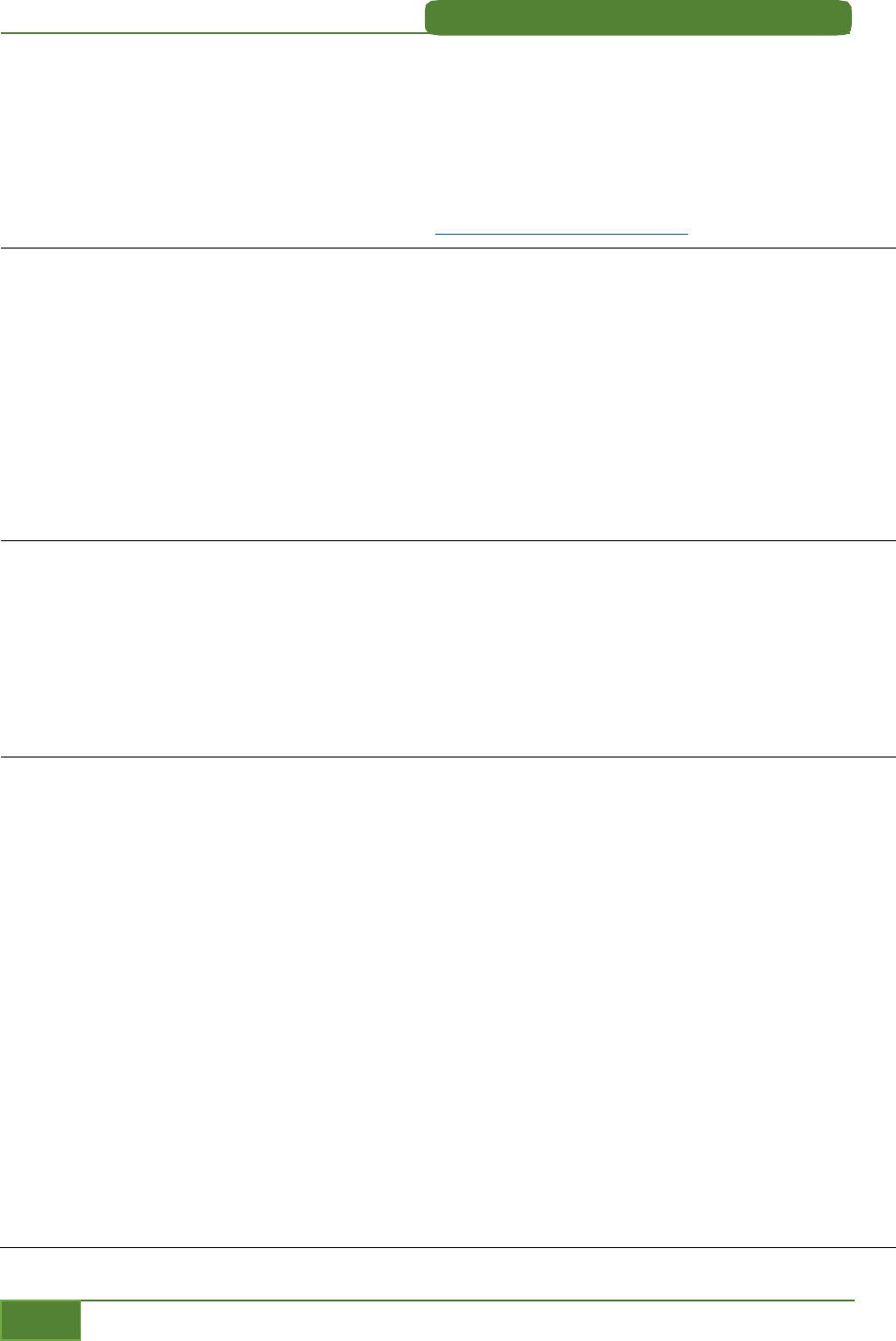
1. Enrollment
Green Book
A Guide to Federal Government ACH Payments
1-31
F
ederal Agency Addresses and Phone Numbers
Federal agency addresses and phone numbers are listed below, including the locations where
completed FS Form 1199A should be delivered. If a telephone number is not listed and further
assistance is needed, please contact the Fiscal Service.
Note: As with any listing of this type, contact information will frequently change. Should you find out-
of-date information, please let us know by email at: payments@fiscal.treasury.gov.
Air Force
Active Duty/Reserves
Recipient should deliver the completed FS Form 1199A to their payroll office.
Questions: (303) 676-7213
Air National Guard
Recipient should deliver the completed FS Form 1199A to their payroll office.
Retirement/Annuity
DFAS-CL
U.S. Military Retirement and Annuitant Pay
1240 E. Ninth Street
Cleveland, Ohio 44199-2055
Retirement / Annuity: 1 (800) 321-1080
Allotments: (216) 522-5553
Army
Active Duty/Reserves/National Guard
Recipient must mail or deliver the completed FS Form 1199A to their payroll office.
Questions: (317) 510-2800
Retirement/Annuity
DFAS-CL
U.S. Military Retirement and Annuitant Pay
1240 E. Ninth Street
Cleveland, Ohio 44199-205
Retirement / Annuity: 1 (800) 321-1080
Fiscal Service
Federal Housing Administration Debenture Payments
Special Investments Branch
Warehouse and Operations Center, Dock 1
257 Bosley Industrial Park Drive
Parkersburg, WV 26101
Questions: (304) 480-5299
Savings Bond Agent’s Fee Payments
Bureau of the Fiscal Service
Treasury Retail Securities Services
P.O. Box 9150
Minneapolis, MN 55480-9150
(844) 284-2676
Series H/HH Savings Bond Interest Payments
Current Income Bond Branch
Bureau of the Fiscal Service
Warehouse and Operations Center, Dock 1
257 Bosley Industrial Park Drive
Parkersburg, WV 26101
Questions: (304) 480-6112

1. Enrollment
Green Book
1-32
A Guide to Federal Government ACH Payments
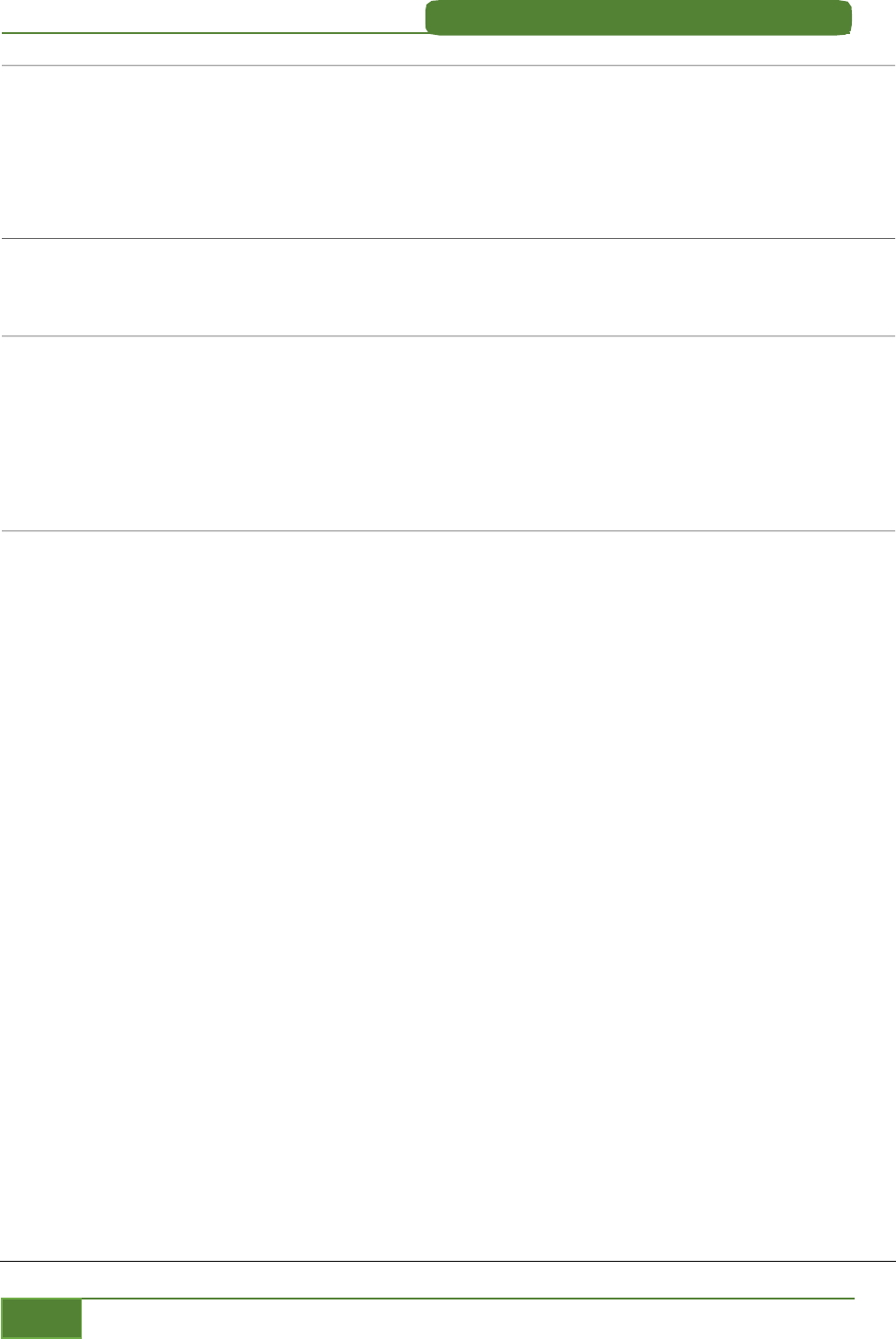
1. Enrollment
Green Book
A Guide to Federal Government ACH Payments
1-33
Fiscal Service
(continued)
State and Local Government Payments
State and Local Government Payments
Bureau of the Fiscal Service
Warehouse and Operations Center, Dock 1
257 Bosley Industrial Park Drive
Parkersburg, WV 26101
Questions: (304) 480-5299
Central
Intelligence
Agency
Send completed forms to...
Central Intelligence Agency
Washington, DC 20505
Attn: Compensation Division Office of Finance
Coast Guard Active Duty/Reserves
Mail or have the recipient deliver the completed FS Form 1199A form to their payroll office.
Retirement
Coast Guard (RPD)
Commanding Officers USGC-PPC
Pay and Personnel Office
444 SE Quincy Street
Topeka, KS 66683
Department
of Labor
Black Lung
Send all completed FS Form 1199As
to ...
Questions?
Contact your district office below.
U.S. Department of Labor
ESA/OWCP/DCMWC
select district office address below
Johnstown, PA
319 Washington Street, 2nd Floor
(800) 347-3754
Johnstown, PA 15901
(814) 533-4323
Greensburg, PA
1225 S. Main Street, Suite 405
Greensburg, PA 15601
(800) 347-3753
(724) 836-7230
Wilkes-Barre, PA
100 N. Wilkes-Barre Blvd.
Room 300 A
(800) 347-3755
(570) 826-6457
Wilkes-Barre, PA 187002
Charleston, WV
Charleston Federal Center, Suite 110
500 Quarrier Street
(800) 347-3749
(304) 347-7100
Charleston, WV 25301
Parkersburg, WV
425 Juliana Street, Suite 3116
(800) 347-3751
Parkersburg, WV 26101
(304) 420-6385
Pikeville, KY
164 Main Street, Suite 508
Pikeville, KY 41501
(800) 366-4599
(606) 432-0116
Mount Sterling, KY 402 Campbell Way
Mount Sterling, KY 40353
(800) 366-4628
(859) 498-9700
Columbus, OH
1160 Dublin Road, Suite 300
Columbus, OH 43215
(800) 347-3771
(614) 469-5227
Denver, CO 1999 Broadway, Suite 690 (800) 366-4612
P.O. Box 46550
Denver, CO 80201-6550
(720) 264-3100

1. Enrollment
Green Book
1-34
A Guide to Federal Government ACH Payments
Department
of Labor
(continued)
Unknown District
U.S. Department of Labor
Black Lung Program
P.O. Box 37227
Washington, DC 20013
(800) 638-7072
Department
of Labor
Division of Energy Employees Occupational Illness Compensation
Send all completed FS Form U.S. Department of Labor
1199As to ... Division of Energy Employees
Occupational Illness Compensation
Questions? P.O. Box 8306
Contact (866) 888-3322 London, KY 40742-8306
Department
of Labor
Federal Employee Workers’ Compensation
Send all completed FS Form
1199As to ...
Questions?
Contact (202) 693-0040
U.S. Department of Labor
Division of Federal Employees’ Compensation
P.O. Box 8311
London, KY 40742-8311
Department
of Labor
Longshore and Harbor Workers’ Compensation
Send all completed FS Form
1199As to ...
Questions?
Contact (202) 693-0925
U.S. Department of Labor
ESA/OWCP/DLHWC
Frances Perkins Building
Room C4315
200 Constitution Avenue, NW
Washington, DC 20210
Department
of Veterans
Affairs
Mail the completed FS Form 1199A form to the office that maintains the veteran’s records:
ALABAMA
Alabama VA Regional Office
345 Perry Hill Road
Montgomery, AL 36104
Questions: 1 (800) 827-1000
COLORADO
Denver VA Regional Office
155 Van Gordon Street
Lakewood, CO 80228
ALASKA Anchorage VA Regional Office
2925 DeBarr Road
Anchorage, AK 99508-2989
CONNECTICUT Hartford VA Regional Office
450 Main Street
Hartford, CT 06103
ARIZONA Arizona VA Regional Office
3225 N. Central Avenue
Phoenix, AZ 85012
DELAWARE Wilmington VA Regional Office
1601 Kirkwood Highway
Wilmington, DE 19805
ARKANSAS North Little Rock VA Regional
Office
345 Perry Hill Road
Montgomery, AL 36104
DISTRICT OF
COLUMBIA
Washington DC VA Regional
Office
1120 Vermont Avenue, NW
Washington, DC 20421
CALIFORNIA
Los Angeles VA Regional Office Federal
Building
1100 Wilshire Boulevard Los
Angeles, CA 90024
FLORIDA St. Petersburg VA Regional Office
9500 Bay Pines Boulevard
Bay Pines, FL 33708
San Diego VA Regional Office
8810 Rio San Diego Drive San
Diego, CA 92018
GEORGIA Atlanta VA Regional Office
1700 Clairmont Road
Decatur, GA 30033
Oakland VA Regional Office
Oakland Federal Building 1301
Clay Street, Room 1300N Oakland,
CA 94612
HAWAII Honolulu VA Regional Office
459 Patterson Road, E-Wing
Honolulu, HI 96819-1522

1. Enrollment
Green Book
A Guide to Federal Government ACH Payments
1-35
Department
of Veterans
Affairs
(continued)
IDAHO
Boise VA Regional Office
805 W. Franklin Street
Boise, ID 83702
MONTANA
Fort Harrison Medical &
Regional Center
William Street off Highway
Fort Harrison, MT 59636
ILLINOIS Chicago VA Regional Office
536 S. Clark Street
Chicago, IL 60605-1523
NEBRASKA Lincoln VA Regional Office
5631 S. 48th Street
Lincoln, NE 68516
INDIANA Indianapolis VA Regional Off.
75 NB. Pennsylvania Street
Indianapolis, IN 46204
Questions: (317) 226-7860
NEVADA Reno VA Regional Office
1201 Terminal Way
Reno, NV 89520
IOWA Des Moines VA Regional Office
210 Walnut Street
Des Moines, IA 50309
NEW
HAMPSHIRE
Manchester VA Regional Office
Norris Cotton Federal Building
275 Chestnut Street
Manchester, NH 03101
KANSAS Wichita VA Regional Office
5500 E. Kellogg
Wichita, KS 67211
NEW JERSEY New Jersey VA Regional Office
20 Washington Place
Newark, NJ 07102
KENTUCKY Louisville VA Regional Office
545 S. Third Street
Louisville, KY 40202
NEW MEXICO Albuquerque VA Regional Office
Davis Chavez Federal Building
500 Gold Avenue, SW
Albuquerque, NM 87102
LOUISIANA New Orleans VA Regional Office
701 Loyola Avenue
New Orleans, LA 70113
NEW YORK Buffalo VA Regional Office
Federal Building
111 W. Hurron Street
Buffalo, NY 14202
MAINE Togus Center
One VA Center
Togus, ME 04330
New York VA Regional Office
245 W. Houston Street
New York, NY 10014
MARYLAND Baltimore VA Regional Office
31 Hopkins Plaza
Baltimore, MD 21201
NORTH
CAROLINA
Winston-Salem VA Regional
Office
Federal Building
251 N. Main Street
Winston-Salem, NC 27155
MASSACHUSETTS
Boston VA Regional Office
J.F. Kennedy Federal Building
Government Center
Boston, MA 02114
NORTH DAKOTA Fargo VA Medical/Regional
Office Center
2101 Elm Street
Fargo, ND 58102
Questions: (701) 232-3421
MICHIGAN Detroit VA Regional Office
Patrick V. McNamara Federal
Building
477 Michigan Avenue
Detroit, MI 48226
OHIO Cleveland VA Regional Office
Anthony J. Celebrezze
Federal Building
1240 E. Ninth Street
Cleveland, OH 44119
MINNESOTA
St. Paul VA Regional Office
One Federal Drive, Fort Snelling
St. Paul, MN 55111-4050
OKLAHOMA Muskogee VA Regional Office
Federal Building
125 S. Main Street
Muskogee, OK 74401
MISSISSIPPI Jackson VA Regional Office
1600 E. Woodrow Wilson Ave.
Jackson, MS 39216
OREGON Portland VA Regional Office
Federal Building
1220 SW 3rd Avenue
Portland, OR 97204
Questions: (503) 326-2511
MISSOURI St. Louis VA Regional Office
Federal Building
400 S. 18th Street
St. Louis, MO 63103
PENNSYLVANIA
Philadelphia VA Center
5000 Wissahickon Avenue
Philadelphia, PA 19101
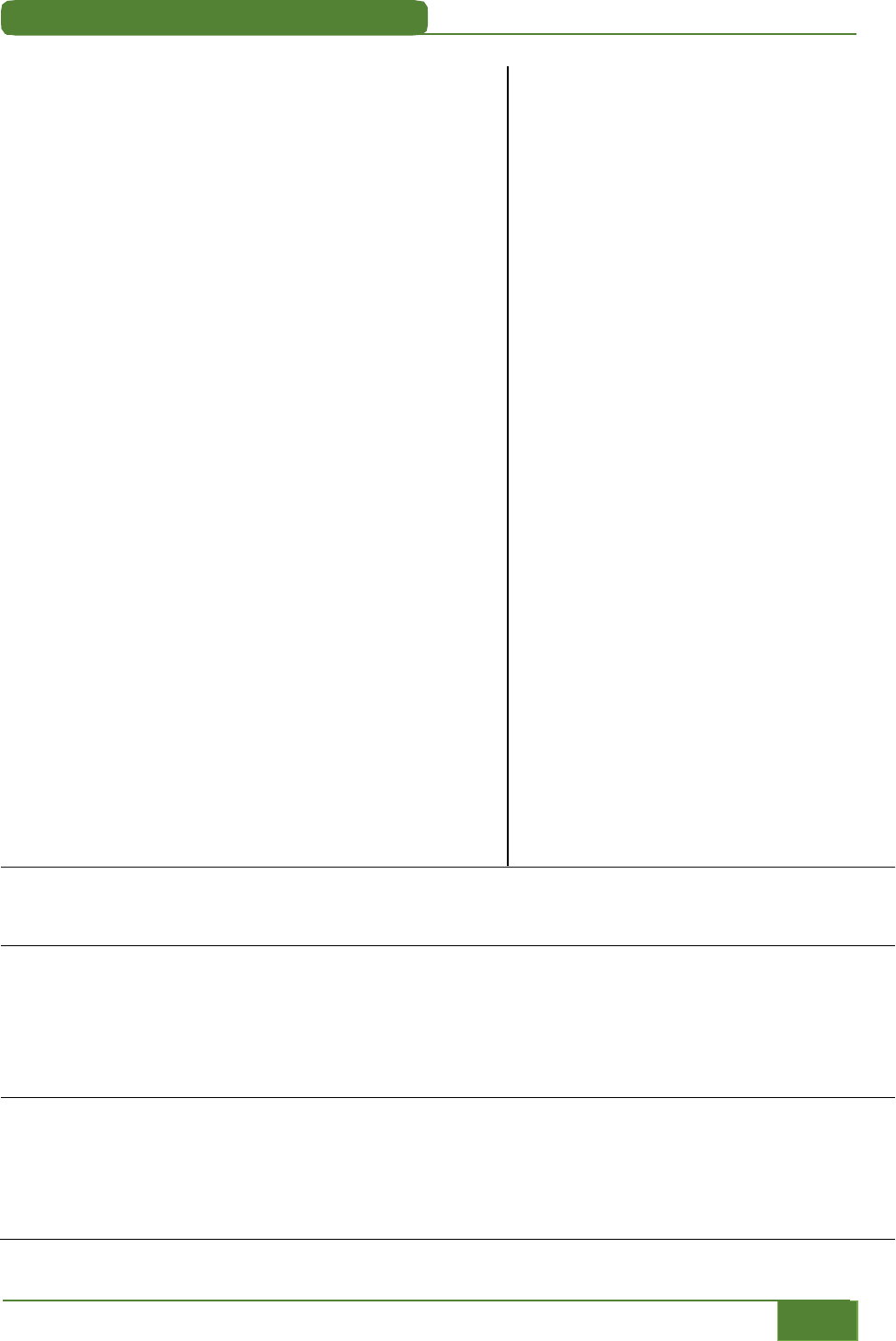
1. Enrollment
Green Book
1-36
A Guide to Federal Government ACH Payments
Department
of Veterans
Affairs
(continued)
Federal
Salary
The employee should mail or deliver the completed FS Form 1199A form to their payroll
office.
Marine Corps Active Duty/Reserves
Director
DFAS – Kansas City Center (AF-FA)
Kansas City, MO 64197-0001
Questions: (303) 676-7213
Retirement/Annuity
DFAS – CL
U.S. Military Retirement and Annuitant Pay
1240 E. Ninth Street
Cleveland, OH 44199-2055
Questions: 1 (800) 321-1080
Navy Active Duty/Reserves
Mail or have the recipient deliver the
completed FS Form 1199A form to their
payroll office.
Questions: 1 (800) 255-0974
Retirement/Annuity
DFAS – CL
U.S. Military Retirement and Annuitant Pay
1240 E. Ninth Street
Cleveland, OH 44199-2055
Questions: 1 (800) 321-1080
PENNSYLVANIA
Pittsburgh VA Regional Office
1000 Liberty Avenue
Pittsburgh, PA 15222
WEST VIRGINIA
Huntington VA Regional Office
640 Fourth Avenue
Huntington, WV 25701
RHODE ISLAND Providence VA Regional Office
380 Westminster Mall
Westminster, RI 02903
WISCONSIN Milwaukee VA Regional Office
5000 W. National Avenue
Milwaukee, WI 53295
SOUTH
CAROLINA
Columbia VA Regional Office
1801 Assembly Street
Columbia, SC 29201
WYOMING Cheyenne VA Medical/Regional
Center
2360 E. Pershing Boulevard
Cheyenne, WY 82001
SOUTH
DAKOTA
Sioux Falls VA Center
P.O. Box 5046
2501 W. 22nd Street
Sioux Falls, SD 57117
GUAM
Guam Vet Center
222 Chanlan Santo Papast
Reflection Center, Suite 102
Agana, GU 96910
Questions: (705) 475-7161
TENNESSEE Nashville VA Regional Office
110 9th Avenue, South
Nashville, TN 37203
PHILIPPINES
Manila Regional Office
1131 Roxas Boulevard, Ermita
0930 Manila, PL 96440
Questions: (011) (632) 528-
2500
TEXAS Houston VA Regional Office
6900 Almeda Road
Houston, TX 77030
PUERTO RICO San Juan VA Center
150 Carlos Chardon Avenue
Hato Rey, PR 00918
Waco VA Regional Office
One Veterans Plaza
701 Clay Avenue
Waco, TX 76799
VIRGINIA see District of Columbia
UTAH Salt Lake City VA Regional Office
550 Foothill Drive
Salt Lake City, UT 84158
VIRGIN ISLANDS St. Croix Vet Center
Box 12, R.R. 02,
Village Mail, #113Affairs
Saint Croix, VI 00850
Questions: 1 (809) 778-5553
VERMONT White River Junction VA Medical
& Regional Office Center
215 N. Main Street
White River Junction, VT 05009
Saint Thomas Vet Center
Buccaneer Mall
Saint Thomas, VI 00801
Questions: 1 (809) 774-6674
WASHINGTON Seattle VA Regional Office
Federal Building
915 Second Avenue
Seattle, WA 98174
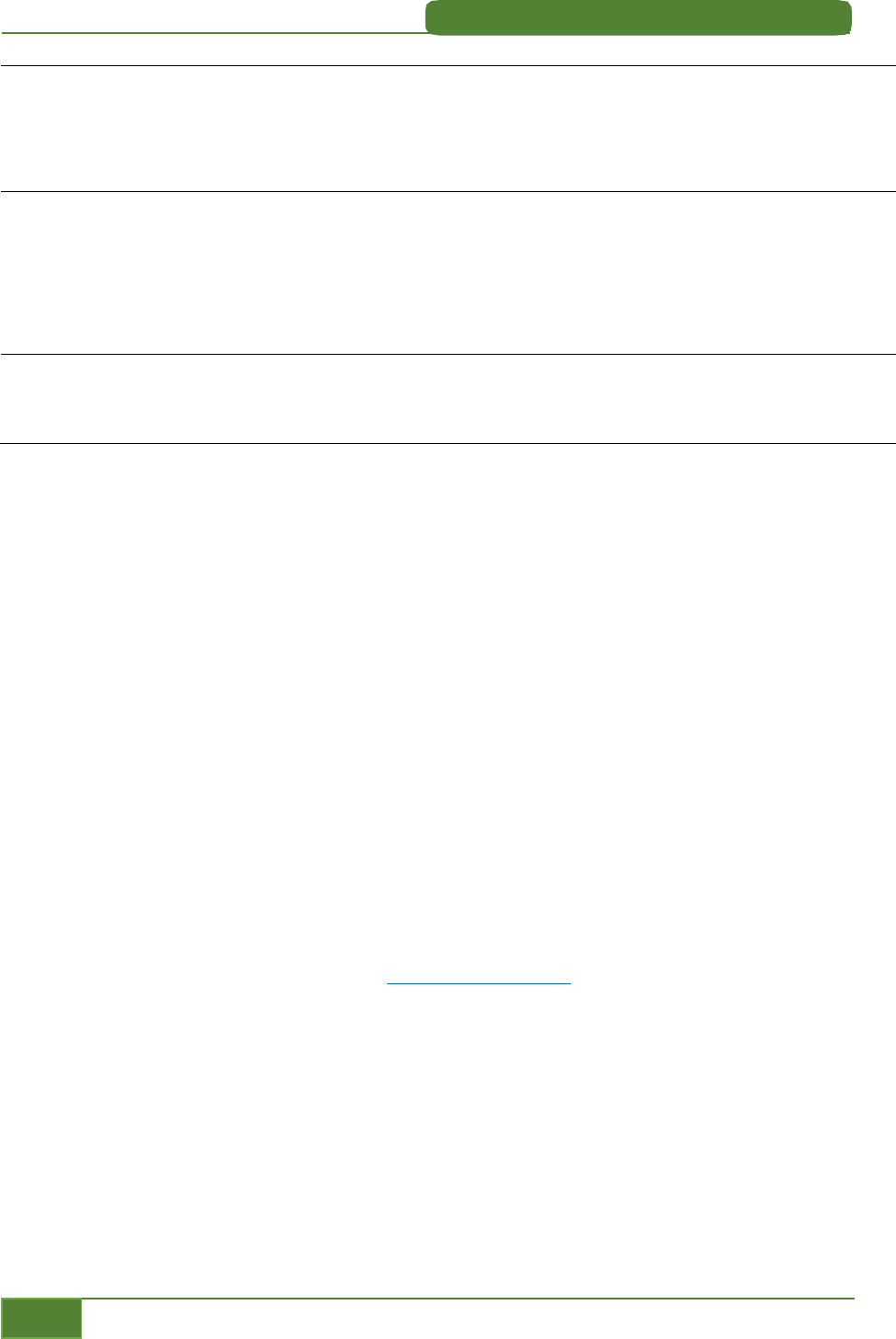
1. Enrollment
Green Book
A Guide to Federal Government ACH Payments
1-37
Office of
Personnel
Management
(Civil Service
Annuity)
Send completed forms to . . .
Questions: (202) 606-0500
Office of Personnel Management
Change-of-address Section-ROC
Retirement and Insurance Group
P.O. Box 440
Boyers, PA 16017-0440
Railroad
Retirement
Board
Send completed forms to …
the local Railroad Retirement Board
as listed in the telephone directory;
or,
Questions:
(312) 751-4500 or (312) 751-4707
If you cannot obtain the address of the local office,
mail to:
U.S. Railroad Retirement Board
P.O. Box 10792
844 N. Rush Street
Chicago, IL 60611
Attn: Direct Deposit Coordinator ORSP
Social
Security
Administration
Send completed forms to . . .
• the local Social Security District Office, or
• the address Social Security has specified to your financial institution.
G: Termination of Enrollment
The ACH Enrollment authorization may be revoked by the recipient or, under certain
circumstances, by the financial institution. If a recipient revokes his/her ACH enrollment, they must
provide a new ACH enrollment in order ACH payments.
Termination by the Recipient
The recipient may revoke the enrollment authorization at any time by notifying the federal agency,
or by authorizing a new enrollment with another financial institution.
Social Security or Supplemental Security Income recipients should call 1-800-SSA-1213 or write
their local Social Security District Office to revoke the enrollment authorization.
Railroad Retirement Board annuitants may either write or call the local Railroad Retirement Board
Field Office to revoke the enrollment authorization.
Series H/HH savings bond owners who are required to receive interest payments by Direct Deposit
may revoke the enrollment authorization. However, this will result in suspension of payments.
Payments will resume when the recipient authorizes a new enrollment.
OPM Annuitants may either write the Office of Personnel Management, call 1-888-767-6738 to
revoke the enrollment authorization, or visit www.opm.gov/retire t
o terminate and make changes
on-line.
The e
nrollment authorization will be terminated due to the recipient’s or beneficiary’s death or
legal incapacity.
Courtesy Notice
The recipient or beneficiary is not required to inform the financial institution if he/she revokes or
transfers their enrollment authorization. As a courtesy, the recipient should be encouraged to
inform the financial institution of any changes.

1. Enrollment
Green Book
1-38
A Guide to Federal Government ACH Payments
Termination by the Financial Institution
Financial institutions may close an account to which benefit payments are currently being sent
thereby revoking the enrollment authorization by providing a 30-day written notice to the recipient
prior to closing the account. In cases involving fraud, accounts may be closed immediately. The
financial institution cannot revoke the enrollment authorization by notifying the federal agency and
not the recipient.
The 30-day written notice should remind the recipient to make other arrangements for the
handling of their payments. The financial institution must credit to the recipient’s account any
payments received during the 30-day notice period. The financial institution must also immediately
return to the federal government all payments received after the 30-day notice period. A financial
institution that closes an account without properly terminating the enrollment must make the
funds available to the recipient until proper notice is provided.
Recipient Notice to the Federal Agency
The recipient or beneficiary must immediately advise the federal agency if the enrollment
authorization is revoked by the financial institution.

2-1
A Guide to Federal Government ACH Payments
ACH Payment
Processing
Overview
In this chapter…
A: Financial Organization Master File (FOMF) ..................................................................................... 2-3
Purpose .......................................................................................................................................................................... 2-3
Financial Institution Responsibility .................................................................................................................... 2-3
Changes to Financial Institution Name and Mailing Address ......................................................................2-3
Changes to Routing Transit Numbers .....................................................................................................................2-3
Updating ACH Customer Directory (ACD): ...........................................................................................................2-3
New Depository Institutions ........................................................................................................................................ 2-4
B: Federal Government ACH Processing ................................................................................................ 2-4
General Flow ................................................................................................................................................................ 2-4
Prenotification ............................................................................................................................................................. 2-4
Payment Formats ....................................................................................................................................................... 2-4
Account Requirements ............................................................................................................................................. 2-4
Misdirected Payments .............................................................................................................................................. 2-5
Notice of Misdirected Payment ............................................................................................................................. 2-6
Availability of Funds ................................................................................................................................................. 2-6
C: Federal ACH Payment Schedule ...................................
........................................................................ 2-7
D: Identifying Treasury Disbursed Payments ...................................................................................... 2-7
Consumer Payments ................................................................................................................................................. 2-7
Consumer Payment Formats .......................................................................................................................................2-7
Standard Entry Class Code ...........................................................................................................................................2-7
Social Security Administration Use of Prearranged Payment and Deposit (PPD+) ...........................2-7
Payment Types ..................................................................................................................................................................2-8
Identifying the Paying Agency/Payment Type ............................................................................................... 2-8
Identifying the Payee ................................................................................................................................................ 2-8
2
This chapter provides information about how federal government ACH payments are processed. It
also contains valuable information on payment dates and information to assist in identifying
Treasury disbursed payments.

2-2
A Guide to Federal Government ACH Payments
2. ACH Payment Processing
Green Book
Company entry description for IRS Advance Child Tax Credit Payments ............................................ 2-9
E: Identifying Non-Treasury Disbursed Payments ........................................................................... 2-09
Identifying the Paying Agency/Payment Type ............................................................................................. 2-09
Identifying the Payee .............................................................................................................................................. 2-09
F: Garnishment of Federal Benefits .............................................................................................. 2-10

2. ACH Payment Processing
Green Book
2-3
A Guide to Federal Government ACH Payments
A: Financial Organization Master File (FOMF)
The Financial Organization Master File (FOMF) is a Department of the Treasury master list of
financial institutions receiving federal government ACH payments. It contains RTNs, a single
financial institution name and mailing address for each RTN.
The FOMF is derived from the Federal Reserve Bank’s (FRB) ACH Customer Directory (ACD), which
contains the RTNs and related information of all valid ACH participants. The FOMF is updated on a
monthly basis using information from the most current ACD file.
Purpose
The Fiscal Service relies on the FOMF data to validate RTNs used to originate payments and to send
financial institutions the following:
•
reclamation notices,
•
trace inquiries, and
•
marketing materials.
Financial Institution Responsibility
Changes to Financial Institution Name and Mailing Address
Financial institutions are responsible for keeping their name and mailing address for each RTN up
to date with the FRB. Any changes to RTN data should be provided to the FRB as soon as possible so
that the ACD and FOMF contain current data. If the financial institution fails to notify the FRB, it
may be held liable for information (e.g., reclamation notices) mailed to obsolete addresses.
Changes to Routing Transit Numbers
If a financial institution changes RTNs (e.g., due to merger), it must notify the FRB ACH department
as soon as possible to have the old RTN rescinded in ACD and have all future ACH transactions
reflect the financial institution’s active ACH routing number. Updates to the ACD will update the
FOMF. Additionally, financial institutions should send a Notification of Change (NOC) to each
originating federal agency from which it receives payments impacted by the routing number
changes.
The following steps should be taken in updating the ACD routing number data:
•
Confirm that no activity is being received on the obsolete RTN prior to deletion.
•
Allow at least three months after the update to the ACD before deleting an obsolete RTN.
•
Delete an obsolete RTN only after all activity has been transferred to the surviving RTN.
Updating ACH Customer Directory (ACD):
If an institution wants to update the information that appears on the file, they should submit a new
“Part 1 - Agreement to Terms and General Participant Information” of the FedACH Participation
Agreement to the FRB.
If you have any questions in reference to updating data, you should contact the FedACH and Check
Services Customer Support team.

2. ACH Payment Processing
Green Book
A Guide to Federal Government ACH Payments
2-4
New Depository Institutions
Because the FOMF is updated monthly, a new depository institution may not receive government
ACH transactions for up to 30 days after being entered into the FRB ACD.
B: Federal Government ACH Processing
General Flow
Federal government ACH payments are initiated by the authorizing federal agency to a government
disbursing office. These include the Department of Defense disbursing offices, and Fiscal Service.
The FRB is the federal government’s ACH Operator.
Prenotification
The federal government prenotification process is handled in accordance with Nacha Operating
Rules & Guidelines. Social Security Administration originates prenotifications for Social Security
benefits for Direct Deposit enrollments and changes.
Payment Formats
Federal government ACH payments are originated in the Prearranged Payment and Deposit (PPD)
with or without addenda, Corporate Credit or Debit (CCD) with or without addenda, Corporate
Trade Exchange (CTX) formats, or International ACH Transaction (IAT). Refer to the Nacha
Operating Rules & Guidelines for details on payment record formats.
Account Requirements
All federal government benefit payment enrollments must be established for a deposit account at
the financial institution that is in the name of the recipient or beneficiary with the following
exceptions:
•
Where an authorized payment agent (representative payee) has been selected, a representative
payee is an individual or organization appointed by SSA to receive Social Security and/or SSI
benefits for someone who cannot manage or direct someone else to manage his or her money.
The main responsibilities of a payee are to use the benefits to pay for the current and
foreseeable needs of the beneficiary and properly save any benefits not needed to meet current
needs. A payee must also keep records of expenses.
•
Where the payment is to be deposited into an investment account established through a
securities broker or dealer registered with the Securities and Exchange Commission, or an
investment account established through an investment company registered under the
Investment Company Act of 1940 or its transfer agent, the payment may be deposited into an
account designated by the broker or dealer, investment company, or transfer agent.
•
Where a federal payment is disbursed to a resident of a nursing facility, as defined in 42 U.S.C.
1396r, the payment may be deposited into a resident trust or patient fund account established
by the nursing facility so long as it meets the requirements under federal law relating to the

2. ACH Payment Processing
Green Book
2-5
A Guide to Federal Government ACH Payments
protection of such funds. For more information on these requirements, please visit the ACH
regulations website.
•
Where a federal payment is disbursed to a member of a religious order who has taken a vow of
poverty, the payment may be deposited to an account established by the religious order. The
phrase ‘member of a religious order who has taken a vow of poverty’ is defined as it would be by
the Internal Revenue Service for federal tax purposes.
•
Where a federal payment is to be deposited to an account accessed by the recipient through a
prepaid card that meets the following requirements:
(A)
The account is held at an insured financial institution,
(B)
The account is set up to meet the requirements for pass-through deposit or share insurance
such that the funds accessible through the card are insured for the benefit of the recipient
by the Federal Deposit Insurance Corporation or the National Credit Union Share Insurance
Fund in accordance with applicable law (12 CFR part 330 or 12 CFR part 745),
(C)
The account is not attached to a line of credit or loan agreement under which repayment
from the account is triggered upon delivery of the federal payments, and
(D)
The issuer of the card complies with all the requirements and provides the holder of the
card with all the consumer protections, that apply to a payroll card account under the
rules implementing the Electronic Fund Transfer Act, as amended.
No person or entity may issue a prepaid card that receives federal payments in violation of these
requirements, and no financial institution may maintain an account for or on behalf of an issuer
of a prepaid card that receives federal payments if the issuer violates these requirements. If
Fiscal Service becomes aware that a prepaid card product that accepts federal government
payments does not meet these requirements, it will research the card product and report any
violations of these requirements to the institution’s primarily regulator.
•
Where Treasury has granted a waiver.
Misdirected Payments
. The RDFI decides to manually post the misdirected payment to the correct account and originates
an NOC entry with the correct account and/or RTN information. Please note that the financial
institution does this at its own risk and may be liable to the issuing agency if the financial
institution post the misdirect payment to an incorrect account and there is a resulting loss by the
agency. Please see Chapter 6, Notification of Change, for more information. If the financial
institution cannot credit the misdirected payment to the correct account, the financial institution
may return the payment to the agency with an appropriate reason code. Please see Chapter 4,
Returns, for more information.
It is important to note that a financial institution is not required to manually verify that the name on
the ACH entry matches the name on the account at the time the payment is posted. An RDFI is only
liable for posting the payment to the account in the ACH credit entry.

2. ACH Payment Processing
Green Book
A Guide to Federal Government ACH Payments
2-6
Notice of Misdirected Payment
In accordance with 31 CFR part 210, an RDFI that becomes aware that an agency has misdirected
an ACH credit entry to the wrong account must promptly notify the agency. A financial institution
may become aware of a misdirected payment through the following ways:
•
The account holder notifies the financial institution of the misdirected payment,
•
A non-receipt claim being investigated by Fiscal Service,
•
A financial institution that manually posts their ACH credits notices that a payment is being
credited to the wrong account. (It is important to note that an institution is not required to
match names when posting a federal government ACH entry; however, if it routinely posts
entries manually and notices that an entry is being directed to the wrong account, it is required
to notify the agency.), and
•
A call from the federal agency that disbursed the payment.
If a financial institution becomes aware of a misdirected payment, it can notify the agency in the
following ways and meet the requirements of 31 CFR part 210:
•
The RDFI decides to manually post the misdirected payment to the correct account and
originates an NOC entry with the correct account and/or RTN information. Please note that the
financial institution does this at its own risk and may be liable to the issuing agency if the
financial institution is incorrect and there is a resulting loss by the agency,
•
Return the original ACH credit entry to the agency with the appropriate return reason code,
•
Contact the agency by phone or by letter. Please see Chapter 7, Contacts, and
•
Any other means deemed acceptable by the agency that disbursed the ACH credit payment.
Availability of Funds
In accordance with Nacha Operating Rules & Guidelines, any non-Same Day ACH credit payment
must be made available for withdrawal by the Receiver no later than 9:00 a.m., Receiving
Depository Financial Institution (RDFI) local time, on the settlement date (provided the entries are
made available to the RDFI by its ACH operator no later than 5:00 p.m. on the banking day prior to
the settlement date).
On J
anuary 03, 2022, the Fiscal Service accepted the Nacha rule changes that allow for Same Day
ACH transactions, and effective March 22, 2022, Fiscal Service amended 31 CFR Part 210, to
address changes made by Nacha through the 2021 Nacha Operating Rules & Guidelines book,
including supplements thereto.
Same Day ACH rules have established three windows for all financial institutions to submit Same
Day ACH payments: 10:30 a.m., 2:30 p.m., and 4:45 p.m. ET. Fiscal Service only uses the second and
third windows for same day ACH transactions. Funds from Same Day ACH credits processed in the
second processing window will be made available by 5:00 p.m. RDFI’s local time, while funds from
Same Day ACH credits processed in the third window are settled at 6:00 p.m. ET. The amount of a
third window Same Day ACH credit must be available to the receiver’s account no later than the end
of the RDFI’s processing day (RDFI’s local time). Such funds are not required to be
available for
withdrawal on the settlement date. There is a $1,000,000 per payment limit for Same Day ACH that
applies to all Fiscal Service payment customers.

2. ACH Payment Processing
Green Book
2-7
A Guide to Federal Government ACH Payments
Non-Treasury Disbursed Organizations, who do not submit their payments through the Fiscal
Service, are currently prohibited from authorizing any Same Day ACH credits for payments. Only
agencies that disburse through the Fiscal Service will be permitted to request Same Day ACH
payments. Fiscal Service began to process Same Day ACH credits (for payments) in April 2018. The
Fiscal Service began to accept Same Day ACH credits and debits for tax collections beginning in
September 2017.
C: Federal ACH Payment Schedule
Fiscal Service publishes the federal ACH Payment Schedule annually on the Fiscal Service website.
This listing provides the actual payment date for recurring federal payments. The payment date
equals the ACH settlement date. RDFIs are liable for provisional payments made in advance of
settlement date and may use their own discretion posting provisional payments to accounts
D: Identifying Treasury Disbursed Payments
Consumer Payments
Consumer Payment Formats
Consumer payments are designated for deposit into an individual’s account. They are identified by
the Standard Entry Class (SEC) code to be used for consumer entries which is found in the
Company/Batch Header Record (Field 6) of the payment file data. (Note: If the correct format is not
used, the payment should be returned.)
Standard Entry Class Code
The Prearranged Payment and Deposit (PPD) is the SEC code used for identifying federal agency
consumer payments. The payment entries may be accompanied by a PPD addenda record (PPD+)
which further identifies the reason for the payment.
Social Security Administration Use of Prearranged Payment and Deposit (PPD+)
For Direct Deposit of Representative Fee Payments and Direct Deposit of Representative
Payees/Organizational Representative Payees
The Social Security Administration (SSA) issues fee payments either by check or direct deposit to
individuals who have represented Social Security claimants and/or act as a representative payee.
SSA has begun to use the PPD+ format for ACH payments to representatives that include adequate
payment-related information that can be passed onto them to identify and credit the payment to
the correct person/account. The information is included in 9 + rtn of the Addenda Record (Payment
Related Information) and is based on ANSI X12 (American National Standards Institute coding for
Electronic Data Interchange) syntax.
Fiscal Service encourages RDFIs to pass through to their account holders, as quickly as possible,
pertinent information from both the Entry Detail Record and the Addenda Record when a payment
is received. The representative needs this addenda information to reconcile their client account
records. The method of providing this information to the account holder is at the discretion of the
financial institution and its customer.
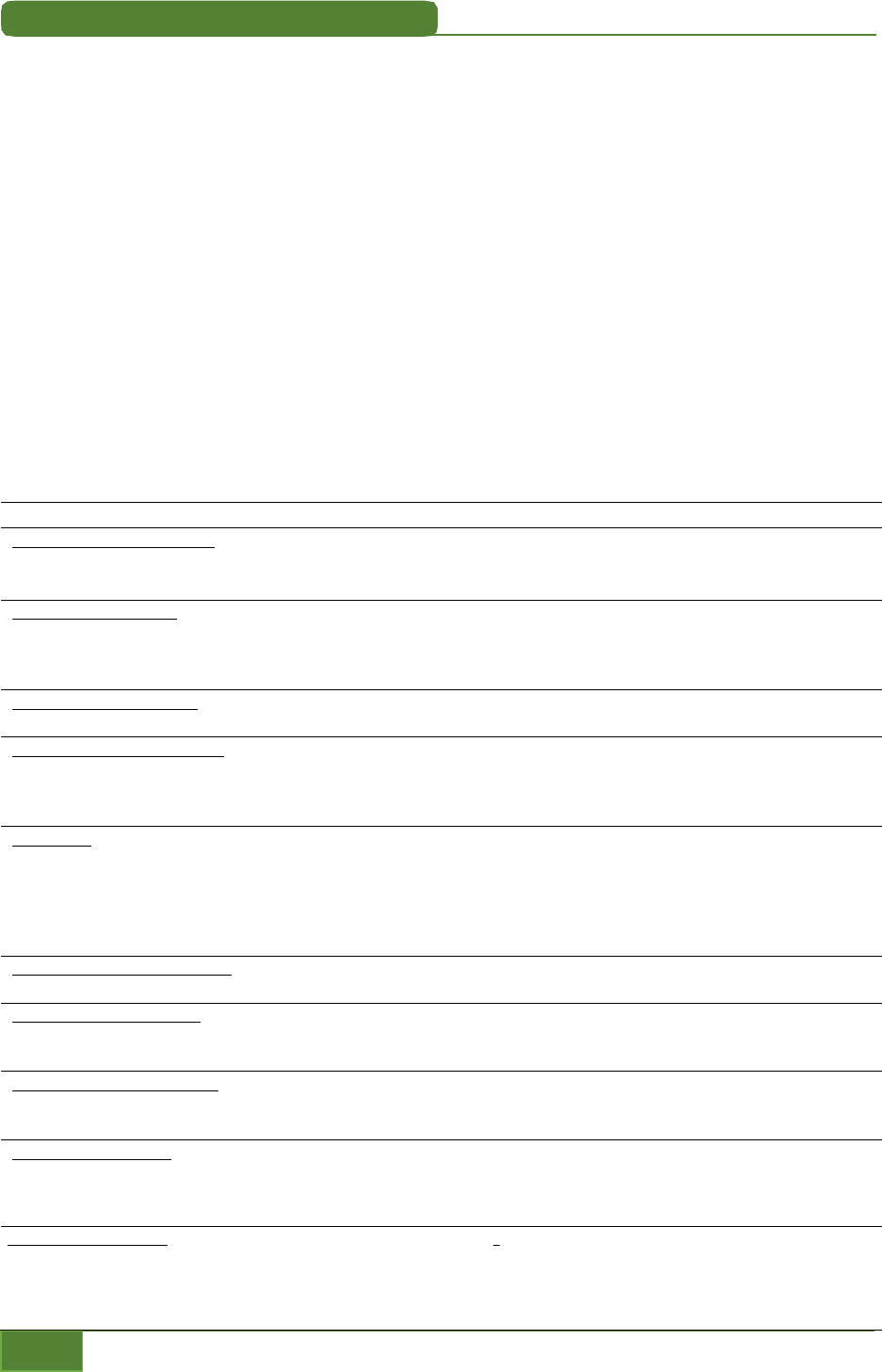
2. ACH Payment Processing
Green Book
A Guide to Federal Government ACH Payments
2-8
P
ayment Types
Types of payments that utilize the PPD standard entry class category include the following:
•
benefit,
•
annuity,
•
travel,
•
salary,
•
allotment,
•
IRS tax refund,
•
IRS (Advance Child Tax Credit), and
•
public debt payments.
Identifying the Paying Agency/Payment Type
Field 7 “Company Entry Description” (Company/Batch Header Record)
The first 2 positions are the Garnishment Exempt Indicator. The ~ symbol indicates a blank space. See section F for
additional details on the Garnishment Exempt Indicator.
Paying Agency/Payment Type Field Contents
Fiscal Service/TreasuryDirect
Marketable Securities / Savings Bonds
Government Series Security Payments
‘~~MISC PAY’
‘~~SLG_PMT ‘
Department of Treasury
Internal Revenue Service – Tax Refund
Internal Revenue Service (Economic Impact Payment
Internal Revenue Service (Advance Child Tax Credit)
‘
~~TAX REF ‘
‘~~TAXEIP#_’ (# = 1, 2, or 3)
‘~~CHILDCTC’
Central Intelligence Agency
CIA Annuity CIARDSANNU
Department of Veterans Affairs
Compensation and Pension
Insurance
Education
‘XXVA_BENEF’
‘XXVA INSUR’
‘XXVA _ _ _ _ _ _’ (Various values like ‘EDUC’, ‘CH35’, ‘1607’, etc.)
Federal Pay
Federal Salary
Federal Travel Payments
Federal Annuity
Federal Vendor/Misc
‘~~FED SAL ‘
‘~~FED TVL
‘~~FED ANNU’
‘~~MISC PAY’
Office of Personnel Management
Civil Service Retirement (Annuity) ‘XXCIV SERV’
Railroad Retirement Board
Railroad Retirement/Annuity
Unemployment/Sickness
‘XXRR RET ‘
‘XXRR UISI ‘
Social Security Administration
Social Security
Supplemental Security Income
‘XXSOC SEC ‘
’XXSUPP SEC’
Department of Defense
Marine Corps Salary
Current Use
‘~~
MCTF PAY’
Department of Defense
A
ir Force Military Pay
Army Military Pay
Future Use: N
ew descriptions to be implemented with the future
transition of payments from Dept of Defense to Treasury.
‘~~AIRF PAY’
‘~~ARMY PAY’
‘~~NAVY PAY’

2. ACH Payment Processing
Green Book
2-9
A Guide to Federal Government ACH Payments
Navy Military Pay
DoD Retired Pay
DoD Civilian Pay
DoD Vendor / Misc Pay
DoD Travel
‘~~RET PAY ‘
‘~~CIV PAY ‘
‘~~DOD MISC’
‘~~DOD TVL ‘
E: Identifying Non-Treasury Disbursed Payments
Identifying the Paying Agency/Payment Type
Field 7 “Company Entry Description” (Company/Batch Header Record)
Paying Agency/Payment Type Field Contents
Air Force
Active Duty
Active Duty Allotments
Annuity
Retirement
Retirement Pay Allotments
AF_PAY_J_ _
AF_MP_ALLT
AF_RET_PAY
AF_RET_PAY
AF_RP_ALLT
Army
Active Duty
Annuity
Reserve
Retirement
ARMYACTIVE
ARMY_BEN_ _
ARMY_RC_ _ _
ARMY_RET_ _
Navy
Active Duty
Active Duty Allotments
Annuity
Retirement
Retirement Pay Allotments
Reserve Drill Pay
NAVY_ACT_ _
NAVY_ALT_ _
NAVY_ANN_ _
NAVY_RET_ _
NAVY_RPA_ _
NAVY_RDP_ _
Identifying the Payee
Field 7 Contents (Entry Detail Record)
IF the payment type is …
THEN the Individual ID
Number field contents
identify the payee by…
IF the payment type is … THEN Field 7 contents
identify the payee by…
Air Force
Active Duty
Active Duty Allotment
Annuity
Individual's SSN
Individual's SSN
Individual's SSN
Reserve
Retirement
Retirement Pay Allotment
Individual's SSN
Individual's SSN
Individual's SSN
Army
Active Duty
Annuity
Individual's SSN
Individual's SSN
Reserve
Retirement
Individual's SSN
Individual's SSN
Marine Corps
Active Duty
Active Duty Allotment
Annuity
Letters "KR"
Individual's SSN
Individual's SSN
Reserve
Retirement
Retirement Pay Allotment
Individual's SSN
Individual's SSN
Individual's SSN
Navy
Active Duty
Active Duty Allotment
Annuity
Individual's SSN
Individual's SSN
Individual's SSN
Reserve
Retirement
Retirement Pay Allotment
Individual's SSN
Individual's SSN
Individual's SSN

2. ACH Payment Processing
Green Book
A Guide to Federal Government ACH Payments
2-10
F: Garnishment of Federal Benefits
Garnishment is the execution, levy, attachment, or other legal process involving a written
instruction issued by a court, a state or state agency, a municipality or municipal corporation or a
state child support enforcement agency. This includes a lien arising by operation of law for overdue
child support or an order to freeze the assets in an account, to impact a garnishment against a
debtor.
Financial institutions are subject to the requirements of title 31 of the Code of Federal Regulations,
part 212 (31 CFR part 212) which requires financial institutions to take certain actions upon
receipt of garnishment orders.
Fiscal Service has published the document “Guidelines for Garnishments of Accounts Containing
Federal Benefit Payments” that financial institutions can reference when a garnishment order is
received for an account into which federal benefit payments have been directly deposited.
Financial institutions that receive a garnishment order are required to determine the sum of
p
rotected federal benefits deposited to the account during a two month period, and ensure that the
account holder has access to an amount equal to that sum or to the current balance of the account,
whichever is lower.
Title 31 CFR part 212 applies to the following federal programs:
•
Social Security and Supplemental Security Income benefits administered by the Social Security
Administration;
•
Veterans benefits administered by the Department of Veterans Affairs;
•
Federal Railroad retirement unemployment and sickness benefits administered by the
Railroad Retirement Board; and
•
Civil Service Retirement System and Federal Employee Retirement System benefits
administered by the Office of Personnel Management.
To assist financial institutions, Fiscal Service is encoding an “XX” in Positions 54-55 of the
“Company Entry Description” field of the Batch Header Record for ACH/PPD and ACH/CCD
payments that are designated as federal benefit payments that are exempt from garnishment. This
encoding allows financial institutions to determine whether a federal direct deposit payment is an
exempt federal benefit payment. Financial institutions may rely on the presence of an “XX”
encoded in Positions 54-55 of the “Company Entry Description” Field to identify a federal
benefit payment exempt from garnishment.
EXAMPLES:
Company Entry Description (Positions 54-63)
Benefit Payment Type
Prior to the Garnishment Rule With the Garnishment Rule
Social Security SOC SEC XXSOC SEC
Supplemental Security Income SUPP SEC XXSUPP SEC
Railroad Retirement
RR RET
XXRR RET
Because it is possible that a commercial payment could also have an “XX” encoded in Positions 54-
55, financial institutions must verify that the payment is a federal payment. This can be confirmed

2. ACH Payment Processing
Green Book
2-11
A Guide to Federal Government ACH Payments
either by searching for a “2” in the “Originator Status Code” Field in the Batch Header Record
(Position 79) OR by reviewing the description of the payment in the ACH Batch Header Record
Company Entry Description to ensure that the payment is one of the exempt federal benefit types
shown in the Fiscal Service publication “Guidelines for Garnishments of Accounts Containing
Federal Benefit Payments”.

3-1
A Guide to Federal Government ACH Payments
3
Non-Receipt Claims
Overview
In this chapter…
A: General Information on ACH Non-Receipt Claims ......................................................................... 3-2
RDFI of a Direct Deposit Federal Payment ....................................................................................................... 3-2
B: Initiating a Formal Claim of ACH Non-Receipt ................................................................................ 3-3
C: Non-Receipt Process ................................................................................................................................ 3-3
Legal References Supporting Treasury Non-Receipt Investigation ........................................................ 3-4
ACH Non-Receipt Claims Process ......................................................................................................................... 3-4
Payment Trace Requests: Manual Non-Receipt Claims Process .............................................................. 3-5
This chapter describes the role(s) of the financial institution in resolving a claim of non-receipt for a
federal payment.

3-2
A Guide to Federal Government ACH Payments
3. Non-Receipt Claims
Green Book
A: General Information on ACH Non-Receipt Claims
It is imperative that Receiving Depository Financial Institutions (RDFI) review procedures for
posting payments and funds availability to ensure compliance with 31 CFR part 210 and Nacha
Operating Rules (See Chapter 2, Availability of Funds, for specific information about federal ACH
funds availability). Any RDFI can be held liable for ACH payments not processed timely or correctly.
If the federal government sustains a loss as a result of the financial institution’s improper handling
of an entry, the financial institution is liable to the federal government for the loss, up to the amount
of the entry.
It is extremely important that all RDFI personnel, especially branch, teller, and customer service
representatives are properly trained to locate payments, specifically those which are “memo
posted” or post prior to the settlement date. Close to 75 percent of “missing” federal payments are
at the RDFI when the recipient calls to inquire. Thorough research will limit misinformation and
subsequent unnecessary non-receipt claims and simultaneously increase confidence in Direct
Deposit as a payment method.
If the RDFI determines that it did not receive a payment, the benefit recipient may contact the
issuing agency to open a claim of non-receipt. The issuing agency in turn notifies the Fiscal Service.
Fiscal Service will initiate contact with the RDFI in an attempt to locate or resolve a claim of non-
receipt.
Note: Some federal payments may be reduced, in whole or in part, to pay a delinquent debt owed by
the payee to a federal or state agency. For more information about the Treasury Offset Program, visit
https://www.fiscal.treasury.gov/top/.
RDFI of a Direct Deposit Federal Payment
Role in response to customer inquiry on the status
The RDFI should make every reasonable attempt to locate a payment prior to redirecting a
recipient to the authorizing federal agency. RDFI employees should have an understanding of the
various posting techniques utilized to assist customers who are concerned with the status of their
direct deposit. RDFIs should be aware of the following situations that often result in unnecessary
non-receipt claims:
1.
Determine if the payment was posted late,
•
RDFI should be able to explain why there was a delay.
2.
Determine if the payment was memo posted,
•
RDFI customer service personnel may sometimes be unaware of, or do not check for
“memo posted” items. “Memo-posting” is a temporary credit applied to a payee’s
account during the day. Memo-posted transactions are finalized in the RDFIs end of day
processing.
3.
Determine if the payment was posted early,
•
Due to volume and processing considerations the RDFI may receive ACH payment files a
few days prior to their settlement dates. “Early posting” occurs when an RDFI posts a
payment to a recipient’s account prior to the settlement date.
4.
Determine if a third-party processor is used and confirm funds availability through
the processor,

3. Non-Receipt Claims
Green Book
3-3
A Guide to Federal Government ACH Payments
•
RDFI should confirm if the funds were made available to the recipient.
5.
Determine if the payment was an exception item,
•
The RDFI should be aware that a payment may have been posted incorrectly, manually
posted, or returned due to incorrect account information.
6.
In some instances, the RDFI may never receive a payment for the recipient.
Determine if the recipient has:
•
Changed financial institutions,
•
Revoked the Direct Deposit authorization,
•
Verified entitlement with the authorizing federal agency, and
•
A delinquent debt owed to a federal or state agency, which may have been submitted to
Fiscal Service for collection.
Note: The RDFI should process a NOC entry if they are responsible for the change information. The
RDFI may request the benefit recipient to update their information with the issuing agency if the
customer has a closed account, new account, etc.
Title 31 CFR 210.8(b)(2) specifically addresses the liability placed on RDFIs for the correct
preparation of ENRs and NOCs.
B: Initiating a Formal Claim of ACH Non-Receipt
If all efforts to locate the payment(s) have failed, the RDFI should instruct the recipient to file a non-
receipt claim directly with the authorizing federal agency. The table below lists federal agencies by
types of payments.
Type of Payment
Action
Federal Salary and allotments (including
military and civilian pay)
Military Active Duty allotments
Advise recipient to contact their payroll office.
Note: Coast Guard Active Duty and Allotments (785) 339-3506.
Military Retirement/Annuity/Allotments Advise recipient to contact the appropriate military branch.
Refer to Contacts, Chapter 7.
Travel Payments
TreasuryDirect
Advise recipient to contact their finance/ travel office
Refer to Contacts, Chapter 7
Vendor, Miscellaneous, and All Other
Payment Types
Advise recipient to contact the federal agency that authorized
the payment. Refer to Contacts, Chapter 7.
C: No
n-Receipt Process
Upon notification from the recipient that a payment has not been received, the authorizing federal
agency will notify the Fiscal Service. Fiscal Service will research the claim by either the ACH Non-
Receipt claim process, or by using the traditional FS Form 150.1, Trace Request Form, to determine
the status of the claim.

3. Non-Receipt Claims
Green Book
3-4
A Guide to Federal Government ACH Payments
Legal References Supporting Treasury Non-Receipt Investigation
1.
12 USC 3413(k)(2): Disclosure Necessary for Proper Administration of Programs of
Certain Government Authorities
12 USC 3413 (k)(2) of the Right to Financial Privacy Act provides: “Nothing in this title shall apply
to the disclosure by the financial institution of information contained in the financial records of any
customer to any government authority that certifies, disburses, or collects payments, where the
disclosure of such information is necessary and such information is used solely for the purpose of
... the investigation or recovery of an improper federal payment...”
2.
Title 31 CFR part 210.3(c): Federal Government Participation in the Automated Clearing
House (ACH)
Specifically, Title 31 CFR part 210.3(c) provides: “Any person or entity that originates or receives a
government entry agrees to be bound by this part and to comply with all instructions and
procedures issued by the Service under this part including the Treasury Financial Manual and the
Green Book.” This regulatory provision also points out that the Green Book is available on the Fiscal
Service website.
3.
Green Book, Chapter 4 Returns
The Green Book chapter on Returns states that: Unpostable payments must be returned so that
they are received by the government disbursing office ODFI no later than the opening of business
on the second banking day following the settlement date of the original entry. Under no
circumstances should a financial institution hold payments indefinitely in a suspense account, or by
any other means, nor should payments otherwise be held if any of the conditions apply on when to
return a payment. Holding payments may constitute a breach of the financial institution’s warranty
for the handling of federal government ACH payments under regulations codified in 31 CFR part
210.
ACH Non-Receipt Claims Process
Fiscal Service has partnered with several federal agencies to research Direct Deposit ACH non-
receipt claims. Fiscal Service representatives will contact the RDFI directly by telephone, email, or
facsimile to resolve claims of non-receipt. Fiscal Service has access to all the payment information
and will seek assistance in identifying the following checklist of items:
1.
Verification of payment status (posted, funds held, returned, etc.),
Question: Did the item in question post to the account number provided on the date of
payment?
2.
Verification that the intended payee received the payment,
Question: Does the payee’s name appear on the account?
3.
Situations where the recipient’s name is not on the account (If it is determined that an item
has posted to an improper account Fiscal Service will make a request for the return of those
funds subject to availability),
Question: C
an you provide the date the funds were returned, and the reason code used? Do you
require an R06 (Returned per ODFI Request) letter from Treasury to return these funds?
4.
Situations where the recipient did not receive the payment on settlement date, and
Question: Were the funds posted early or late, can the RDFI provide a reasonable explanation as
to why?

3. Non-Receipt Claims
Green Book
3-5
A Guide to Federal Government ACH Payments
5.
Payments posted manually, due to account closure or invalid account information.
RDFIs should originate a Notification of Change (NOC) entry if corrections are needed for future
payments. See Chapter 6, Notification of Change, and the Nacha Operating Rules & Guidelines for
detailed instructions.
Note: Fiscal Service may also request the name, mailing address and telephone number of the
improper recipient under the authority of 12 USC 3413(k) (Right to Financial Privacy Act of 1978).
When the reason for non-receipt has been determined, Fiscal Service will mail the recipient a letter
informing him/her of the resolution.
Keep in mind that RDFIs can be held liable for ACH payments not processed timely or correctly. If
the federal government sustains a loss because of a financial institution’s improper handling of an
entry, the financial institution is liable to the federal government for the loss, up to the amount of
the entry.
Payment Trace Requests: Manual Non-Receipt Claims Process
A sample FS Form 150.1, Payment Trace Request Form, is available in Chapter 9, Forms.
The FS Form 150.1 is used to trace all payments other than benefit payments. Upon receipt of a FS
Form 150.1, the RDFI should follow these steps:
1.
Verify the status of the payment in question, by making all attempts to locate the payment at
the RDFI,
2.
Credit the payment immediately if the payment was not previously credited or returned,
3.
Return the payment by ACH if it cannot be credited for any reason,
4.
Complete the FINANCIAL INSTITUTION ACTION section within three (3) business days of
receipt of the form by the RDFI,
5.
Return the DISBURSING OFFICE COPY to the government disbursing office identified on the
form, and
The RDFI must respond to Fiscal Service within three business days by completing and returning
t
he FS Form 150.1 to Fiscal Service as indicated on the form. Fiscal Service will verify acceptance of
the return.
•
If no reply is received, Fiscal Service will contact the financial institution and will pursue the
case until it is resolved. If Fiscal Service still receives no reply, a letter will be sent to the
President of the RDFI.
•
The authorizing federal agency may also contact the RDFI to resolve payment problems.
Keep in mind that the RDFIs can be held liable for ACH payments not processed timely or correctly.
If the federal government sustains a loss as a result of a financial institution’s improper handling of
an entry, the financial institution is liable to the federal government for the loss, up to the amount of
the entry.

4-1
A Guide to Federal Government ACH Payments
4
Returns
Overview
This chapter describes the return process for federal payments.
In this chapter…
A: General Information on Returns ......................................................................................................... 4-2
Return Reason Codes (ACH Credits) ................................................................................................................... 4-2
Death Notification Entry .......................................................................................................................................... 4-3
Effect of Returning a Payment ............................................................................................................................... 4-4
Notice of Misdirected Payment ............................................................................................................................. 4-4
Manual Posting of Payments .................................................................................................................................. 4-4
No Holding of Payments in Suspense Accounts ............................................................................................. 4-4
Recipients Without Current Accounts ................................................................................................................ 4-4
B: Returning Payments Through the ACH.............................................................................................. 4-5
ACH Correct Preparation of Returns .................................................................................................................. 4-5
Claim Number Structure Table ............................................................................................................................. 4-5
C: Returning Partial Payments in Response to Notices of Reclamation ...................................... 4-6
D: Dishonored Returns ................................................................................................................................ 4-7
Most Common Errors ................................................................................................................................................ 4-7
E: Payments Returned in Error; Obtaining a Refund due from the Government
..................... 4-8
Wh
at to do if a Payment was Returned in Error ............................................................................................ 4-8
Additional Information on TreasuryDirect Payments made in Error/Duplicate .............................. 4-9
SSA Program Service Centers ................................................................................................................................ 4-9
What to do if there are Duplicate Returns ...................................................................................................... 4-10
Restoring Funds ........................................................................................................................................................ 4-10

4-2
A Guide to Federal Government ACH Payments
4. Returns
Green Book
A: General Information on Returns
All ACH Payments must be returned in accordance with Nacha Operating Rules & Guidelines. An
ACH payment must be returned if:
•
An enrollment has been terminated and a new enrollment for the same recipient has not been
completed,
•
The financial institution receives a benefit payment after it has actual or constructive
knowledge of the death or legal incapacity of a recipient, including a representative payee,
•
The financial institution is honoring a Death Notification Entry (DNE) or other notification of
death from a federal agency,
•
The account has been closed by the recipient, or the financial institution has closed an account
to which benefit payments are being delivered after giving the recipient 30 days written notice
(except where fraud is suspected; then the account may be closed immediately),
•
There is no current account for the recipient, and
•
For any other reason the financial institution is unable to credit the payment to the account.
Return Reason Codes (ACH Credits)
The government can accept all Nacha-approved return reason codes. Following is a list of some of
the more common return reason codes that RDFIs use to return government credits:
• R02 Account Closed
• R03 No Account/Unable to Locate Account
• R04 Invalid Account Number Structure
• R06 Returned per ODFI’s Request
• R14 Representative Payee Deceased or Unable to Continue in that Capacity
• R15
Beneficiary or Account Hold (Other Than a Representative Payee) Deceased
• R
16
Account Frozen/Entry Returned Per OFAC Instruction
• R17
File Record Edit Criteria (Specify)/Entry with Invalid Account Number Initiated Under
Questionable Circumstances/Return of Improperly-Initiated Reversal
• R20
Non-Transaction Account
If you must return a federal payment for any reason not listed, use reason code “R20” on the return.
RDFIs that learn of the death of a recipient of benefit payments from a source other than the agency
are encouraged to use reason code R15 (Beneficiary or Account Holder Deceased) or R14
(Representative Payee Deceased) to notify government agencies of the death. By using these return

4. Returns
Green Book
4-3
A Guide to Federal Government ACH Payments
codes, the RDFI will satisfy both the requirement to return post-death payments that it receives
after actual or constructive knowledge of the death, and the requirement to notify the agency of the
death of the recipient.
RDFIs are able (but not required) to use Return Reason Code R17 – (File Record Edit Criteria /
Entry with Invalid Account Number Initiated Under Questionable Circumstances / Return of
Improperly-Initiated Reversal) to indicate that the RDFI believes an ACH Credit containing invalid
account information was initiated under questionable circumstances. This use of R17 is optional at
the discretion of the RDFI. Those RDFIs that elect to use R17 for this purpose are required to use the
description “QUESTIONABLE” in the Addenda Information field of the return. This description in an
R17 return differentiates returns that appear to be suspicious to the RDFI from those due to routine
account number issues.
Note: The existing Nacha-coordinated opt-in programs with federal and state tax agencies that allow
RDFIs to return questionable tax refund ACH credits using R17 will continue unchanged. These
programs will not be impacted by this additional optional use of the R17 Return Reason Code. Fiscal
Service and the IRS participate with Nacha in this program for IRS tax refund credit entries returned
as questionable. The Return Reason Code R17 will also continue to be used in its standard form for
returns involving required field errors. For more information-
https://www.nacha.org/content/irs-
refund-return-opt-program
Death Notification Entry
The Death Notification Entry (DNE) allows federal agencies to notify financial institutions of a
benefit recipient’s death. Only an agency of the federal government may originate a DNE. Currently,
SSA, OPM, and RRB originate DNEs. Other federal benefit agencies may originate DNEs at a future
date. The DNE is a zero-dollar entry with an addenda record. The addenda record contains the date
of death, the deceased individual’s SSN, and the amount of the next scheduled benefit payment.
Upon receipt of a DNE, the financial institution is encouraged to “flag” the deceased recipient’s
account to prevent accepting further post-death federal benefit payments. See below form common
errors with flagging.
Example: F
lagging Joint Accounts
A married couple own a joint account. One spouse dies. A DNE is sent from the federal benefit
agency to the RDFI. The RDFI receives the DNE and the account is “flagged”. The surviving spouse
becomes eligible for surviving spousal’s benefits, and a benefit payment is sent to the joint account.
Since the account is “flagged,” the RDFI improperly returns the surviving spousal’s benefits with a
reason code of R15 (beneficiary or account holder deceased). The agency receives the returned
benefit and processes an improper death termination for the surviving spouse. The agency also
sends an improper DNE for the surviving spouse to the RDFI.
Solution: To protect joint account holders, the account should be “flagged” with another piece of
identifying information (i.e., deceased name, SSN). This allows the joint account holder to continue
receiving their own payments. If this is not possible, a new account with a new Direct Deposit
authorization should be established.
Example: Flagging Erroneous Report of Death
A recipient is receiving benefits. An erroneous report of death is received by the federal benefit
agency for the recipient. A DNE is sent from the agency to the RDFI and the account is “flagged”. The
recipient discovers the problem and presents proof to the agency and the RDFI of the error in the
fact of death. The RDFI fails to remove the flagging from the account. The agency resends the
benefit payment to the recipient’s account, which is still “flagged”. The RDFI returns benefits with a

4. Returns
Green Book
A Guide to Federal Government ACH Payments
4-4
reason code for death of R15 (beneficiary or account holder deceased) to the agency based on the
erroneous flagging. The agency receives the returned benefit and re-processes the death
termination. The agency sends an improper DNE once again to the RDFI.
Solution: Always remember to remove any “flagging” on an account when a report of death proves to
be erroneous.
Note: If a financial institution needs to correct errors in their use of return reason codes when
returning funds, they should contact the agency receiving the return. Please see Chapter 7, Contacts,
for major paying agency contact information.
Effect of Returning a Payment
Any returned payment automatically revokes the Direct Deposit authorization and may stop further
payments from the federal agency to a recipient’s account. The recipient should contact the
authorizing federal agency to resume payments.
Notice of Misdirected Payment
In accordance with 31 CFR part 210, if an RDFI becomes aware that an agency has originated an
ACH credit entry to an account that is not owned by the payee whose name appears in the ACH
payment information, the RDFI shall promptly notify the agency. An RDFI that originates a NOC
entry with the correct account and/or RTN information or returns the original ACH credit entry to
the agency with the appropriate return reason code, shall be deemed to have satisfied this
requirement.
Manual Posting of Payments
Financial institutions may conduct a manual search of their unpostable ACH payments to determine
if the payment can be posted.
RDFIs may be held liable for ACH payments not processed timely or correctly. If the federal
government sustains a loss as a result of a financial institution’s improper handling of an entry, the
financial institution is liable to the federal government for the loss, up to the amount of the entry.
No Holding of Payments in Suspense Accounts
Under no circumstances should a financial institution hold unpostable incoming payments
indefinitely in a suspense account, or by any other means, nor should payments otherwise be held if
any of the conditions apply on when to return a payment. Holding payments may constitute a
breach of the financial institution’s warranty for the handling of federal government ACH payments
under regulations codified in 31 CFR part 210.
Recipients Without Current Accounts
Under normal circumstances a financial institution should not open a new account in response to an
unpostable payment. If the recipient closes the account and opens a new account, the recipient must
establish a new Direct Deposit authorization. If a recipient’s account has been closed, the financial
institution must return any subsequent payments made by the federal agency to the account. However,
when an account is closed due to fraud and a new account is opened at the same financial institution to
replace the account with fraudulent activity, then only an NOC is required."
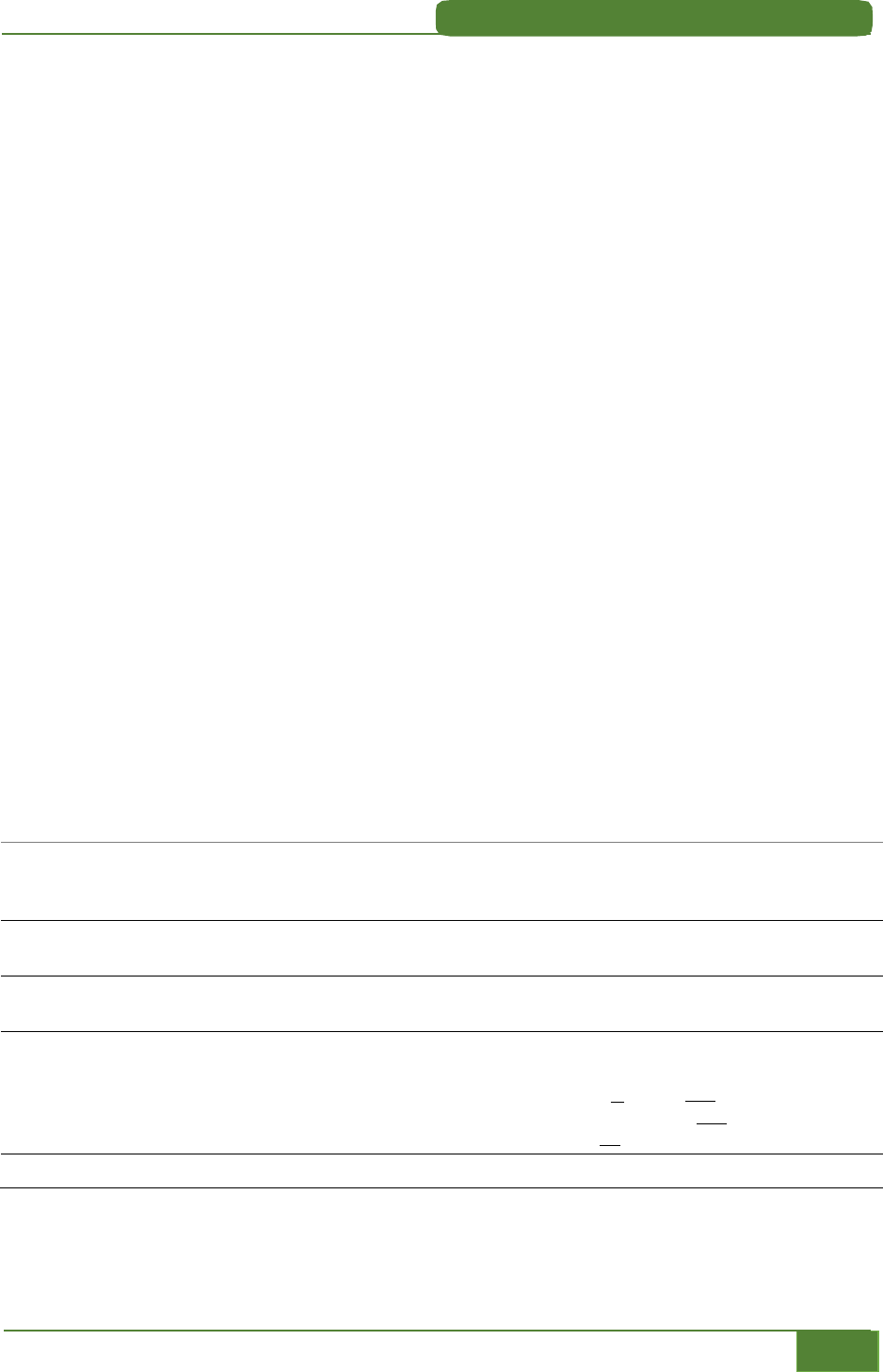
4. Returns
Green Book
4-5
A Guide to Federal Government ACH Payments
B: Returning Payments Through the ACH
ACH Correct Preparation of Returns
It is essential that RDFI employees preparing returns have access to data in the original item
originated by the government disbursing office. If a processor is used, RDFIs should be sure that the
return entry is properly formatted to include the data from the original entry.
“When a Return Entry is prepared, the original Company/Batch Header Record, the original Entry
Detail Record, and the Company/Batch Control Record are copied for return to the Originator”
(Nacha Operating Rules & Guidelines). If accurate data is not provided in the return entry, the
government disbursing office will dishonor the return.
The following four fields must be identical to the original payment data:
1.
Trace number (provided in the entry detail record),
2.
Effective entry date,
3.
Amount of payment, and
4.
Individual ID number (i.e., claim number. See the Claim Number Structure Table below).
Note: Financial institutions using data processors could receive reformatted data which may contain
errors or omissions. The original payment information must be used in its exact format to avoid
rejections.
Financial institutions should carefully track returned benefit payments to ensure that the returns
are not dishonored. This could create an additional liability for the financial institution in a
reclamation case.
Claim Number Structure Table
The following table represents correct claim number structures used in formatting returns.
AGENCY
CLAIM NUMBER STRUCTURE
EXAMPLE
Social Security Administration 999999999XX
999999999X
999999999
123456789C1
123456789A
123456789
Office of Personnel Management Xb9999999bXb
Xb9999999b9b
F_1234567_W_
A_1234567_0_
Department of Veterans Affairs 999999999b99b99
99999999b99b99
162306890_10_01
12345678_00_06
Railroad Retirement Board
Retirement/Annuity
Unemployment/Sickness
XXX999999999b9b
Xbb999999bbbb9b
XXbZZZZZ9bbbb9b
bbb999999999
WCA123456789_7_
A 123456 1_
WD_000006 8_
123456789
Department of Labor 999999999XXbXXb 123456789LW_MB_
Key: X = alphanumeric, 9 = numeric, b = blank, Z = zero filled, _ = space

4. Returns
Green Book
A Guide to Federal Government ACH Payments
4-6
C: Returning Partial Payments in Response to Notices of
Reclamation
Payments should be returned by ACH except in limited circumstances. If a partial payment is being
returned in response to a Notice of Reclamation (FS Form 133), a financial institution can elect to
either have their account debited for the partial payment, or, alternatively, returned by check. In no
other case should ACH returns be made by check, except as described in the Note below. Please
refer to Chapter 5, Reclamations, for more information including how to request an ACH debit
authorization.
Note: If the original payment data is not available, a financial institution may be forced to return an
ACH payment by check. The financial institution will receive credit. However, in these cases, credit will
be delayed due to manual processing. Note that under Nacha Operating Rules & Guidelines, records of
all entries including return and adjustment entries must be retained for six years from the date the
entry was transmitted.
If the financial institution is returning a payment that is beyond 6 years, the financial institution
may do so by mailing the check and related correspondence to the following address:
U
.S. Department of the Treasury
Bureau of the Fiscal Service
National Payment Integrity and Resolution Center
P.O. Box 51318
Philadelphia, PA 19115
The table below shows how to return a partial payment by check in response to a Notice of
Reclamation.
STEP
ACTION
1 Send the government disbursing office a check payable as indicated on item C-3b on the Notice of
Reclamation.
DO NOT SEND THE CHECK TO THE ORIGINATING FEDERAL AGENCY.
2 Attach a cover letter listing the following information for each payment subject to return:
• effective entry date,
• amount of payment,
• individual identification number (i.e., SSN/claim number), and
• reason for return.
If the above payment information is not available, provide the following information:
• recipient’s name,
• recipient’s SSN or other applicable federal government identification number,
• date of death, and
• name of originating federal agency.
The cover letter must always include:
• recipient’s name, and
• name of originating federal agency.
Provide the name, address, and telephone number of the financial institution contact.

4. Returns
Green Book
4-7
A Guide to Federal Government ACH Payments
D: Dishonored Returns
ACH return entries will be dishonored by the government disbursing office if discrepancies exist
between the data on the return item and the data on the original payment.
Most Common Errors
For Treasury-disbursed payments, four fields are read on return items. If any one of these four
fields are not identical to the original payment data, Treasury will dishonor the return.
The following four fields must be identical to the original payment data:
1.
Original Entry Trace Number (provide in the addenda record),
2.
Effective entry date (i.e., payment date),
3.
Amount of payment, and
4.
Individual ID number (i.e., claim number).
The discretionary data field on the return item should be left blank ONLY if it was blank in the
original ACH entry. If the field contains data in the original entry, the exact same data must be
included in the return entry.
Note that a VA claim number may be an 8-digit number with a blank in the leading space of the
individual ID field. If the space is ignored, and the number is left-justified, the return will be
dishonored. (See the claim number structure table on page 4-5.)
If a financial institution receives a dishonored return, the financial institution should correct the
information in the return and originate a contested return in accordance with Nacha Operating
Rules & Guidelines.
Dishonored Return Codes:
•
R61 - Misrouted Return
•
R67 - Duplicate Return
•
R68 - Untimely Return
•
R69 - Field Errors (the error(s) will be identified in the Addenda Information field on the
dishonored file positions 59-79. The two-digit code, separated by an asterisk, will be written
for each error found.)
01 - Re
turn Contains Incorrect DFI Account Number
02 - Return Contains Incorrect Original Entry Trace Number
03 - Return Contains Incorrect Dollar Amount
04 - Return Contains Incorrect Individual Identification Number/Identification Number
05 - Return Contains Incorrect Transaction Code
06 - Return Contains Incorrect Company Identification Number
07 - Return Contains an Invalid Effective Entry Date
•
R70 - Permissible Return Entry Not Accepted
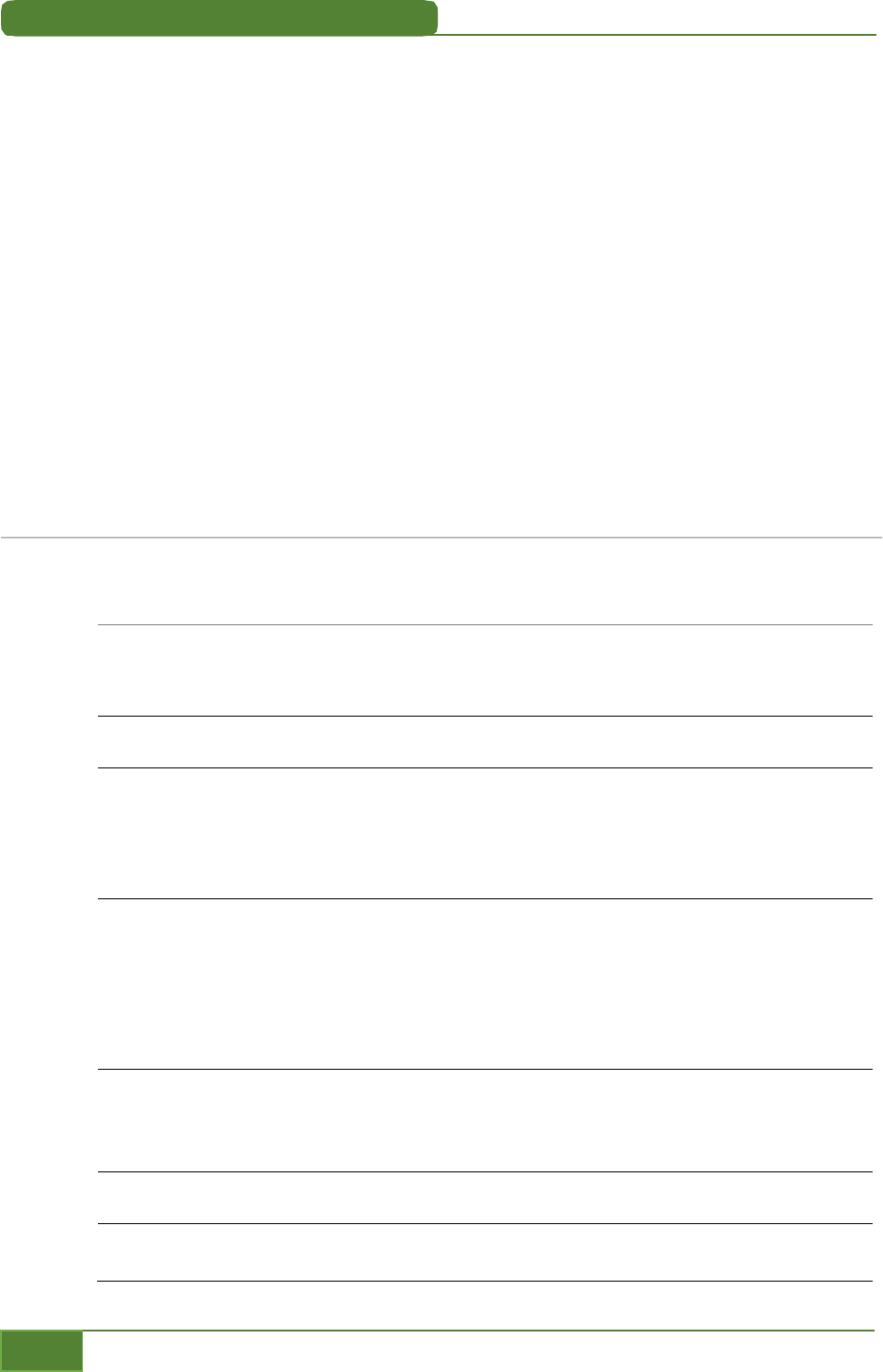
4. Returns
Green Book
A Guide to Federal Government ACH Payments
4-8
E: Payments Returned in Error; Obtaining a Refund due from
the Government
If a financial institution needs to correct errors in their use of reason codes when returning funds,
they should contact the agency receiving the return. Please see Chapter 7, Contacts, for major
paying agency contact information. Any payment returned for “death” will cancel both the Direct
Deposit authorization and the recipient’s entitlement to that payment.
If you are due a refund from the government under ACH, regardless of whether you have returned
too much, returned the wrong item(s), or the government debited you too much (e.g., on an ACH
reclamation), follow these instructions to claim your refund.
Please note that the RDFI is not required to advance credit to the recipient for a payment returned
in error. However, if the RDFI did advance credit, it should state this in any communication with the
federal agency.
What to do if a Payment was Returned in Error
ACTION STEPS
1. Contact the federal agency that authorized the payment. Do not contact the government
disbursing office.
Payment Type
Contact
OPM Annuity
(formerly Civil Service Retirement)
“CIVIL SERV”
U.S. Office of Personnel Management
P.O. Box 45
Boyers, PA 16017
(724) 794-2005
Social Security
“SOC SEC”
SSA Program Service Center (Refer to SSA Program Service
Centers section in this chapter for appropriate addresses).
Supplemental Social Security Income
“SUPP SEC”
Social Security Administration
Certification and Accounting Branch, Analyst
Room 3-A-2 East High Rise Building
6401 Security Boulevard
Baltimore, MD 21235
(410) 966-5353
Fiscal Service
“TreasuryDirect”
Bureau of the Fiscal Service
Treasury Retail Securities Services
P.O. Box 9150
Minneapolis, MN 55480-9150
(844) 284-2676
Note: Include with your letter a debit advice, Return Item- Credit Form, and any other documents that
confirm the duplicate or erroneous return.
VA Compensation or Pension
“VA BENEFIT”
None.
Note: Payments returned to the VA in error cannot be recalled. They will be reissued to the recipient’s
home address.
Railroad Retirement Board Railroad Retirement Board Direct Deposit Coordinator
(312) 751-4704
For all other payment types The federal agency’s local office listed in the telephone
directory.

4. Returns
Green Book
4-9
A Guide to Federal Government ACH Payments
2.
Promptly notify the recipient of the error.
If you erroneously reported death on the ACH return, advise the recipient to contact the
o
riginating federal agency immediately to reactivate payments.
Advise the recipient that the returned payment may be sent via check to their home. Th
e
r
ecipient should contact the federal agency to ensure their current home address is on recor
d
and that payments are handled properly.
3.
Be aware that your incorrect notification of death to a federal authorizing agency (OPM,
SSA, RRB) may result in a DNE being sent by the agency.
If a DNE is received, be sure to remove any electronic indicator or flag that would automatically
return future payments to the account.
4.
Initiate a new enrollment to reactivate ACH payments. Please see Chapter 1, Enrollments,
for more information.
Note: A copy of the financial institution’s original enrollment form may be sent to the federal agency if all the
information is still correct.
Additional Information on TreasuryDirect Payments made in
Error/Duplicate
If a payment is made in error, or if a duplicate payment is made, the financial institution will receive
either a written or electronic notice from TreasuryDirect that will include the following:
•
deposit account name,
•
deposit account number,
•
date of the improper payment, and
•
amount of the improper payment.
SSA Program Service Centers
The Social Security Administration provides a listing of their regional Program Service Centers,
which includes each service centers telephone number at this link:
www.ssa.gov/representation/pct_contact_info_54older.htm.

4. Returns
Green Book
A Guide to Federal Government ACH Payments
4-10
What to do if there are Duplicate Returns
The table below shows what to do if there are duplicate returns.
IF . . .
THEN . . .
AND . . .
two identical ACH returns are
made for the same payment
the government disbursing office will
automatically return the duplicate return
no further action is required
by the financial institution.
an ACH return was sent, and the
same payment was returned by
check
the financial institution should promptly write a
letter of explanation to the federal agency that
authorized the payment and include copies of
the following:
• financial institution’s claim for a refund
• debit advice
• other documentation that confirms the
duplicate return/debit action
the financial institution awaits
further notification from the
authorizing federal agency.
Note: Only the federal agency
that authorized the payment
can make a refund.
the financial institution has been
debited (TFS, Notice of Debit) for
a payment that was already
returned
Restoring Funds
The authorizing federal agency will restore the funds after researching and verifying the request.
The restoration will be made by the method agreed upon by the federal agency, the financial
institution, and the recipient, with ACH being the preferred method.

5. Reclamations
Green Book
5-
1
A Guide to Federal Government ACH Payments
5
Reclamations
Overview
In this chapter…
Section 1: Background ......................................................................................................................................
5-
3
Payments Subject to Reclamation ........................................................................................................................
5-
3
Section 2: Liability of a Receiving Depository Financial Institution (RDFI) ...................................
5-
4
A: Full
Liability
.............................................................................................................................................................
5-
4
B: Limiting Liability ...................................................................................................................................................
5-
4
C: Calculating the Limited Liability Amount ....................................................................................................
5-
5
Table 2-A: Calculating the Limited Liability Amount .....................................................................................
5-
5
Section 3: Reclamation Procedures ..............................................................................................................
5-
6
A: Notification of Death ............................................................................................................................................
5-
6
Title 31 CFR part 210 ....................................................................................................................................................
5-
7
What to do upon Notification of Death with Payments Already Posted and Subsequent Payments
.................................................................................................................................................................................................
5-
8
No Holding of Payments ...............................................................................................................................................
5-
8
Repayment by Survivors ...............................................................................................................................................
5-
8
Handling Survivor Requests not to Return Post-death Benefit Payments .............................................
5-
9
B: Notice of Reclamation .........................................................................................................................................
5-
9
Table 3-A: Notice of Reclamation (FS Form 133) .............................................................................................
5-
9
Sample of Notice of Reclamation (FS Form 133) ..............................................................................................
5-
9
Table 3-B: How to Respond to the Notice of Reclamation .............................................................................
5-
10
ACH Debit A
uthorizations ............................................................................................................................................
5-
11
Incomplete or Inadequate RDFI Replies ...............................................................................................................
5-
11
Section 1 defines reclamation and provides some background information on the subject.
Section 2 covers an RDFI’s liability in the reclamation process. Topics include full and limited
liability, calculating the limited liability amount, and exceptions to the liability rule.
Section 3 gives RDFI’s guidance on processing reclamations using the Automated Reclamation
Processing System (ARPS) utilizing Pay.gov and provides an updated contact list for individuals
needing additional information assistance with reclamations.

5. Reclamations
Green Book
5-
2
A Guide to Federal Government ACH Payments
Time Limits for Federal Reclamations. ............................................................................................................... 5-
12
Follow-up to the Notice of Reclamation (Fiscal Service-
2942)
................................................................. 5-
13
Federal Agency Collection from Withdrawers ................................................................................................ 5-
13
Debit of the RDFI’s
Account
..................................................................................................................................... 5-
13
Table 3-C: Debit of the RDFI’s Account ............................................................................................................... 5-
13
How to Identify Debits using the Reclamation Ticket Number ................................................................ 5-
14
Table 3-D: Transaction Codes for ACH Reclamations .................................................................................. 5-
14
C: Errors in Death ...................................................................................................................................... 5-
15
If the Person did not Die ........................................................................................................................................... 5-
15
Types of Evidence ....................................................................................................................................................... 5-
15
Table 3-E: Accepting the Proof ...............................................................................................................................5-
15
Table 3-F: Rejecting the Proof ............................................................................................................................... 5-
16
Restarting
Payments
.................................................................................................................................................. 5-
16
If the Date of Death is Wrong .................................................................................................................................. 5-
16
Learning of an Error After Completing a
Reclamation
.............................................................................. 5-
17
Table 3-G: Worksheet for Adjusting the Outstanding Total if the Date of Death is Wrong ....... 5-
17
D: Subsequent Notice of Reclamation ..................................................................................................... 5-
17
What to do .............................................................................................................................................................. 5-
17
Previous debit ....................................................................................................................................................... 5-
17
E: Contacts ...................................................................................................................................................... 5-
17
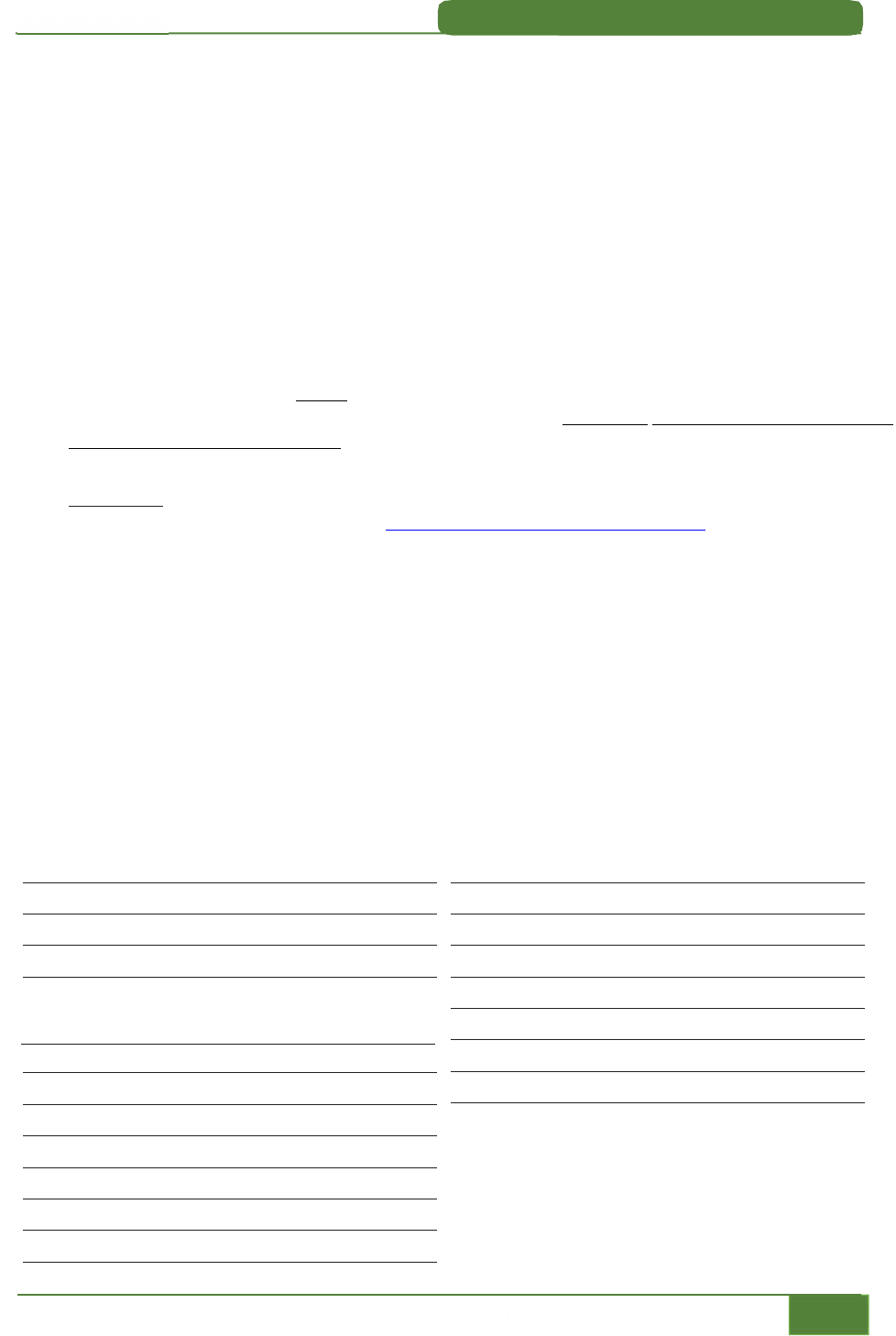
5. Reclamations
Green Book
5-
3
A Guide to Federal Government ACH Payments
Section 1: Background
Reclamation is a procedure used by the federal government (government) to recover benefit
payments made through the ACH to the account of a recipient who died or became legally
incapacitated or a beneficiary who died before the date of the payment(s).
The government’s right to reclaim funds is established in the United States Code, including at 31
U.S.C. § 3720 and implemented in Title 31 of the Code of Federal Regulations part 210, subpart B,
and section 210.10(a). The government’s reclamation process is found in 31 CFR 210.9 through
210.14. The reclamation provisions of 31 CFR part 210 completely preempt the reclamation
provisions of the Nacha Operating Rules & Guidelines with respect to federal benefit payments.
Effective January 1, 2023
• All reclamation responses must be submitted through the Automated Reclamation Processing
System (ARPS) located in Treasury’s Pay.gov web portal (except for responses by DFAS and any
Treasury-approved exceptions). Note: We will no longer accept remittances related to
reclamation responses.
• Exceptions: All exceptions must be approved on a case-by-case basis by Bureau of the Fiscal
Service and requests may be sent to: pfc-reclamations@fiscal.treasury.gov
By accepting a recurring benefit payment from the government, an RDFI agrees to the provisions of
31 CFR part 210, including the reclamation and debiting of the RDFI’s FRB master account for any
reclamation for which it is liable. The RDFI also agrees to the liability provisions of the federal
reclamation regulations found in 31 CFR part 210, subpart B, and affirms this agreement each time
the RDFI accepts and credits an ACH payment on behalf of a depositor.
Note: In this chapter, “death” always means the death or legal incapacity of a recipient or the death of
a beneficiary. And “government” always means the federal government.
Payments Subject to Reclamation
Only government benefit payments are subject to reclamation.
Payments Subject to Reclamations Payments not Subject to Reclamations
Social Security benefit or disability (SSA)
Supplemental Security Income (SSI)
Black Lung disability (Dept. of Labor)
Military and Coast Guard retirement, including
allotments from military retired pay (DoD)
C
ivil Service annuity (OPM)
Veterans Administration benefits (VA)
Railroad Retirement Board (RRB) annuity
US Coast Guard
Worker's compensation (FECA)
DC Pensions
Compensation Act (Dept. of Labor)
Any other federal retirement or annuity
Federal salary, allotments, and travel payments
U.S. savings bond payments
Vendor/miscellaneous payments
IRS tax refunds
Discretionary allotments
Public debt payments (TreasuryDirect)
Other types of federal ACH payments
Note:. For post-death payments not affected by
reclamation, adjustments must be made between
the authorizing federal agency and the
recipient’s survivors or estate.

5. Reclamations
Green Book
5-
4
A Guide to Federal Government ACH Payments
Section 2: Liability of a Receiving Depository Financial
Institution (RDFI)
A: Full Liability
An RDFI is liable for ALL benefit payments received after the death or legal incapacity of a recipient
or death of a beneficiary, unless the RDFI meets the qualifications for limiting its liability (see B.
Limiting Liability below).
If the RDFI fails to meet the qualifications for limiting its liability, the RDFI will be held liable for all
post-death benefit payments received after the death or legal incapacity of a recipient or death of a
beneficiary. The RDFI will be debited for the full amount of the reclamation. This debit action will
be final, with the exception of a valid protest.
Note: If no post-death benefit payment has been received at the time the RDFI learns of the death, the
RDFI may also contact the paying agency (see Contacts, Chapter 7).
B: Limiting Liability
An RDFI may qualify to limit its liability if it:
•
certifies it did not have actual or constructive knowledge* of the recipient’s death or incapacity
at the time of the deposit of any post-death benefit payments,
•
returns all post-death benefit payments it receives after it learns of the recipient’s death (but
not post-death benefit payments it received before it learned of the death), and
•
adequately responds to the Fiscal Service Form FS Form 133, “Notice of Reclamation,” within
60 calendar days from the date of the notice by using the Automated Reclamation Processing
System (ARPS).
Exception: Only reclamation responses by DFAS and any Treasury-approved exceptions
(evaluated on a case-by-case basis) are not required to respond using ARPS. Note that these
responses must meet all other requirements for limiting liability, including receipt by Fiscal
Service within 60 days.
*Not
e: In this chapter “constructive knowledge” of the death means that the RDFI would have learne
d
o
f the death if it had followed commercially reasonable business practices. “Actual or constructive
knowledge” is defined in Treasury’s regulations at 31 CFR § 210.2(b).
Exception to Liability Rule
An RDFI will not be held liable for post-death benefit payments sent to a recipient acting as a
representative payee or fiduciary on behalf of a beneficiary in the event that the beneficiary dies. In
this situation, the paying agency will not initiate a reclamation but will instead pursue recovery of
any post-death benefit payments from the representative payee.
Requirement to Return Post-Death Benefit Payments
It is important to understand that once a payment has been credited to payee’s account, it becomes
the property of the account holder. In the case of post-death payments, the payments become
property of the joint account holder or decedent’s estate. The government cannot legally authorize
or direct an RDFI to take funds already credited to an account and return them to the government.
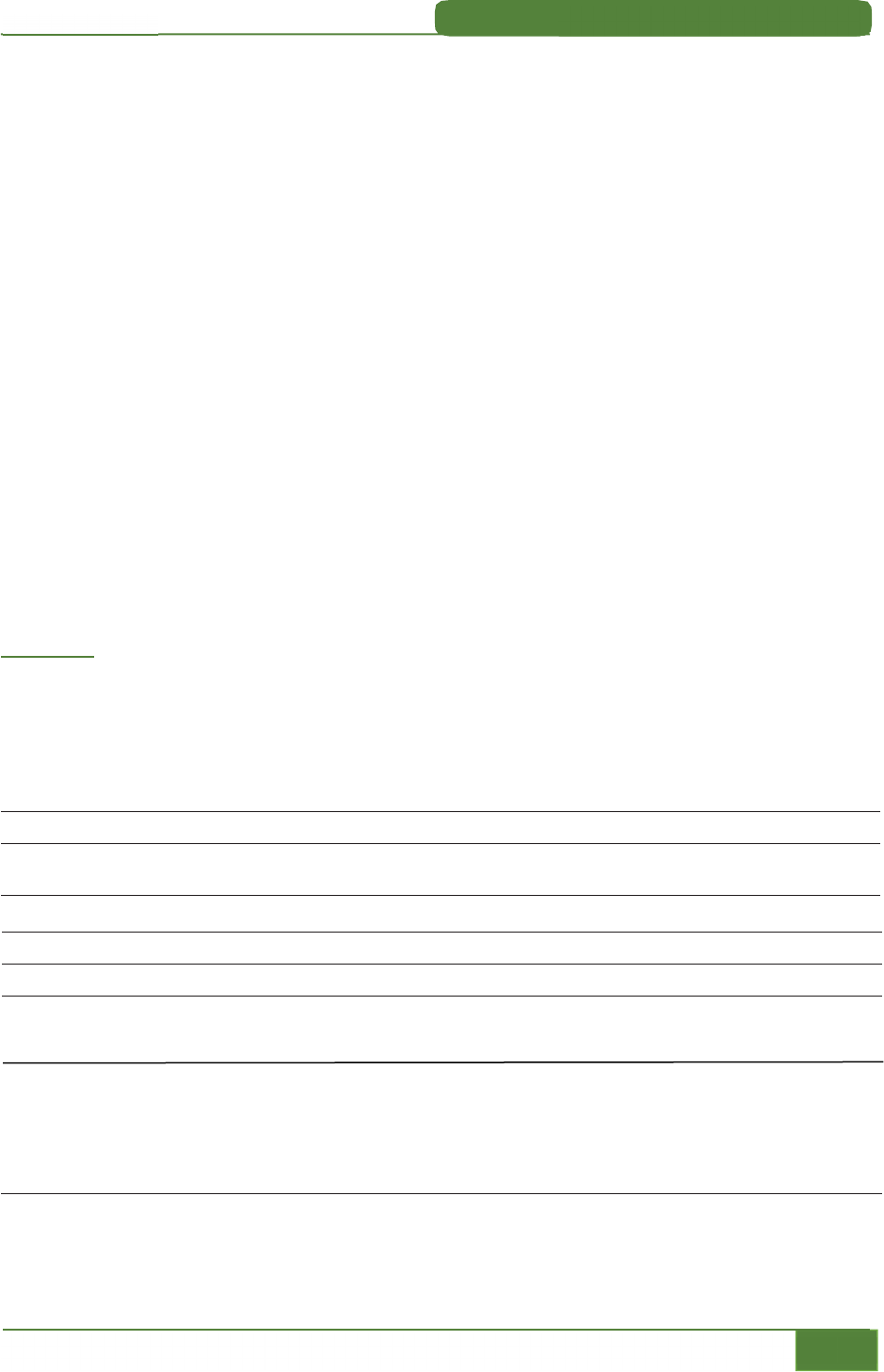
5. Reclamations
Green Book
5-
5
A Guide to Federal Government ACH Payments
This is the reason that RDFIs are directed only to return post-death payments that they receive
after they become aware of the payee’s death, using an R14 or R15 return reason code. Such returns
are legally permissible because the payments have not been credited to the recipient’s account and
therefore have not become property of the joint account holder or decedent’s estate.
It is up to each RDFI to consider its policy as an institution as to what steps it may wish to take, if
any, upon learning of the death of a recipient in order to preserve funds in the account pending
receipt of a Notice of Reclamation. Some RDFIs, upon becoming aware of an account holder’s death,
perform an account analysis before receiving an NOR and voluntarily return post-death payments
that were credited to the account before the RDFI learned of the death. RDFIs are cautioned that
Fiscal Service does not authorize or direct RDFIs to debit or otherwise affect the account of a
recipient, including to return post-death payments already credited to an account. However, Fiscal
Service will accept pre-NOR returns of post-death payments provided that they are made
electronically using an R14 or R15 code.
C: Calculating the Limited Liability Amount
If an RDFI qualifies for limited liability, the RDFI will only be debited for the ACH 45-day amount.
The ACH 45-day amount is the dollar amount of the post-death benefit payments received within
45 calendar days following the death.
Note: The limited liability amount may not exceed the outstanding total on the Notice of Reclamation.
The outstanding total is the total amount of all the post-death benefit payments.
Table 2-A: Calculating the Limited Liability Amount
Example 1: Four payments of $200 each were received after death. The first benefit payment
was received within 45 days after the date of death (i.e., ACH 45-day amount = $200). The RDFI had no
actual or constructive knowledge at the time the post-death benefit payments were received or
withdrawn.
1
No additional benefit payments were received after the RDFI had knowledge
of Reclamation
2
Scenarios 1-5 Scen.1
Scen.2
Scen.3
Scen.4
Scen.5
Total Amount of post-death payments on the Notice of Reclamation $800 $800 $800 $800 $800
Amount of the Account Balance paid by RDFI in response to the Notice
$300
$300 $750 $0 $800
Amount due from withdrawers $500 $500 $50 $800 $0
Amount collected by government from withdrawers $250 $500 $0 $0 $0
Outstanding total $250 $0 $50 $800 $0
Amount to be debited from the RDFI's federal reserve account = $200
(lesser of Outstanding Total or ACH 45-day amount)
$0 $50 $200 $0
1
RDFI had no actual or constructive knowledge of the death at the time of deposit or withdrawal of any post-death
benefit payments.
2
RDFI accurately responds to the Notice of Reclamation so that the appropriate amount is received by the
government disbursing office within 60 calendar days of the date on the Notice.

5. Reclamations
Green Book
5-
6
A Guide to Federal Government ACH Payments
Example 2: Four payments of $200 each were received after death. Three of the benefit
payments were received before the RDFI had actual or constructive knowledge of the death. The 4th
benefit payment was received by the RDFI after it had received a DNE and the RDFI promptly returned
the payment using an R15 return reason code.
1
The 1st and 2nd benefit payments were received within
45 days following the date of death (4th benefit payment will not be listed on the Notice of
Reclamation since it was promptly returned by the RDFI).
of Reclamation
2
(lesser of Outstanding Total or ACH 45-day amount)
1
RDFI is obligated to return any post-death benefit payments that the RDFI receives after becoming aware of the
recipient’s death. RDFI is not obligated or authorized to return post-death benefit payments that the RDFI received before
becoming aware of the recipient’s death.
2
RDFI accurately responds to the Notice of Reclamation so that the appropriate amount is received by the government
disbursing office within 60 calendar days of the date on the Notice.
Section 3: Reclamation Procedures
A: Notification of Death
An RDFI must immediately return any post-death benefit payments received after the RDFI
becomes aware of the death or legal incapacity of a recipient (but not post-death benefit payments
that the RDFI received before becoming aware of the recipient’s death). If the RDFI learns of the
death or legal incapacity of a recipient from a source other than the federal agency, the RDFI must
notify the sending agency of the recipient’s death. An ACH return using return reason code R15 or
R14 constitutes proper notification to the federal agency. When returning payments, the RDFI
should ensure that the date of death in the addenda record be in YYMMDD format. The RDFI should
also provide notification to the account owners, as a courtesy.
Scenarios 1-5 Scen.1
Scen.2
Scen.3
Scen.4
Scen.5
Total Amount of post-death payments on the Notice of Reclamation $600 $600 $600 $600 $600
Amount of the Account Balance paid by RDFI in response to the Notice
$300
$300 $550 $0 $600
Amount due from withdrawers $300 $300 $50 $600 $0
Amount collected by government from withdrawers $50 $300 $0 $0 $0
Outstanding total $250 $0 $50 $600 $0
Amount to be debited from the RDFI's federal reserve account =
$250
$0 $50 $400 $0

5. Reclamations
Green Book
5-
7
A Guide to Federal Government ACH Payments
Notification of death of a recipient by any source constitutes notification for all federal benefit
payments received by that recipient. The following are some examples of ways that the RDFI may
learn of the death of their account holders:
•
Receipt of a Death Notification Entry (DNE) - A DNE is a notification of a benefit recipients
death sent from an originating government agency (e.g., SSA, RRB, or OPM) to the RDFI,
•
Receipt of a federal government Notice of Reclamation, (FS Form 133),
•
Any contact or request to withdraw funds from an Estate, Executor, Administrator, Public
Administrator, Personal Representative, Conservator or other representative of such Estate.
Note: Any release to an executor or other party clearly acting on behalf of the deceased
person or their estate will be deemed by the government to have demonstrated the RDFI’s
knowledge of the death,
•
A pertinent reference to or from a Probate Court, a funeral home, or Letters Testamentary.
•
Credible oral or written report of death,
•
Credible death information obtained by the RDFI’s inquiry into a dormant account, or
through other RDFI internal screening processes,
•
Credible personal awareness of the death by the RDFI’s staff, or
•
Credible death notice received in the mail from any source.
Not
e: If at the time the RDFI first receives information of death, all or part of the post-death benefit
payments have already been withdrawn from the account, the government does not authorize or
direct the RDFI to try to recover the funds from the withdrawer. If the RDFI does so, it acts under its
own authority in terms of its contract with its depositor or under state law.
Title 31 CFR part 210
This regulation defines when a federal agency as well as an RDFI has actual or constructive
knowledge of the death:
A federal agency or RDFI has actual knowledge of the death or legal incapacity of a recipient, or the
death of a beneficiary, when it receives information, by whatever means, of the death or legal
incapacity and has had a reasonable opportunity to act on such information or that the federal
agency or RDFI would have learned of the death or legal incapacity if it had followed commercially
reasonable business practices. See 31 CFR § 210.2(b).
The p
hrase “commercially reasonable business practices” is a flexible concept since, for
example, what is a commercially reasonable practice for a large bank may not be
commercially reasonable for a small rural bank, and vice versa.
In March 2020, Fiscal Service revised this definition to include parameters for when an agency is
presumed to have constructive knowledge of a death or legal incapacity. Specifically, a federal
agency is presumed to have constructive knowledge of a death or legal incapacity at the time it
stops certifying recurring payments to a recipient if the agency (1) does not re-initiate payments to
the recipient and (2) subsequently initiates a reclamation for one or more payments made to the
recipient. See 31 CFR § Part 210.2(b) This presumption is rebuttable in cases where an agency can
demonstrate that it stopped certifying recurring payments to a recipient for a reason other than
death.

5. Reclamations
Green Book
5-
8
A Guide to Federal Government ACH Payments
What to do upon Notification of Death with Payments Already Posted and Subsequent
Payments
When an RDFI receives actual or constructive knowledge of the death of a recipient, it must return
all subsequent post-death benefit payments, meaning all post-death payments received after the FI
learns of the death, to the government disbursing office using return reason code R15 or R14. The
RDFI must also notify the sending agency of the recipient’s death. An ACH return using return
reason code R15 or R14 constitutes proper notification to the federal agency of the recipient’s
death. An RDFI can, if they so choose, return by ACH any post-death benefit payments that were
already posted to the recipient’s account before the RDFI received actual or constructive
knowledge of death, by ACH, without waiting for a Notice of Reclamation, but the RDFI is not
required or directed to do so.
R
15 Beneficiary Deceased
The beneficiary is the person entitled to the benefits. In this case, there is no representative payee
or guardian involved.
R
14 Representative Payee (or Guardian) Deceased or Incapacitated
The representative payee (or guardian) is the person who receives benefit payments on behalf of
the (under aged or incapacitated) beneficiary. E.g., payment is payable to “John Doe, for [another
person]”.
Any information of the death of a representative payee that is received by the RDFI or any of its
employees, from whatever source, establishes the full legal liability for ALL SUBSEQUENT post-
death federal benefit payments from all agencies, as well as any post-death benefits in the account,
which the RDFI then allows to be withdrawn.
Note: Recipients may be receiving multiple benefit payments from the same or different federal
agencies. An RDFI should ensure that they are returning all federal benefit payments subject to
Reclamation. If a Financial Institution needs to correct errors in their use of reason codes when
returning funds, they should contact the agency receiving the return. Please see Chapter 7, Contacts,
for major paying agency contact information.
No Holding of Payments
Under no circumstances should an RDFI hold benefit payments indefinitely in a suspense account,
or by any other means, nor should benefit payments otherwise be held if any of the conditions
apply on when to return a benefit payment. Holding benefit payments may constitute a breach of
the RDFI’s warranty for the handling of federal government ACH payments under 31 CFR part 210
and could result in an RDFI’s inability to limit its liability.
Repayment by Survivors
If the survivors or other withdrawers state that the withdrawn post-death benefit payments have
already been repaid to the federal agency, the RDFI should obtain a front and back copy of the
check(s) and/or a receipt from the federal agency.
If all post-death benefit payments have been repaid by the survivor(s), the RDFI should not receive
a Notice of Reclamation. However, if a Notice of Reclamation is received, the RDFI must complete
the electronic FS-133 in ARPS within 60 calendar days. The RDFI is not liable for any post-death
benefit payments that have already been repaid to the originating agency.

5. Reclamations
Green Book
5-
9
A Guide to Federal Government ACH Payments
Handling Survivor Requests not to Return Post-death Benefit Payments
The RDFI may be asked by the survivor(s) not to return post-death benefit payments because the
survivor believes he or she is entitled to all or part of the payment(s). In such cases, the RDFI should
still return the benefit payment and advise the survivor(s) to contact the appropriate federal
benefit agency (see Chapter 7, Contacts) to determine whether a final survivor payment is due.
B: Notice of Reclamation
The Notice of Reclamation (FS Form 133) initiates the recovery of post-death benefit payments that
have not been returned to the government, for which the RDFI may be liable.
The Notice of Reclamation is mailed or emailed to the RDFI by the government disbursing office
upon instructions from the authorizing federal agency. The RDFI’s address and routing number are
derived from the FOMF maintained by Treasury. Each RDFI is responsible for updating the FRB ACD
(see Chapter 2, FOMF). RDFIs should also provide updated email addresses as needed, to ensure
the timely receipt of Notices of Reclamation sent electronically.
Note: If the full amount listed on the reclamation is returned to the Disbursing Office, the RDFI does
NOT need to complete and return the FS Form 133.
Table 3-A: Notice of Reclamation (FS Form 133)
The Notice of Reclamation advises the RDFI of the following:
•
the date of death or legal incapacity,
•
the amount of post-death benefit payment(s) for which the RDFI may be liable, and
•
the identity of each benefit payment in question, including:
1. name of the recipient,
2. individual ID or claim #,
3. reclamation ticket #,
4. date of the payment(s),
5. Federal agency that authorized the payment(s)
and the type of payment(s),
6. payment trace number(s),
7. type of account (checking/savings) to which th
e
payment(s) was made,
8. depositor account number, and
9. amount of the payment(s).
The FS Form 133 consists of six parts (RDFI will receive Parts 1 through 5):
• Part 1- Program Agency Copy,
• Part 2- Program Agency File Copy,
• Part 3- RDFI Copy,
• Part 4- Disbursing Office Copy,
• Part 5- Notice to Account Owners Copy, and
• Part 6- Disbursing Office Pending Copy (RDF
I
does not receive Part 6).
Note: The reclamation ticket number is located in the top right box of the form to the right of the date
(see sample FS Form 133). It is important the RDFI retains a copy of the reclamation form submitted
via ARPS for a minimum of three years or until the associated case is closed. The RDFI should file the
notice using the reclamation ticket number. In the event that a debit is processed, the RDFI will need to
locate the Notice of Reclamation using the ticket number provided on the FRB Statement of Account
(see How to Identify Debits using the Reclamation Ticket Number).
Sample of Notice of Reclamation (FS Form 133)
A sample of the Notice of Reclamation form (FS Form 133) is available in Chapter 9, Forms. The
sample is the same for the Program Agency Copy, Program Agency File Copy, RDFI Copy and
Disbursing Office Copy.

5. Reclamations
Green Book
5-
10
A Guide to Federal Government ACH Payments
Table 3-B: How to Respond to the Notice of Reclamation
Steps to take Under Limited Liability
1.
If funds are available, but not sufficient to satisfy the full reclamation, a partial payment should be
remitted to the government disbursing office that issued the reclamation. When returning less
than the full amount, the RDFI must authorize a debit by using the Automated Reclamation
Processing System (ARPS) located in Treasury’s Pay.gov web portal.
2.
Promptly mail the notice to the account owners * last known address(es) and notify the account
owner(s) of any action that the RDFI has taken or plans to take against the account.
3.
When the RDFI is returning less than the outstanding total listed on the Notice of Reclamation,
the RDFI must complete and sign Certification No. 1*** and if the RDFI had no knowledge of the
death at the time the benefit payment(s) was received or withdrawn, also sign Certification No.
2**** on the back of the Disbursing Office copy of the Notice of Reclamation. The RDFI must
provide name, address and phone number of persons who withdrew from the account or if it is a
sole owner account the RDFI MUST complete all applicable fields in ARPS when limiting their
liability or retuning less than the total amount.
4.
If the outstanding total** was previously repaid to the federal government. The RDFI's obligation
to the federal government (e.g., by the beneficiary's survivor) has been satisfied and the RDFI
must return the Notice of Reclamation, attaching proof of the repayment, so that it is received by
the government disbursing office within 60 calendar days of the date on the Notice. (See Types
of Evidence).
5.
The signature in Certification No. 1*** and 2**** must be completed. The original signature
must include the signer's first name and last name. The signer's title and phone number must
be provided. If the Notice of Reclamation is incorrect due to error in fact or date of death, (see
Learning of an Error).
* Some withdrawers may wish to restore all or part of the withdrawn post-death benefit payments to the
a
ccount upon receipt of a Notice of Reclamation to Account Owners. Repayment to the account by th
e
w
ithdrawer upon receipt of the Notice of Reclamation is not required or requested by the government.
** The Outstanding Total is the sum of all federal benefit payments received after death or legal incapacity,
minus any amount returned to or recovered by the government.
***
Certification No. 1 on the back of the Disbursing Office copy of the Notice of Reclamation certifies that: the
Notice to Account Owners was sent; account owners were notified of any action the RDFI has taken or plans
to take against the account; and the RDFI took proper corrective action regarding any error in date of or
fact of death.
**** Certification No. 2 on the back of the Disbursing Office copy of the Notice of Reclamation, certifies that the RDFI
had no actual or constructive knowledge of the death at the time of deposit or withdrawal of any of the post-death
benefit payments; and, that the RDFI has returned the amount of the account balance to the government.

5. Reclamations
Green Book
5-
11
A Guide to Federal Government ACH Payments
ACH Debit
ACH Debit Authorization provided via Pay.gov permits Treasury to debit a financial institution’s
Federal Reserve account. A payment made by ACH debit will appear on the financial institution’s
Federal Reserve statement with an IAS transaction code of “57180 – Treasury ACH Reclamation FI
Auth”. There will also be a reclamation tracking number listed, which will aid a financial institution
when researching debit transactions. ACH debits are received the same day and are posted within
one (1) to two (2) business days of receipt.
A
utomated Reclamation Processing System (ARPS):
The Bureau of Fiscal Service has developed an electronic version of the current FS-133 process. This
process allows financial institutions to submit a response to the Notice of Reclamation (NOR)
electronically through the Department of the Treasury’s Pay.gov web portal.
How to electronically respond to an ACH Reclamation:
Electronic responses should be made through Pay.gov
, a web-b
ased application operated by the
Department of the Treasury that allows users to submit responses to a Notice of Reclamation. It also
allows the Financial Institution to make payments to government agencies by electronic means by
authorizing a debit.
1. When the FMS 133, Notice of Reclamation is received, the financial institution will continue to
follow its current procedures as stated in the Green Book (Chapter 5, Section 3, Reclamation
Procedures)
2. O
nce the FI is prepared to respond to the Notice of Reclamation; this response will be submitted
through the Pay.Gov web portal. This electronic version of the form requires the same informatio
n
a
s the paper version.
3. Responding through Pay.gov allows the financial institution to limit liability as well submit full or
partial payment(s) via a debit authorization.
In
complete or Inadequate RDFI Replies
If the RDFI’s response is inadequate, the government will send the RDFI a rejection via email,
indicating the reason for the disapproval. If no adequate response is received from the RDFI within
the allotted timeframe, the government will initiate a debit action for the outstanding amount.

5. Reclamations
Green Book
5-
12
A Guide to Federal Government ACH Payments
Time Limits for Federal Reclamations
1. INITIATION OF RECLAMATION (120-Day Protest): The authorizing federal agency must initiate the
r
eclamation within 120 calendar days after the date that the agency first has actual or constructive
knowledge of the death or legal incapacity of a benefit recipient or the death of a beneficiary.
An RDFI has the right to protest a Notice of Reclamation if it believes the agency did not meet th
e
d
eadline for initiating the reclamation.
A 120-day protest is filed by checking the appropriate box on the electronic form 133 in Automated
Reclamation Processing System (ARPS).
Upon receipt of the protest, the Fiscal Service will work with the authorizing federal agency to determin
e
w
hether or not the agency met the 120-day deadline. If the RDFI’s protest is valid, then the RDFI will be
notified via email within 45 days and the reclamation action will be withdrawn. If the protest is denied,
and the RDFI qualifies for limited liability, the Disbursing Office will notify the RDFI via email within 45
days and the RDFI will only be debited for the ACH 45-day amount.
2. SCOPE OF RECLAMATION: An RDFI is not liable for any post-death benefit payments made more than
six years prior to the date of the notice of reclamation, except under the following circumstance: “If th
e
ac
count balance at the time the RDFI receives the notice of reclamation exceeds the total amount of all
post-death or post-incapacity payments made by the agency during such six-year period, this limitation
shall not apply and the RDFI shall be liable for the total amount of all payments made, up to the amoun
t
i
n the account at the time the RDFI receives the Notice of Reclamation and has had a reasonabl
e
op
portunity (not to exceed one business day) to act on the notice.” [31 CFR part 210.10(d)]
3. COINCIDING WITH DATE OF DEATH: An RDFI is not liable for any benefit payment dated where
as
the effective date is the same as the date of death.
4. RDFI REACTION TIME: The RDFI, upon receipt of the government’s Notice of Reclamation, has UP TO
ONE BUSINESS DAY to react to that reclamation by determining the account balance, and by preventin
g
any further withdrawals of post-death government benefit payments from the account, if possible, under
the terms of the contract with the account holder.
RDFI RESPONSE DEADLINE: The RDFI has up to 60 calendar days from the issue date of the reclamation to
provide a full and accurate response to the proper government disbursing office. Failure to respond timely
may result in a debit to the RDFI’s FRB account or the account of its correspondent for the total amount of
the reclamation. This debit action will be final.
F
ollow-up to the Notice of Reclamation (Fiscal Service-2942)
A Follow-Up Notice is sent if the government disbursing office does not receive a response within
30 days of the FS Form 133, Notice of Reclamation; or if the RDFI’s response to the Notice of
Reclamation was incomplete or inaccurate.
A Follow-Up
Notice is a reminder to the RDFI that a response to the Notice of Reclamation (FS Form
133) must be received by the government disbursing office within 30 days of the date of the
Follow-Up Notice, or the RDFI will forfeit the right to limit its liability. The Follow-Up to the Notice
of Reclamation Form (FS Form 2942) is available in Chapter 9, Forms.
A copy of the original Notice of Reclamation is attached to the Follow-Up Notice
Responses to a Follow-Up Notice must be completed in ARPS (except for approved exceptions) in the
same manner as an original Notice of Reclamation.
Any questions regarding this matter should be directed to the government disbursing office shown
in the upper right corner of the Notice of Reclamation.
.
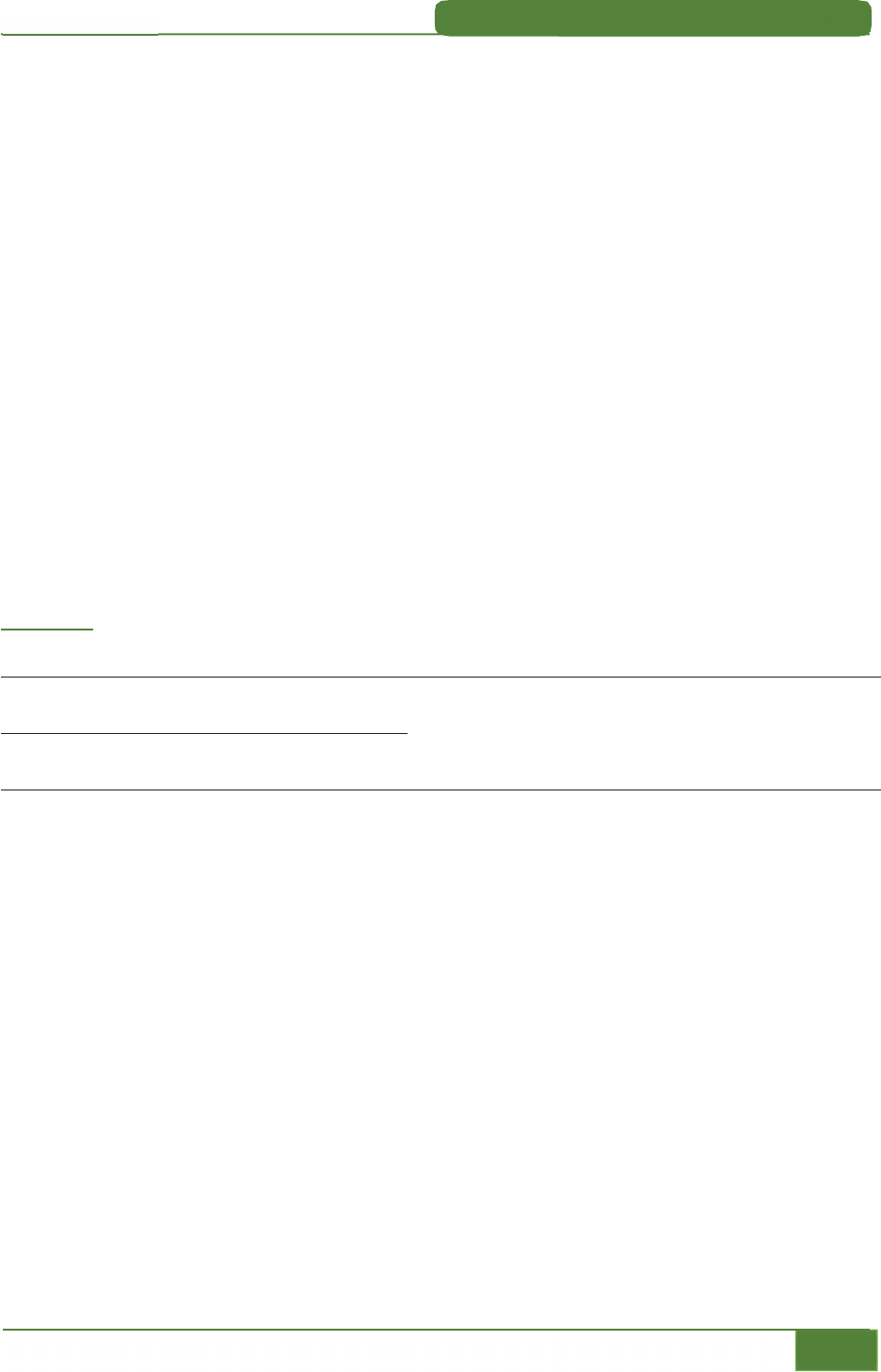
5. Reclamations
Green Book
5-
13
A Guide to Federal Government ACH Payments
Federal Agency Collection from Withdrawers
If all or part of the post-death benefit payments have been withdrawn from the account before the
RDFI learns of the death, and the RDFI properly responds to the Notice of Reclamation and is
qualified to limit its liability, then the Reclamation process will be temporarily suspended, and the
authorizing federal agency will attempt to collect the outstanding total from the withdrawer(s).
If the authorizing federal agency is unsuccessful in collecting the outstanding total from the
withdrawer(s), the RDFI or its correspondent’s FRB account will be debited (for the ACH 45-day
amount) not to exceed the outstanding total.
Debit of the RDFI’s Account
If the RDFI fails to respond completely and accurately to a Notice of Reclamation by the due date,
the government disbursing office will debit the RDFI’s FRB account or that of its correspondent
account for the full amount of its outstanding liability. This action is final.
If the RDFI responds completely and accurately to a Notice of Reclamation by the due date, and the
federal agency is unable to collect the balance on the FS Form 133, the RDFI will be debited for the
limited liability ACH 45-day amount.
T
he table below shows when the authorizing federal agency can exercise its authority to have an
RDFI’s FRB account debited.
Table 3-C: Debit of the RDFI’s Account
If the RDFI: Then the RDFI (or its correspondent's) FRB Account
Fails to respond accurately and completely to
the Notice of Reclamation.
Fails to respond within the 60-day time limit of
the Notice of Reclamation.
Responds accurately, completely, and timely,
(i.e., limited its liability) but the authorizing
federal agency can no longer collect the
outstanding total from the withdrawers.
will be debited for the outstanding total.
will be debited for the ACH 45-day amount not to exceed the
outstanding total.
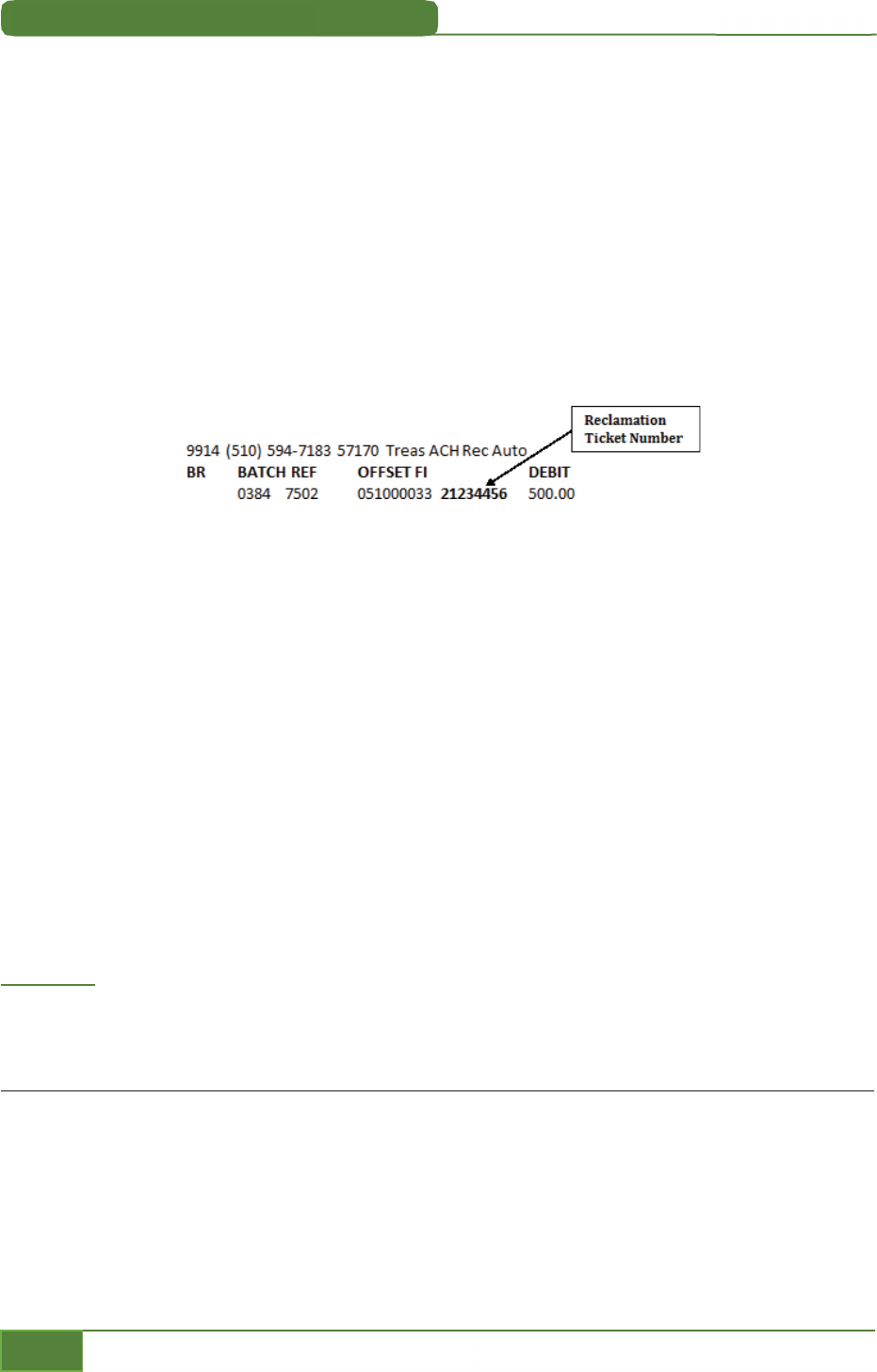
5. Reclamations
Green Book
5-
14
A Guide to Federal Government ACH Payments
How to Identify Debits using the Reclamation Ticket Number
When there is a liability for an ACH reclamation payment by an RDFI, the RDFI will receive a charge
to their FRB account. The reclamation ticket number will appear on the FI’s Statement of Account.
This ticket number is the same number as identified on the original FS Form 133, Notice of
Reclamation.
The FS Form 133, Notice of Reclamation form provides the reclamation ticket number in the top
right box of the form to the right of the date. This ticket number should be used to identify debits
for reclamations. Coordination between the ACH reclamation area and the RDFI accounting
department is critical to the reconcilement of the RDFI’s Statement of Account.
Provided below is an example of how the debit for ACH reclamations will appear on an FRB
Statement of Account:
Explanation of the Debit:
1) The number 9914 indicates an entry processed by FRB Philadelphia to an out of district bank,
2) The phone number of the payment center that initiated the debit will be provided - e.g., (510) 594-7183.
The phone number is also provided in the upper right-hand corner of the reclamation notice,
3) The number 57170 is the transaction code representing an automated debit on ACH reclamations from
th
e National Payment Center of Excellence (NPCE).is transaction code number will be unique for each
RFC (See Table 3-D),
4) The number 03884 represents a batch number,
5) The number 7502 represents a reference number,
6) The number 051000033 is the FRB Philadelphia routing number,
7) The number 21234456 is the Reclamation Ticket number. This will be unique for each reclamation and
is the same number as assigned on the original Notice of Reclamation form (FS Form 133), and
8) The dollar amount of the debit is indicated in the far-right hand column- e.g., 500.00.
Table 3-D: Transaction Codes for ACH Reclamations
The table below shows the unique transaction codes numbers for each Fiscal Service Portfolios.
Transaction
Code\Description
Definition Daylight Overdraft
Posting Times
57170
Treas ACH REC Auto
Debits for reclamation payments authorized by the Treasury
to post to a financial institution. These payments are
After close of
Fedwire
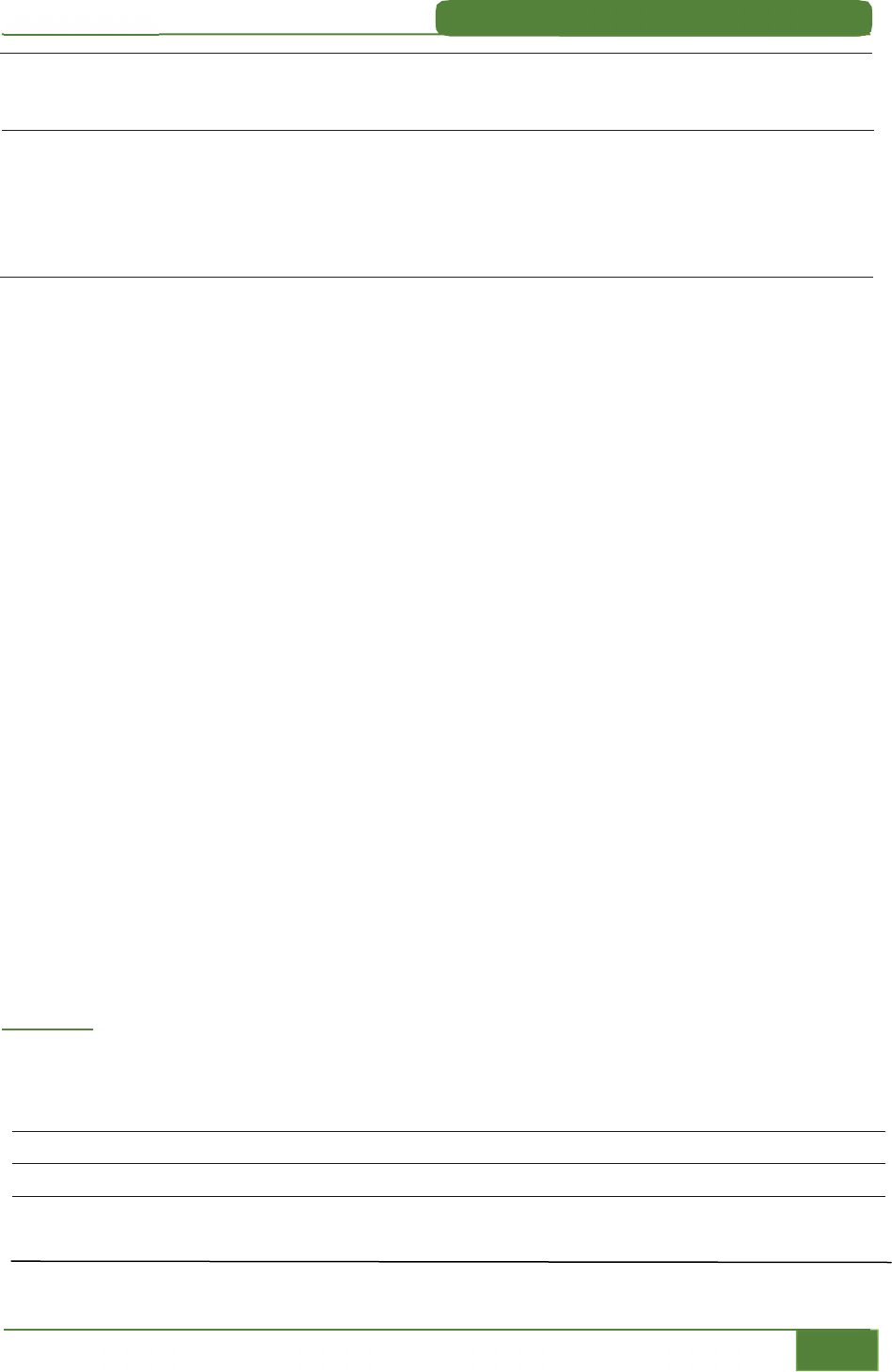
5. Reclamations
Green Book
5-
15
A Guide to Federal Government ACH Payments
57190
Treas ACH REC Auto
initiated to FRB Philadelphia by the Kansas City Federal
Disbursement Services Includes adjustments to such
entries.
Debits for reclamation payments authorized by the Treasury
to post to a financial Institution. These reclamation debits
are initiated to FRB Philadelphia by the Modernization,
Innovation, and Payment Resolution. Includes adjustments
to such entries.
After close of
Fedwire
C: Errors in Death
If the Person did not Die
If the RDFI obtains satisfactory proof that the benefit recipient or beneficiary is alive, the RDFI is
still required to respond to the Notice of Reclamation in the Automated Reclamation Processing
System. Failure to respond to the Notice of Reclamation will result in a debit to the RDFI or its
correspondent’s FRB account for the outstanding total. In this case, a debit can only be restored
after a verification process by the authorizing federal agency.
Types of Evidence
The following are acceptable types of proof for verifying that the person did not die:
•
Driver’s license, picture ID or other evidence similar to that required for cashing a check, if the
recipient or beneficiary appears at the RDFI,
•
A signed, dated, and notarized statement attesting to the fact that the recipient or beneficiary is
alive if, he/she is unable to appear at the RDFI, and
•
A written statement from the authorizing federal agency verifying that the recipient or
beneficiary is alive.
The RDFI is not obligated to accept the proof or to contact the authorizing federal agency if any
disagreements or questions arise with the person presenting the proof. Prudence is required, as the
action taken by the RDFI may impact its liability. Disagreements will be adjudicated by the
authorizing federal agency after it has been contacted by the person presenting the proof.
Note: If a Financial Institution needs to correct errors in their use of reason codes when returning
funds, they should contact the agency receiving the return. Please see Chapter 7, Contacts, for major
paying agency contact information.
Table 3-E: Accepting the Proof
The table below shows what actions the RDFI must take if it accepts the proof that the person did
not die.
Step Action
1. Within ARPS, select payee alive.
2. Digitally sign Certification #1 and Certification #2.
3. A signed, dated notarized statement attesting the fact that the payee is alive
DNE removal request
4. Written letter from agency (which we will confirm) stating payee is alive.

5. Reclamations
Green Book
5-
16
A Guide to Federal Government ACH Payments
5. Advise the recipient to contact the authorizing federal agency to restart payments.
Table 3-F: Re
jecting the Proof
The table below shows the actions the RDFI must take if it rejects the proof that the person did not
die.
Step Action
1. Continue to process the Notice of Reclamation, which includes sending the Notice of Reclamation t
o
a
ccount owner(s).
2. Refer the person presenting the proof to the federal agency.
3. Notify the account owner(s) to provide a written statement from the federal agency verifying that the
r
ecipient or beneficiary is alive, or the reclamation process will continue.
Restarting Payments
Once a reclamation has been processed, all further benefit payments will be stopped. Presenting
acceptable proof that the death report was in error (and stopping the reclamation process) does
not restart the monthly benefit payments. The recipient or beneficiary must contact the authorizing
federal agency to re-enroll in Direct Deposit.
If the Date of Death is Wrong
The RDFI is authorized to adjust the outstanding total, provided it obtains acceptable proof that the
date of death (DOD) shown on the Notice of Reclamation is wrong. When correcting a date of death
error, the RDFI should always check the appropriate box in ARPS, provide the correct DOD and
submit a death certificate via email to PFC-[email protected]sury.gov
Learning of an Error After Completing a Reclamation
If the RDFI learns of an error in the date of death after returning a completed Notice of Reclamation
and it has already satisfied its liability, it MUST contact the authorizing federal agency (based on the
payment type listed on the Notice of Reclamation) to make the appropriate adjustment.
If the RDFI is due a refund, the RDFI must provide supporting documentation to the authorizing
federal agency.
Note: Only the authorizing federal agency can make adjustments after the debit action has been
processed.

5-17
A Guide to Federal Government ACH Payments
5. Reclamations
Green Book
Table 3-G: Worksheet for Adjusting the Outstanding Total if the Date of Death is Wrong
The worksheet below may be used by the RDFI to calculate the adjusted total if there is an error in the
date of death.
PMT 1
PMT 2
PMT 3
PMT 4
List the month/day/year of each payment shown on the
Reclamation form.
For each payment (shown on the Reclamation) did the person die
before the date of the payment? (Enter "yes" or "no")
For each "yes", enter the dollar amount of the payment.
(Do not enter the dollar amount if "no.")
Total all "yes" payments $
(This is the adjusted outstanding total to use on the Notice of Reclamation).
D:
Subsequent Notice of Reclamation
The government may issue a subsequent Notice of Reclamation if the original Notice of Reclamation
did not list all post-death benefit payments.
A subsequent Reclamation may be issued if any of the following apply; the date of death was earlier than
shown on the original Notice of Reclamation, the account number changed, and/or the routing number
changed.
Wha
t to do if the RDFI receives a subsequent reclamation.
A
n RDFI receiving a subsequent Notice of Reclamation should respond as the RDFI would respond to an original
Notice of Reclamation.”
Previous debit
If the RDFI has already limited its liability and has been debited for the ACH 45-day amount on the
original reclamation case, it will not be debited again on a subsequent Reclamation for the same case.
However, in order to maintain its limited liability status, the RDFI must respond to all Notice of
Reclamations received to prevent a debit to the RDFI or its correspondent’s FRB account.
E: Contacts
For Pay.gov technical issues please contact: 800-624-1373 (Toll free, Option #2), 216-579-2112
(Option #2), pay.gov.cle[email protected], Hours 8:00am to 7:00pm Monday – F
riday.
F
or questions related to a Notice of Reclamation or general Notice of Reclamation inquiries, please
contact: (855) 868-0151
A
ny supporting documentation related to the Notice of Reclamation response (payee alive, incorrect
date of death, etc.) must be emailed to PFC-[email protected]
within 15 business days.

5-17
6-1
A Guide to Federal Government ACH Payments
Notification of
Change
In this chapter…
A: Introduction to Notification of Change .............................................................................................. 6-2
When to use NOCs ...................................................................................................................................................... 6-2
Benefit Payments ............................................................................................................................................................. 6-2
Other Payment Types ..................................................................................................................................................... 6-2
When to use NOCs, ENRs, or Other Ways to Change Recipient Information ...................................... 6-2
Processing Timeframes ............................................................................................................................................ 6-3
What to do if an agency does not respond to a NOC within two payment cycles: ............................ 6-3
Change Reason Codes ............................................................................................................................................... 6-3
Claim Number Structure .......................................................................................................................................... 6-4
Claim Number Structure Table ............................................................................................................................. 6-4
B: Other Change Methods ............................................................................................................................ 6-4
Financial Institution Actions .................................................................................................................................. 6-5
C: Refused Notification of Change ............................................................................................................. 6-7
Federal Agencies Using Refused NOCs ............................................................................................................... 6-7
Proc
essing Timeframes ............................................................................................................................................ 6-7
Refused NOC Codes .................................................................................................................................................... 6-7
6

6-2
A Guide to Federal Government ACH Payments
6. Notification of Change
Green Book
A: Introduction to Notification of Change
Notification of Change (NOC), which is the name for Nacha’s Standard Entry Class (SEC) code COR, is
a method used by a financial institution to notify a federal agency to correct or change account
information in an entry the federal agency processed through the ACH. Refer to current Nacha
Operating Rules & Guidelines for formats and instructions.
Note: ENRs should not be used in place of NOCs to correct account information. Please see Chapter 1,
Section F, Enrollment Guidance, for more information about when ENRs can be used.
When to use NOCs
NOCs are used for federal government (both civil and military) payments that are made on a
recurring basis. Examples are:
Benefit Payments
•
Benefit payments issued by Department of Veterans Affairs,
•
Civil service retirement payments issued by Office of Personnel Management,
•
Benefit payments issued by Railroad Retirement Board,
•
Social Security benefit payments, and
•
Supplemental Security Income payments.
Other Payment Types
•
Federal salary,
•
TreasuryDirect, and
•
Vendor and miscellaneous.
When to use CORs, ENRs, or Other Ways to Change Recipient Information
To change
Recipient would
Title/ownership of account
Interest of the recipient or beneficiary in the account
Complete a new enrollment
From one financial institution to another
New bank account number at the existing financial
institution
Submit ENR or COR
Name of recipient or change of mailing address Contact the federal agency that authorized the
payment
Account information for one-time payments One-time payments require a new authorization
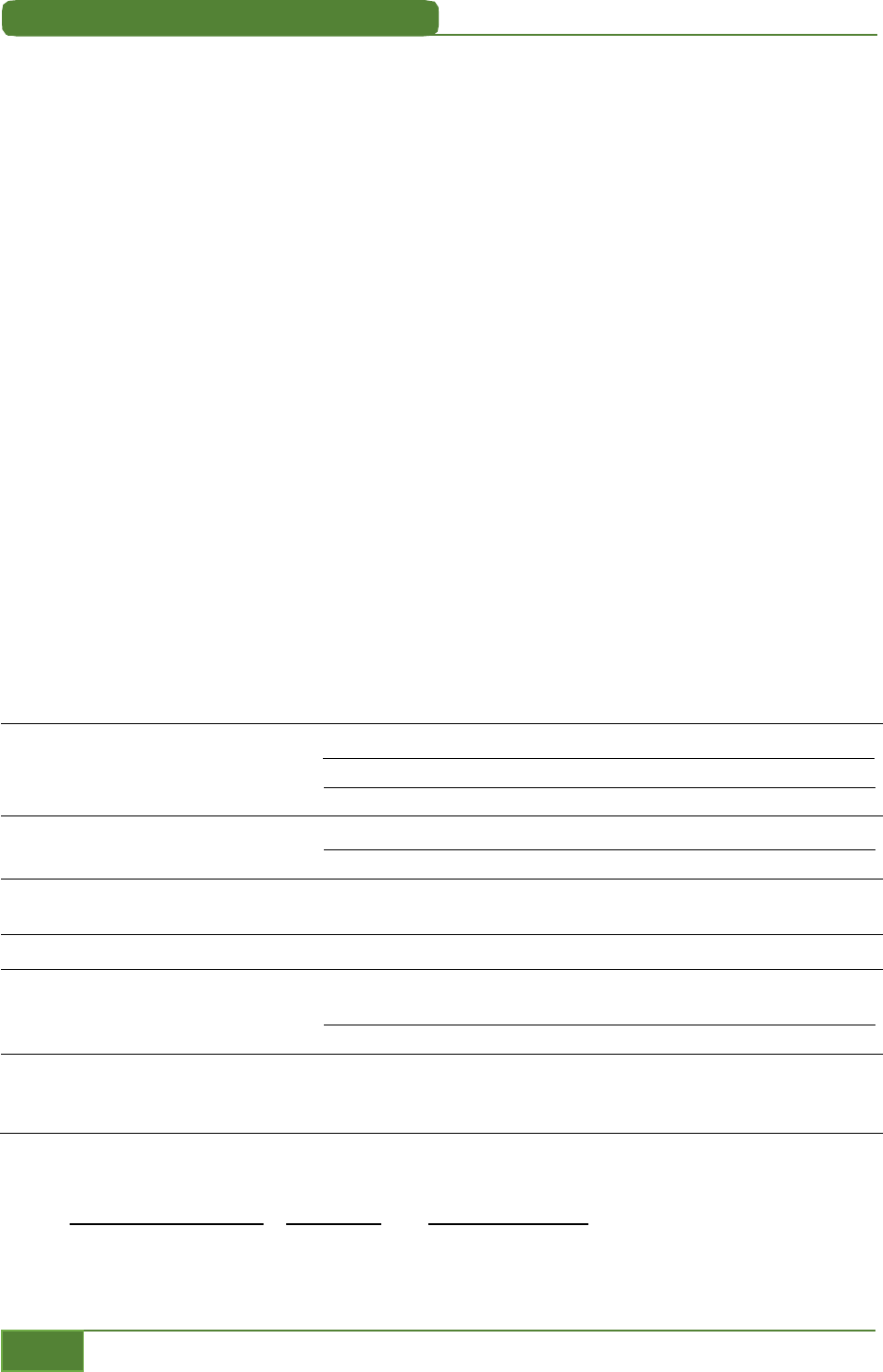
6. Notification of Change
Green Book
6-3
A Guide to Federal Government ACH Payments
Processing Timeframes
Generally, CORs will be processed for the next ACH transaction. Due to operational limitations, it
may take two payment cycles for some CORs to be processed.
What to do if an agency does not respond to a COR within two payment
cycles:
•
Verify that the COR was properly formatted. Make sure that the COR contained the correct
original RDFI routing number.
•
If the COR was correctly formatted, contact Fiscal Service. See Contact information below. Fiscal
Service will work with the agency for resolution.
•
Make sure that rejected CORs are acknowledged and resolved (See below).
If you have any questions, contact the Fiscal Service Payment Management Call Center, at
855-868-0151, Option 1.
Change Reason Codes
The federal government’s disbursing systems are only able to process the following six authorized
COR/Change codes: C01, C02, C03, C05, C06, and C07. The federal agencies will not process any
others.
The following table shows when to use the Change Reason Codes.
Change Reason Code
When to Use
C01 - Incorrect Account Number Correct data entry errors in the account information.
Issue a new number to an existing account.
Modify the account numbering system (e.g. to drop a branch code).
C02 - Incorrect RTN Accommodate a merger or system consolidation.
Change the RTN to the preferred RTN for the financial institution.
C03 - Incorrect RTN and Incorrect
Account Number
Accommodate a merger or system consolidation.
C05 - Incorrect Transaction Code Change from checking to savings or savings to checking.
C06 - Incorrect Account Number
and Incorrect Transaction
Code
Correct a data entry error in the account information and change
from checking to savings or savings to checking.
Issue a new account number and transaction code.
C07 - Incorrect RTN, Incorrect
Account Number and
Incorrect Transaction Code
Accommodate a merger or system consolidation.
Note: The only Transaction Codes recognized by the federal government for CORs are:
For checking (demand)
For savings
For General Ledger
22 (credit)
27 (debit)
32 (credit)
37 (debit)
42 (credit)
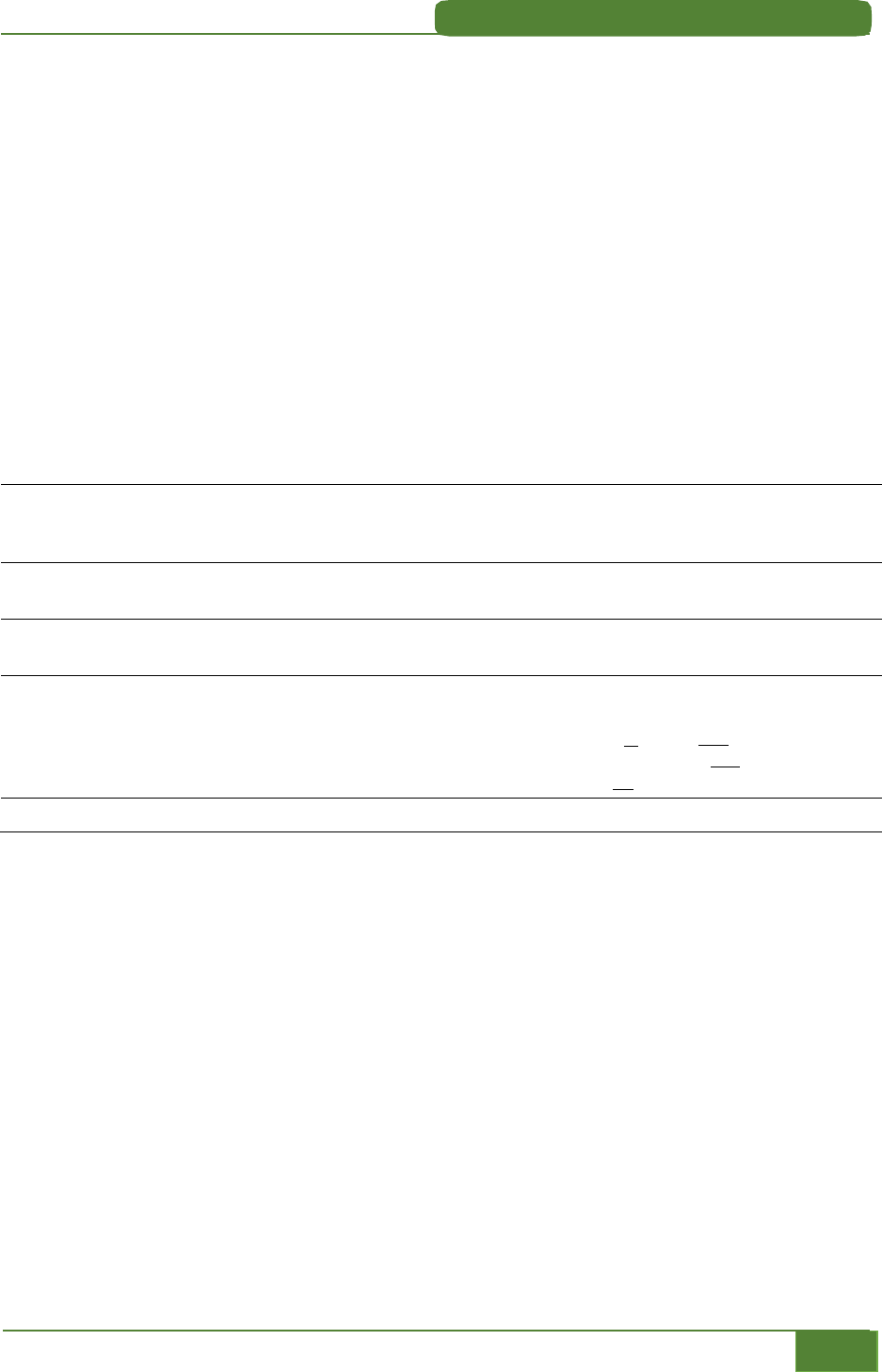
6. Notification of Change
Green Book
6-4
A Guide to Federal Government ACH Payments
Claim Number Structure
Federal agencies have special structures for their claim numbers (Individual ID number). The claim
number is important to identifying the payment recipient whose payment information must be
changed.
Accurate formatting of the claim number is critical for processing changes. Note that pattern
differences exist between federal agencies. These claim numbers must include all spaces, hyphens,
prefixes, suffixes, alphanumeric characters, and trailing or leading zeros that accompanied the
original payment information.
Claim Number Structure Table
The following table represents correct claim number structures used in formatting CORs.
Agency
Claim Number Structure
Example
Social Security Administration 999999999XX
999999999X
999999999
123456789C1
123456789A
123456789
Office of Personnel Management Xb9999999bXb
Xb9999999b9b
F_1234567_W_
A_1234567_0_
Department of Veterans Affairs
999999999b99b99
99999999b99b99
162306890_10_01
12345678_00_06
Railroad Retirement Board
Retirement/Annuity
Unemployment/Sickness
XXX999999999b9b
Xbb999999bbbb9b
XXbZZZZZ9bbbb9b
bbb999999999
WCA123456789_7_
A 123456 1_
WD_000006 8_
123456789
Department of Labor 999999999XXbXXb 123456789LW_MB_
Key: X = alphanumeric, 9 = numeric, b = blank, Z = zero filled, _ = space
B: Other Change Methods
Financial institutions not using CORs may continue to submit:
•
corrected Direct Deposit Sign-Up Forms (FS Form 1199As) to federal agencies, or
•
letters to federal agencies requesting changes.
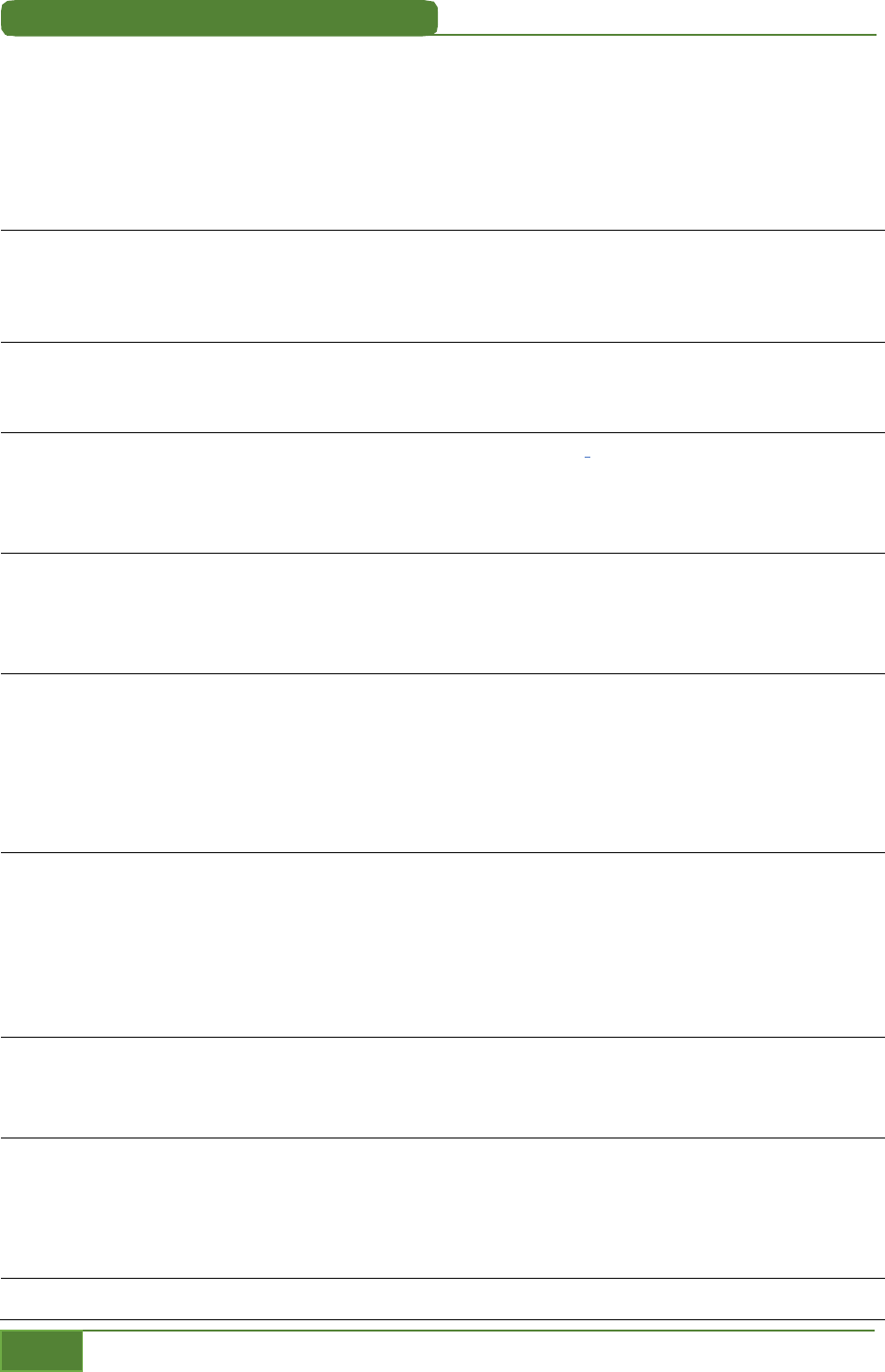
6. Notification of Change
Green Book
6-5
A Guide to Federal Government ACH Payments
Financial Institution Actions
The table below contains instructions for financial institutions not using CORs.
Type of Payment
Fewer than 100 payments
(mail corrected SF119As or letters)
More than 100
payments (call)
Air Force
Active Duty Reserve
Air National Guard
Active Duty Allotments
Defense Finance and Accounting Service
6760 E. Irvington Place
Building 444/JMS
Denver, CO 80279-3000
(303) 676-4326
(303) 676-7213
Army
Active Duty Reserve
Active Duty Allotments
DFAS - Indianapolis Center
8899 E. 56th Street
Indianapolis, IN 46249-2801
(888) 332-7411
Coast Guard
Active Duty (Code PS)
Reserves (Code RES)
Retired (Code RPD)
Commanding Officer (Code )
US Coast Guard
Pay and Personnel Center
444 SE Quincy Street
Topeka, KS 66683-3591
(785) 339-3506
Department of Veterans Affairs
Veterans Compensation, Pension or Education
(MGIB)
Veterans Life Insurance
VA Regional Office that maintains the
veteran’s records
(877) 838-2778
(215) 842-2000
ext. 14270
Fiscal Service
Federal Housing Administration
Debenture Payments
State and Local Government Series Securities
Payments
United States Mortgage Guaranty Insurance
Company and Tax Loss Bonds Payments
Bureau of the Fiscal Service
Special Investments Branch Warehouse
and Operations Center, Dock 1
257 Bosley Industrial Park Drive
Parkersburg, WV 26101
(304) 480-5299
TreasuryDirect
Bureau of the Fiscal Service
Treasury Retail Securities Services
P.O. Box 9150
Minneapolis, MN 55480-9150
(844) 284-2676
Note: Financial institutions should submit systemwide changes to TreasuryDirect with the understanding that they agree to
pay the Treasury and security owners for any losses resulting from errors made by the institution. (31 CFR part 370.12)
Savings Bonds
Federal Reserve
Bank of Pittsburgh
P.O. Box 299
Pittsburgh, PA 15230-0299
(800) 322-1909
Federal Salary and Allotment payments
Federal salary and Allotment payments
(including payments by the military to civilian
employees) (FED SALARY)
Federal employing agency authorizing the payment (address
where original FS Form 1199As were mailed). If address is
unknown, contact recipient/member.
Marine Corps
DFAS - Kansas City Center
(888) 332-7411
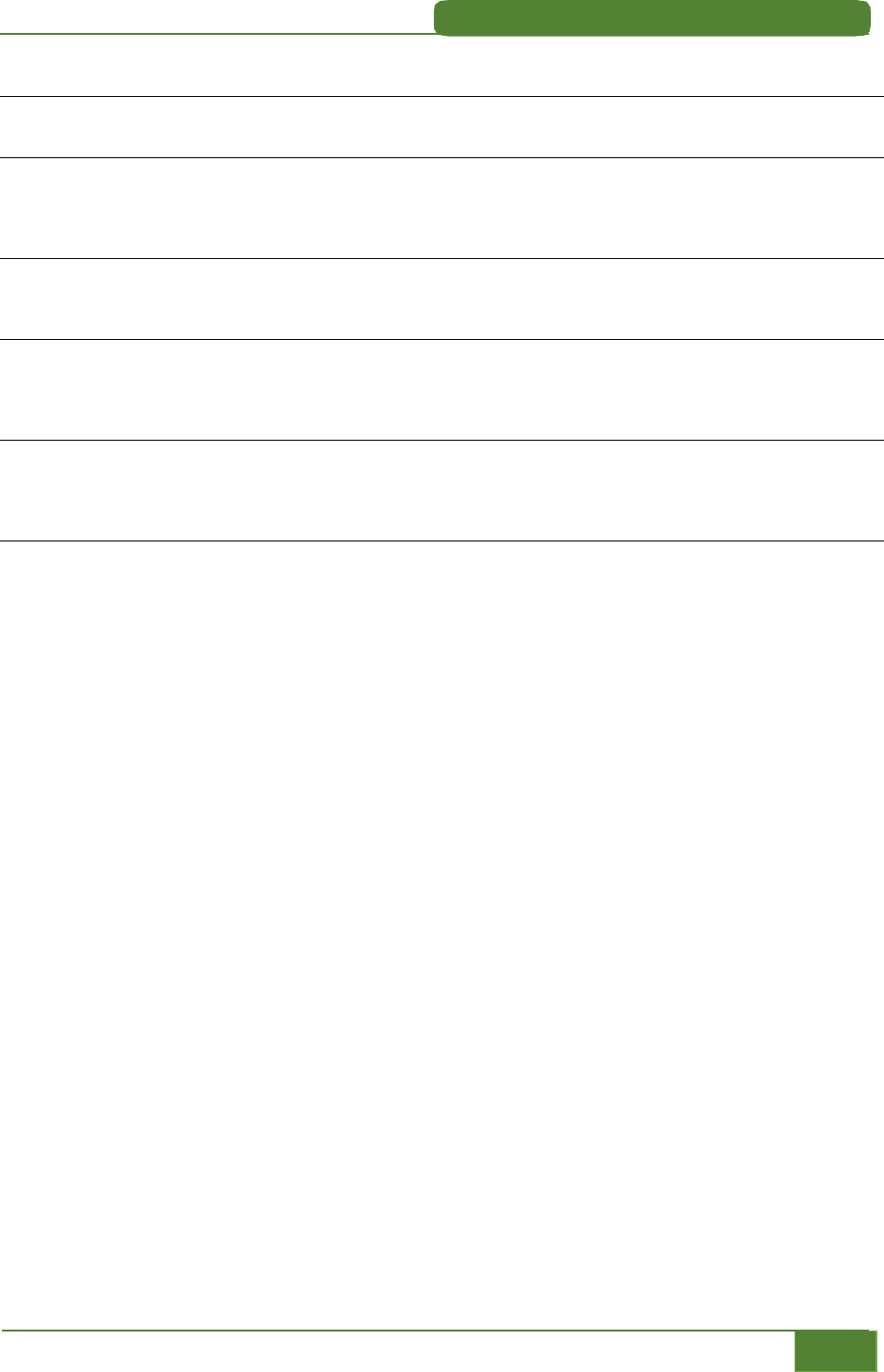
6. Notification of Change
Green Book
6-6
A Guide to Federal Government ACH Payments
Type of Payment
Fewer than 100 payments
(mail corrected SF119As or letters)
More than 100
payments (call)
Active Duty/Reserve
Active Duty Allotment
1500 E. 95th Street
Kansas City, MO 64197-0001
Military Retirement Pay
Army, Air Force, Navy and Marine Corps
DFAS - Cleveland Center Retired Pay
Operations
P.O. Box 99191
Cleveland, OH 44199-1126
(800) 321-1081
fax: (800) 469-6559
DC Metro Area ONLY:
(202) 606-0500
Navy
Active Duty
Reserve
DFAS - Cleveland Center/JFECA
1240 East Ninth Street
Cleveland, OH 44199-2055
(216) 522-5855
Office of Personnel Management
Civil Service Retirement
(Annuity)
(CIVIL SERVE)
Office of Personnel Management
Retirement Operations Center
P.O. Box 45
Boyers, PA 16017
(888) 767-6738
fax: (724) 794-6633
Railroad Retirement Board
Railroad Retirement
(RR RET)
Railroad Retirement Board
Direct Deposit Coordinator
844 North Rush Street
Chicago, IL 60611
(312) 751-4704
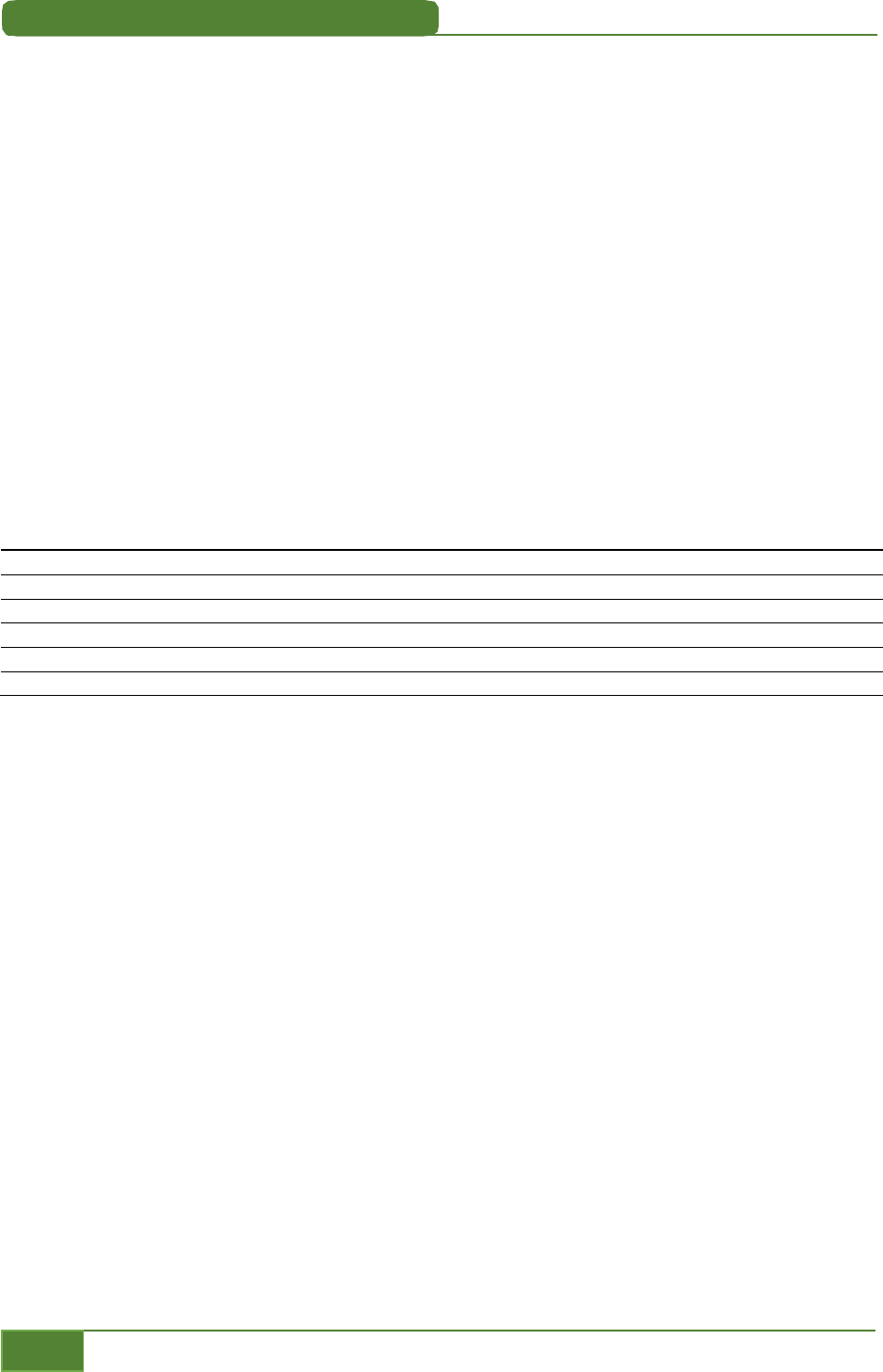
6. Notification of Change
Green Book
6-7
A Guide to Federal Government ACH Payments
C: Refused Notification of Change
Refused Notification of Change is an automated method used by a federal agency to notify the
originating financial institution that the COR information initiated cannot be processed.
Federal Agencies Using Refused CORs
The Social Security Administration (SSA), the Railroad Retirement Board (RRB), and the Office of
Personnel Management (OMB) are the only federal agencies processing Refused CORs at this time.
Processing Timeframes
CORs that cannot be processed are usually refused to the financial institution before the next
payment is submitted.
Refused COR Codes
There are six refused COR codes authorized for federal government ACH entries:
Code
Reason
C64 Incorrect individual identification
C65
Incorrectly formatted corrected data
C66
Incorrect discretionary data
C67 Routing Transit Number not from original Entry Detail Record
C68 DFI Account Number not from original Entry Detail Record
C69
Incorrect Transaction Code

7-1
A Guide to Federal Government ACH Payments
7
Contacts
Overview
In this chapter…
A: Fiscal Service Payment Management Call Center .......................................................................... 7-2
B: EFTPS Assistance....................................................................................................................................... 7-2
C: Major Paying Agency Contacts .............................................................................................................. 7-2
D: Defense Finance and Accounting Service (DFAS) Contacts ........................................................ 7-3
E: Go Direct Contact Information .............................................................................................................. 7-3
F: Treasury Offset Program ........................................................................................................................ 7-3
This chapter includes addresses and/or phone numbers of ACH contacts. These contacts are
provided to handle any problems or questions that you may have concerning ACH payments and
collections.
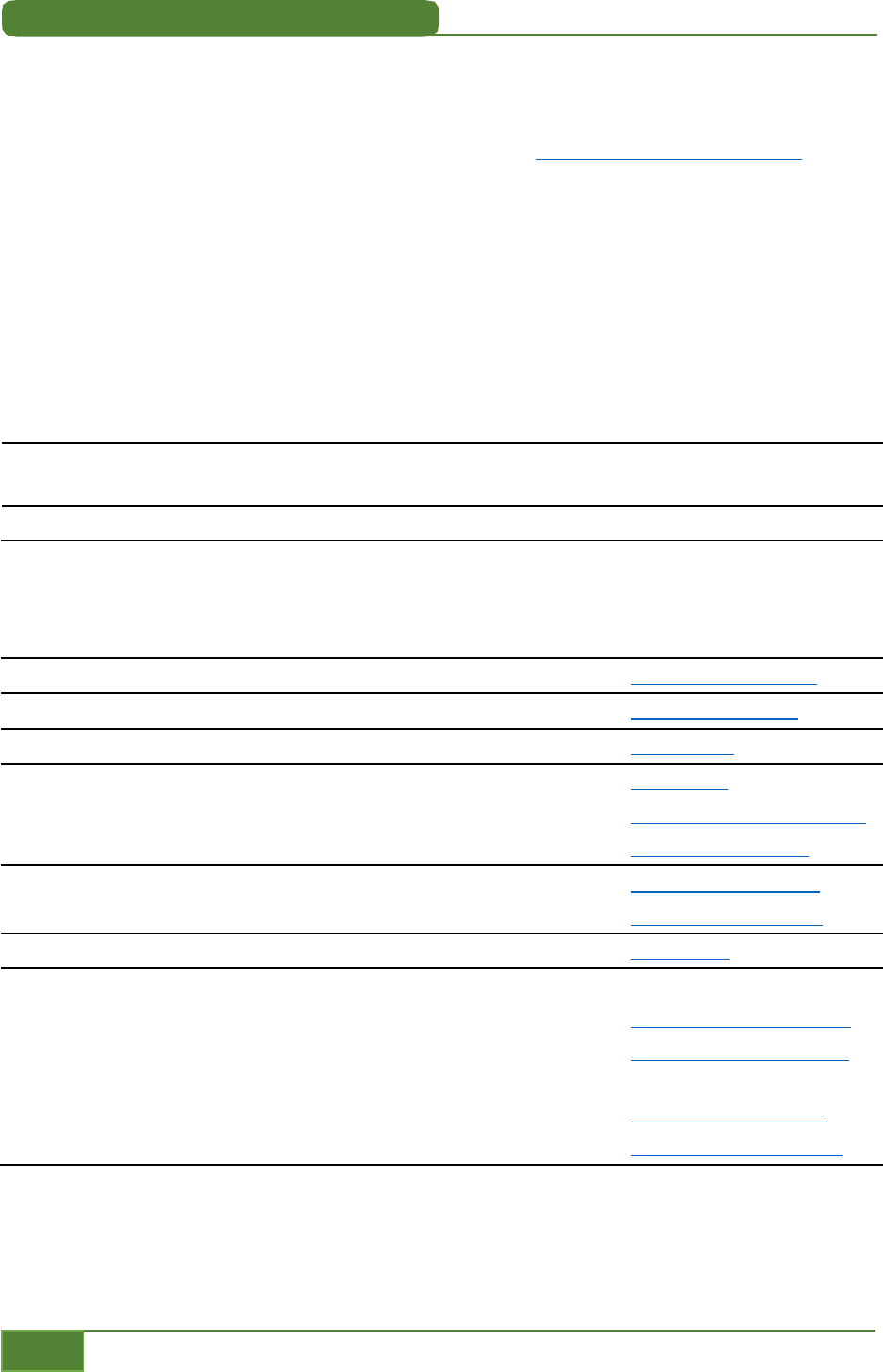
7-2
A Guide to Federal Government ACH Payments
7. Contacts
Green Book
A: Fiscal Service Payment Management Call Center
For assistance with a payment issued by Treasury, please contact the Fiscal Service Payment
Management Call Center at: 1 (855) 868-0151 or email us at Payments@fiscal.treasury.gov.
For payments issued by the Department of Defense, please see the Defense Finance and Accounting
Service (DFAS) Contacts section.
B: EFTPS Assistance
If a taxpayer is initiating federal tax payments using EFTPS—through a financial institution (ACH
credit) see below for the appropriate customer service helplines.
Routing Transit Number
061036000
Account Number 23401009
Taxpayer Enrollment/Helpline 1 (800) 555-4477 (Businesses)
1 (800) 316-6541 (Individuals)
Financial Institution Helpline 1 (800) 605-9876
C: Major Paying Agency Contacts
Agency
Contact
Website
Social Security Administration (800) SSA-1213 www.socialsecurity.gov
Office of Personnel Management www.opm.gov/retire
Railroad Retirement Board (877) 772-5772 www.rrb.gov
Department of Veterans Affairs (800) 827-1000 www.va.gov
Veterans Compensation, Pension & Education (800) 827-1000 www.benefits.va.gov/benefits
Veterans Life Insurance (800) 669-8477 www.insurance.va.gov
Bureau of the Fiscal Service (855) 868-0151 www.fiscal.treasury.gov
TreasuryDirect (844) 284-2676 www.treasurydirect.gov
Internal Revenue Service (800) 829-1040 www.irs.gov
Department of Labor
Black Lung (800) 638-7072 www.dol.gov/owcp/dcmwc
Division of Energy Employees
Occupational Illness Compensation
(866) 888-3322 www.dol.gov/owcp/energy
Division of Federal Employees’ Compensation (202) 693-0040 www.dol.gov/owcp/dfec
Longshore and Harbor Workers' Compensation (202) 693-0925 www.dol.gov/owcp/dlhwc

7. Contacts
Green Book
7-3
A Guide to Federal Government ACH Payments
D: Defense Finance and Accounting Service (DFAS) Contacts
For information about military retirement and annuitant payments, please contact 1-800-321-
1080. For additional information about payments disbursed by the military, please visit
www.dfas.mil.
E: Go Direct Contact Information
For information about Go Direct, please contact the U.S. Treasury Electronic Payment Solution
Center at 1 (877) 874-6347 or visit www.GoDirect.gov.
F: Treasury Offset Program
For information about the Treasury Offset Program, visit www.fiscal.treasury.gov/top/ .

9. Forms
Green Book
8-1
A Guide to Federal Government ACH Payments
8
Glossary
Actual or Constructive Knowledge
Under Title 31 CFR part 210, both agencies and RDFIs have obligations, rights and liabilities that
are triggered by actual or constructive knowledge of the death or incapacity of a recipient or death
of a beneficiary.
Actual or constructive knowledge, when used in reference to a federal agency’s or RDFI’s
knowledge of the death or legal incapacity of a recipient or death of a beneficiary, occurs when it
receives information, by whatever means, of the death or incapacity and has had a reasonable
opportunity to act on such information, or that the federal agency or RDFI would have learned of
the death if it had followed commercially reasonable business practices.
A federal agency is presumed to have constructive knowledge of a death or legal incapacity at the
time it stops certifying recurring payments to a recipient if the agency (1) does not re-initiate
payments to the recipient and (2) subsequently initiates a reclamation for one or more benefit
payments made to the recipient.
Agency
As defined in Title 31 CFR part 210, an agency is any department, agency, or instrumentality of the
United States Government, or a corporation owned or controlled by the Government of the United
States. The term agency does not include a Federal Reserve Bank (FRB).
Annuitant
An annuitant is a retired federal employee or their survivor who is receiving payments from the
Office of Personnel Management; a retired railroad employee, their spouse, or their survivor who is
receiving payments from the Railroad Retirement Board; a retired military service person, their
spouse or their survivor who is receiving payments from a military service.
Annuity
An annuity is a recurring payment made to a retired individual, their survivor or spouse.
Automated Clearing House (ACH)
As defined in Title 31 CFR part 210, ACH is a funds transfer system governed by Nacha, formerly
NACHA – The Electronic Payments Association, Operating Rules and Guidelines which provides for
the interbank clearing of electronic entries for participating financial institutions.

8. Glossary
Green Book
8-2
A Guide to Federal Government ACH Payments
ACH Non-Receipt Claim
An Automated Clearing House (ACH) non-receipt claim is a research method where a government
disbursing office representative will contact a financial institution, by telephone, email or facsimile
to resolve a payee’s claim that they did not receive an ACH payment.
Automated Clearing House (ACH) Rules
As defined in Title 31 CFR part 210, the Automated Clearing House (ACH) rules are the Operating
Rules and the Operating Guidelines published by Nacha, formerly NACHA – The Electronic
Payments Association, a national association of regional member clearing house associations, ACH
Operators and participating financial institutions located in the United States.
Automated Clearing House (ACH) 45-Day Amount
The Automated Clearing House (ACH) 45-day amount is the dollar amount of all the ACH payments
received within 45 calendar days following the death or legal incapacity of a recipient or the death
of a beneficiary.
Automated Enrollment (ENR)
An Automated Enrollment (ENR) is a non-monetary entry sent through the ACH by any Receiving
Depository Financial Institution (RDFI) to a federal government agency participating in the ENR
program for the purpose of transmitting Direct Deposit enrollment information.
Automated Standard Application for Payments (ASAP)
The Automated Standard Application for Payments (ASAP) is a recipient-initialized payment and
information system, designed to provide a single point of contact for the request and delivery of
federal funds.
Authorizing Agency
An authorizing agency is the federal agency that authorized the initiation of the payment.
Banking Day
With reference to a financial institution, a banking day is any day on which such financial institution
is open to the public during any part of such day for carrying on substantially all of its banking
functions, and, with reference to an Automated Clearing House (ACH) Operator, any day on which
the appropriate facility of such ACH Operator is being operated.
Beneficiary
As defined in Title 31 CFR part 210, a beneficiary is a natural person other than a recipient who is
entitled to receive the benefit of all or part of a benefit payment. To illustrate, in a situation where
there’s a representative payee, the representative payee is the recipient and the beneficiary is the
person on whose behalf the representative payee is managing the payment.
Benefit Payment
As defined in Title 31 CFR part 210, a benefit payment is a payment for a federal entitlement
program or for an annuity, including, but not limited to, payments for Social Security, Supplemental
Security Income, Black Lung, Civil Service Retirement, Railroad Retirement annuity and Railroad

8-3
A Guide to Federal Government ACH Payments
8. Glossary
Green Book
Unemployment and Sickness benefits, Department of Veterans Affairs Compensation and Pension,
and Worker’s Compensation.
Business Day
A business day is a calendar day other than a Saturday, Sunday, or a federal holiday.
Claim Number
A claim number is a number which identifies the recipient’s or beneficiary’s records at the federal
agency that authorizes the payment; often a SSN or an equivalent identification number.
Claim Number Prefix
A claim number prefix is a one or more alpha character(s) that precedes a claim number. These
letters indicate the type of claim for which benefits are being paid.
Claim Number Suffix
A claim number suffix is a one or two alphanumeric character that follows the claim number. These
characters indicate the type of claim for which benefits are being paid.
Corporate Credit or Debit Entry (CCD)
Corporate Credit or Debit Entry (CCD) is a corporate Automated Clearing House (ACH) format
consisting of one detailed payment record and one addenda record. The Fiscal Service uses this
format primarily to process vendor payments.
Corporate Trade Exchange (CTX)
A Corporate Trade Exchange (CTX) is a corporate Automated Clearing House (ACH) format
consisting of one detailed payment record with up to 9,999 addenda records. The CTX format is
used to transmit information in the American National Standards Institute (ANSI) X12 electronic
data interchange (EDI) syntax.
Death Notification Entry (DNE)
A Death Notification Entry (DNE) is a notice to a Receiving Depository Financial Institution (RDFI)
of the death of a Receiver. Only a federal government agency may originate a DNE entry.
Direct Deposit
Direct deposit is an electronic funds transfer made through an ACH credit entry to a checking or
savings account.
Discretionary Allotment
A discretionary allotment is an amount permitted by the employing federal agency to be deducted
from a federal government employee’s net salary amount and paid to a recipient. The amount of
discretionary allotments may not exceed the net pay due the employee for each pay period after all
deductions required by law are subtracted.

8. Glossary
Green Book
8-4
A Guide to Federal Government ACH Payments
Effective Entry Date
An effective entry date is the date specified by the originator (authorizing agency) on which it
intends a batch of entries to be settled. For debit entries, the effective entry date is one banking day
following the processing date.
Electronic Federal Tax Payment System (EFTPS)
The Electronic Federal Tax Payment System (EFTPS) is a system through which taxpayers remit
federal tax payments electronically.
FastStart
FastStart is an abbreviated Standard Form (SF) 1199A form used to enroll and/or make changes to
Direct Deposit information.
Federal Payment
As defined in Title 31 CFR part 210, a federal payment is any payment made by an agency. The term
includes, but is not limited to:
(1)
federal wage, salary, and retirement payments;
(2)
vendor and expense reimbursement payments;
(3)
benefit payments; and
(4)
miscellaneous payments including, but not limited to, interagency payments; grants; loans; fees;
principal, interest, and other payments related to United States marketable and nonmarketable
securities, overpayment reimbursements; and payments under federal insurance or guarantee
programs for loans.
Federal Reserve Bank (FRB)
A Federal Reserve Bank (FRB) is a regional bank of the Federal Reserve System, which serves as the
nation’s central bank. FRBs serve as fiscal agents of the federal government’s fiscal agent, process
electronic payments for the federal government, and handle federal government deposits and
checks.
Financial Institution
As defined in Title 31 CFR part 210, a financial institution is a bank, savings bank, saving and loan
association, credit union or similar institution.
Flagging
Flagging is the automated marker on an account indicating that one or more account holders is
deceased, and that all future federal payments for that account should be returned.
Financial Organization Master File (FOMF)
A Financial Organization Master File (FOMF) is a master list of financial institutions receiving
federal government Automated Clearing House (ACH) payments. It contains routing numbers
(RTNs) and a single financial institution name and mailing address for each RTN.
Government Entry
A defined in Title 31 CFR part 210, a government entry is an Automated Clearing House (ACH)
credit or debit entry or entry data originated or received by an agency.

8-5
A Guide to Federal Government ACH Payments
8. Glossary
Green Book
Government Disbursing Office
A government disbursing office is a federal government office that disburses payments on behalf of
an authorizing federal agency.
Legal Incapacity
Legal Incapacity is a legal declaration that an individual is unable to manage their affairs properly.
Limited Liability Amount
The sum of the account balance and the Automated Clearing House (ACH) 45-day amount. The
limited liability amount is the financial institution’s liability for benefit payments if funds have been
withdrawn from the account after the death or legal incapacity of a recipient or death of a
beneficiary, and the financial institution meets all requirements for limiting its liability. This
amount may not exceed the outstanding total.
Lockbox
A lockbox is a collection and processing service provided by a financial agent that accelerates the
flow of funds to Treasury's General Account, and processes associated data. This service includes
collecting the agency's mail from a specified post office box; opening envelopes, extracting, sorting,
and batching the envelope contents; scanning and capturing required data from payment
instruments and remittance documents; balancing and totaling batches; recording the payments;
processing the items; making the deposit; and transferring the funds. Agencies receive remittance
data either in hard copy or via electronic format.
Misdirected Payment
A misdirected payment occurs when an agency has originated an ACH credit entry to an account that is
not owned by the payee whose name appears in the ACH payment information.
N
acha
Nacha is a membership association (previously known as the "NACHA – The Electronic Payments
Association") which manages the development, administration, and governance of the Automated
Clearing House (ACH) network used by financial institutions nationwide.
Notice of Reclamation
As defined in Title 31 CFR part 210, a notice of reclamation is a notice sent by electronic, paper, or
other means by the federal government to a Receiving Depository Financial Institution (RDFI)
which identifies the benefit payments that an agency originated after death or legal incapacity of a
recipient or death of a beneficiary, and for which the financial institution may be wholly or partially
liable.
Originating Depository Financial Institution (ODFI)
The Originating Depository Financial Institution (ODFI) is the financial institution which delivers
Automated Clearing House (ACH) entries directly or indirectly through a third party to its ACH
Operator.
Outstanding Total
As defined in Title 31 CFR part 210, an outstanding total is the sum of all benefit payments received
by a Receiving Depository Financial Institution (RDFI) from an agency after the death or legal
incapacity of a recipient or the death of a beneficiary, minus any amount returned to, or recovered
by, the federal government.

8. Glossary
Green Book
8-6
A Guide to Federal Government ACH Payments
Prearranged Payment and Deposit (PPD)
Prearranged Payment and Deposit (PPD) is the Automated Clearing House (ACH) format used by
the federal government for consumer payments.
Reclamation
A reclamation is a procedure to recover from a financial institution the amount of federal
government recurring benefit payments that were paid to a financial institution’s customer through
the automated clearing house (ACH) after the death or legal incapacity of a recipient or the death of
a beneficiary.
Receiving Depository Financial Institution (RDFI)
For the purposes of the Green Book, Receiving Depository Financial Institution (RDFI) is the
financial institution that receives the payment.
Recipient
As defined in Title 31 CFR part 210, a recipient is a natural person, corporation, or other public or
private entity that is authorized to receive a federal payment from an agency.
Representative Payee
A representative payee is a person or institution authorized by an authorizing federal agency to
accept payments for the benefit of one or more other persons, such as legally incapacitated adults
or dependent children.
Third-Party Processor/Third-Party Service Provider
A third-party processor or third-party service provider is a company that receives and processes
Automated Clearing House (ACH) transaction data for a financial institution.
Trace Number
A trace number is a fifteen-digit number assigned by the Originating Depositary Financial
Institution (ODFI) to uniquely identify an Automated Clearing House (ACH) entry. The first eight
digits are the ODFI’s routing number, and the last seven digits are the unique item number. The
trace number is part of the original payment data forwarded to the financial institution and is
included in each Entry Detail, Corporate Entry Detail, and Entry Detail Addenda Record.
Trace Request (FS Form 150.1)
A trace request is a form sent by the government disbursing office to a financial institution
reporting a n
on-receipt claim by a payee for an Automated Clearing House (ACH) payment.
TreasuryDirect
TreasuryDirect is a book-entry securities system in which investors’ accounts of book-entry
Treasury marketable securities are maintained. It is designed for investors who purchase Treasury
securities and intend to hold them until maturity.

8-7
A Guide to Federal Government ACH Payments
8. Glossary
Green Book
Tr
easury Financial Manual
As d
efined in Title 31 CFR part 210, the Treasury Financial Manual (TFM) is a manual issued by the
Fiscal Service containing procedures to be observed by all agencies, Federal Reserve Banks (FRB),
and financial institutions with respect to payments, collections, central accounting, financial
reporting, and other government-wide fiscal responsibilities of the Treasury.
Vend
or Payment
A vendor payment is the electronic transfer of funds and payment-related information used by the
federal government for payments to businesses that provide goods and services.

9-1
A Guide to Federal Government ACH Payments
9
Forms
This Chapter includes all Green Book forms.
Appendix #
Form
Title
1. FS Form 133 Notice of Reclamation Form
2. FS Form 150.1 Payment Trace Request Form
3. FS Form 1199A Direct Deposit Sign-Up Form
4. FS Form 1200 Direct Deposit Sign-Up Form
5. FS Form 2942 Follow-Up To Notice of Reclamation
6. SF 3881 ACH Vendor/Miscellaneous Payment Enrollment Form
